Archived Blog Posts
How Small Water Leaks Can Cause Big Problems
6/8/2022 (Permalink)
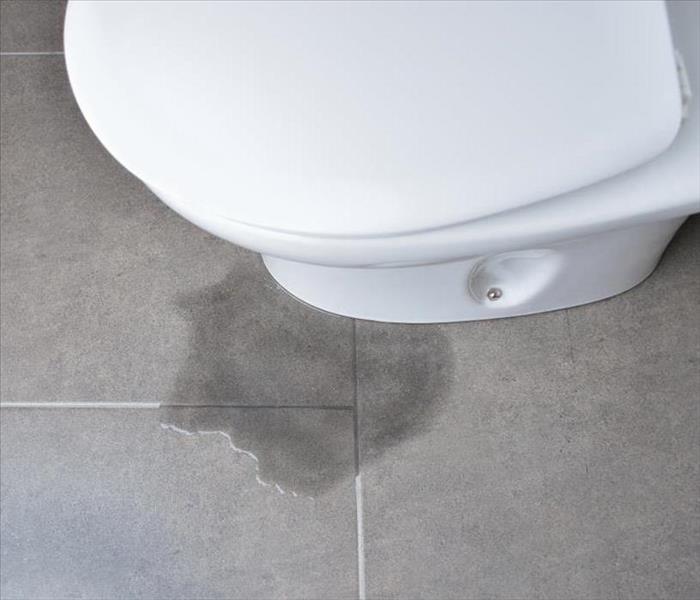 If you suspect a leak in your toilet, contact a plumber to remove the toilet and see if they need to replace the flooring and subfloor around it
If you suspect a leak in your toilet, contact a plumber to remove the toilet and see if they need to replace the flooring and subfloor around it
How Small Water Leaks Can Create Major Issues
If you've noticed that your water bill has gone up in the last few months and your Seattle, WA, company's water usage hasn't, you want to look for a water leak. Even a tiny leak can cause a tremendous amount of damage when left alone for long enough. Here are some ways water leaks can cause a lot of damage.
Small Pipe Break
It's natural for pipes to wear down over time, so you want to ensure you have a plumbing company regularly evaluate your entire system. If you're worried you have a leak in a pipe in your walls, look for:
- Bubbling and discolored drywall
- Patches of mold on the wall
- Musty smell in the room
When you start to see signs of a pipe leak, you'll want to immediately call a plumber to address the problem. If the water leak has been happening long enough, you might need a water damage repair company to correct the issue.
Leaking Toilet
You could have a leaking toilet and not know it for years. The wax seal on your toilet often begins to wear away and lets small amounts of water slip out around the toilet's base. You will notice a problem when the floor feels soft around the toilet or you are constantly cleaning mold around the bottom of the toilet. If you suspect a leak in your toilet, contact a plumber to remove the toilet and see if they need to replace the flooring and subfloor around it.
Dripping Sink
A sink has multiple places it could leak from and cause problems. The faucet or handles could slowly leak and leach water into the countertops. Or, the water supply line or pipes could drip, destroying the cabinet the sink sits in. If you notice standing water under the cabinet or spongy, soft countertops, contact a professional to address the problem.
A water leak can be a pain to deal with and can cause a lot of damage. However, when you know what signs to look for and rely on the professionals, you'll find that things are much easier to handle.
Filing a Mold Claim
5/27/2022 (Permalink)
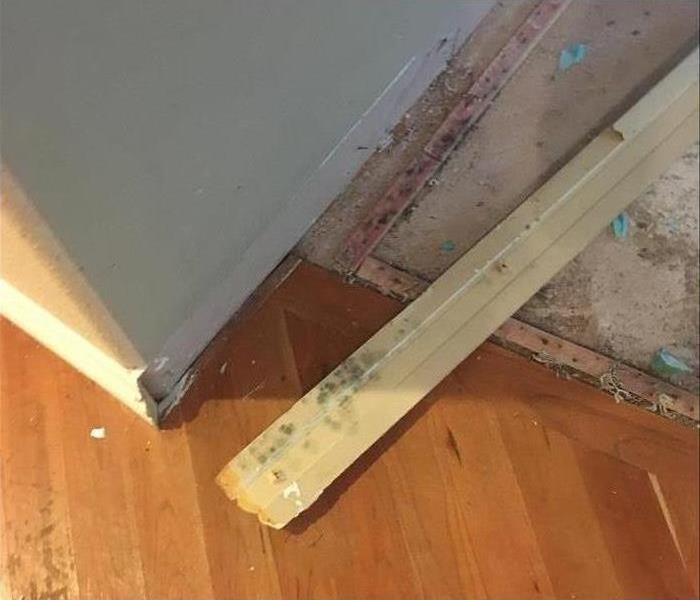 Mold was found behind the baseboard.
Mold was found behind the baseboard.
Filing a Mold Insurance Claim
Savvy business owners in Broadview, WA, know the importance of having commercial insurance. While it is essential, it is also important to thoroughly understand what the policy covers. That is especially vital when faced with a mold problem. Although you can rely on a mold remediation and restoration company to take care of the problem, filing a mold insurance claim may not always go smoothly or be accepted.
Typical Coverage
Damage from fungi seems to be an ever-changing part of insurance coverage. In most cases, commercial insurance will not accept claims for damage caused by neglect, such as avoiding a lingering water leak or persistent high humidity issues. If a pipe burst or other unexpected water infiltration causes mold growth, coverage for a claim may include:
- Direct loss of covered property due to fungi
- Mold removal
- Replacement of materials to access hidden growth
- Testing after remediation
Prevention Tips
Although spores are everywhere, they need the right conditions to grow. If they have moisture, warm temperatures and nutrients, which include drywall and wood, they will flourish. Mold damage may not always be something that is completely avoidable but taking a few preventive steps may minimize the chances of that happening.
Immediately address any water issues. Even a slow leak may lead to the right conditions for a colony to grow.
Regularly inspect the roof, vents, seals and drainage to ensure moisture isn’t collecting. If a wet spot is found, make a prompt repair.
If faced with high humidity, boost indoor ventilation and install a dehumidifier.
Schedule an annual HVAC inspection. Air ducts are a prime location for mold to thrive. It is also important to check any condensation pans for excessive buildup.
Maintaining commercial insurance is important, but it does not always equal the acceptance of the claim. Understanding your policy and taking preventive measures are ways to make the process smoother.
3 Important Actions To Take If Your Flight Is Canceled
5/22/2022 (Permalink)
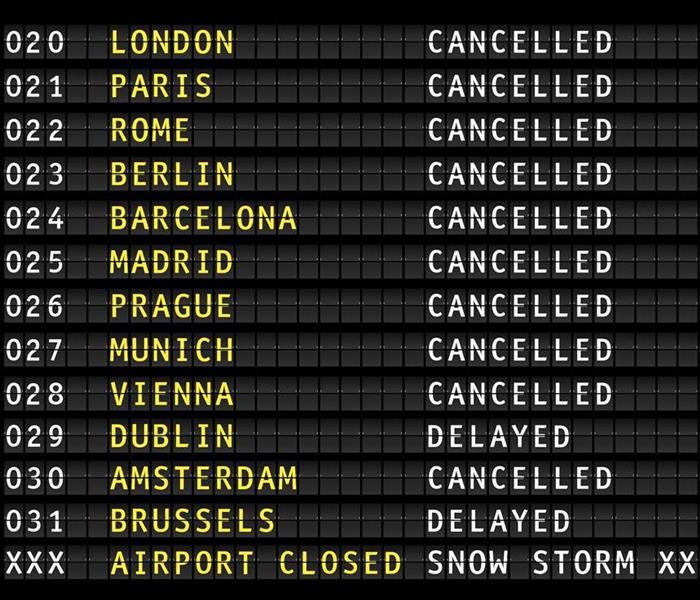 A canceled flight can derail your plans, especially if you are heading home.
A canceled flight can derail your plans, especially if you are heading home.
Storm Tips
A suddenly canceled flight due to a dangerous storm is a stressful situation, especially if you hoped to fly back to your home in Wallingford, WA. Despite the impact of the situation, you will need to act fast and adapt to ensure you get home quickly and safely. Keep the following storm tips in mind during a surprise cancelation.
1. Contact the Airline Company Fast
Once you find out about the cancelation, you should not waste time contacting the airline company since you will not be the only one searching for answers and scheduling a new flight. Ideally, you should read about the company's cancelation policies before making your trip plans, but a quick online browse can clear your doubts before communication. If the gate agent's line is long, call the company directly for a faster resolution.
2. Consider Canceled Flight Compensation
Most companies will offer some form of compensation after a flight cancelation. Under federal law, if you choose to no longer travel, you are entitled to a full refund regardless of circumstances. Otherwise, your choices can vary depending on the airline. Most offer assistance with the rescheduling process at no additional cost, while many others can offer money vouchers, paid hotel stays, or travel credit. Always ask for compensation since most airlines do not offer it immediately.
3. Find Ways To Rest and Relax
The surprising cancelation of your trip can be distressing, especially when caused by dangerous weather. Still, there is little you can do to change the situation, so relax and make the next moves calmly. By tempering your emotions, you can treat staff politely and increase your chances at receiving better help. Sit in a comfortable place and grab a snack or drink to improve your mood. See if your airline can provide a free hotel night if your wait is longer than expected.
A canceled flight can derail your plans, especially if you are heading home. Act fast with the right strategies and remember that storm damage restoration can help if anything happens to your house.
3 Fire Prevention Tips for a Company
5/17/2022 (Permalink)
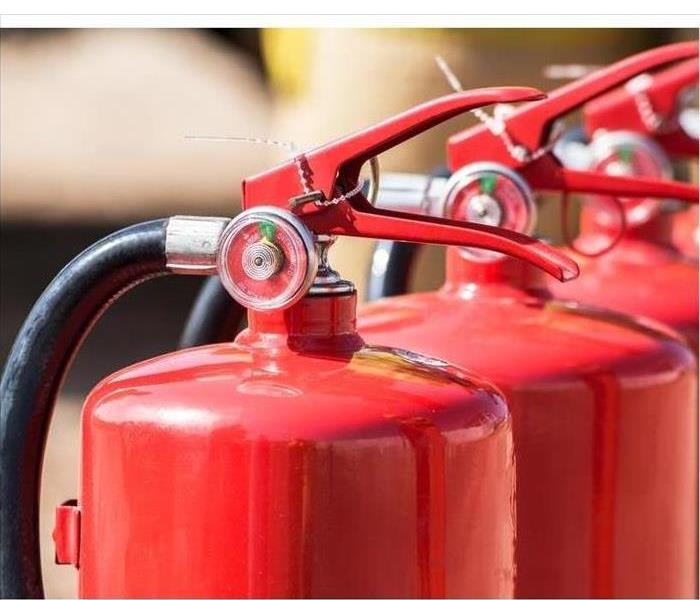 Invest in fire prevention.
Invest in fire prevention.
Commercial Fire Preparation
Planning for fire prevention is one of the smartest things your company can do. It could stop a fire before it gets started or it could significantly reduce the financial damages from a fire. While your small or medium-sized business in Fremont, WA, is a unique entity, it can likely benefit from these universal principles when it comes to commercial fire preparation
1. Accurately Assess Your Company's Risk Profile
While all commercial businesses are at risk of a fire, the risk level is not the same for each company. An office building is probably at low risk, while a warehouse that stores flammable materials is at a much greater risk of a business fire. Therefore, it makes sense to assess your company's risk profile and take appropriate actions such as upgrading insurance coverage or developing a detailed evacuation plan.
2. Invest in Fire Prevention
Depending on your company's risk profile, you should calculate the right amount of money to put into fire protection. A small company with low risk should still install fire alarms and carry fire extinguishers. Some of these actions will be required by OSHA. A larger facility with moderate or high risk should consider installing a fire sprinkler system.
3. Develop a Relationship With a Recovery Team
A nearby fire mitigation team can help reduce fire damage after the flames have been put out. Trained technicians will arrive quickly and perform vital services such as water removal, roof coverage, cleanup and restoration work. Specializing in fire and water damage, these experts can usually make it to your location in under two hours. As a preferred vendor for many insurance companies, the right franchise will itemize damages and services, allowing more prompt payments on your claims.
For all companies, fire prevention plays a crucial role in keeping a business strong. A smart plan can reduce damage and speed up recovery.
How To Prevent an Out-of-Control Mold Infestation
4/20/2022 (Permalink)
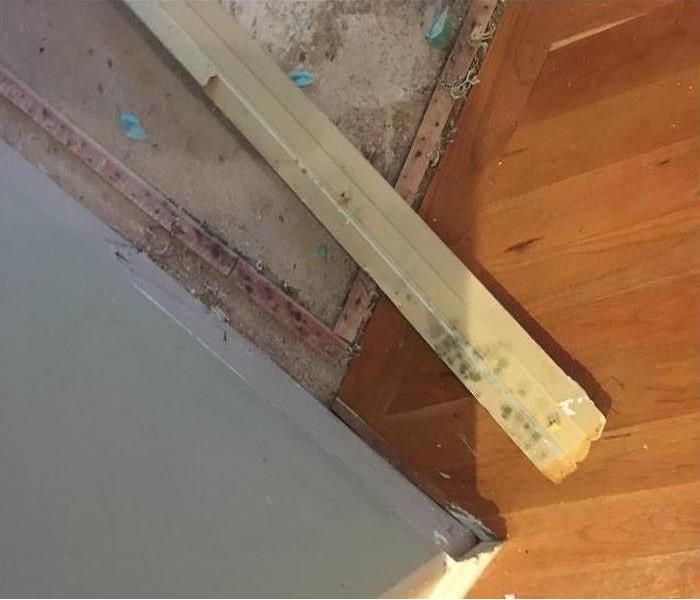 If you think your property might suffer from mold damage, let our SERVPRO team make it "Like it never even happened."
If you think your property might suffer from mold damage, let our SERVPRO team make it "Like it never even happened."
How to Prevent a Mold Infestation From Getting Out of Hand
As a commercial property owner or manager, you have many jobs to juggle. This includes limiting or fixing damage to the premises. Mold is a particularly common cause of harm in commercial buildings.
The invisible spores can spread through the air and grow on organic surfaces. While mold removal services are available, you can save money by stopping the mold infestation before it starts. Here are some ways to prevent a mold problem from getting out of control.
1. Decrease Moisture
Mold grows quickly in dark and wet areas. You should thus limit the amount of moisture in the air. You can do this by installing fans and dehumidifiers throughout the property
2. Keep the HVAC System Clean
Mold often hides in the vents of your building. The spores can then spread into the air whenever you turn on your heater or air conditioner. To prevent this, clean the HVAC system regularly. If you do suspect that the spores have gotten into the vents, call mold removal experts.
3. Know the Signs
To prevent a mold problem from getting out of hand, you need to spot the spores when they first start to grow. Hold regular inspections and focus on wet areas such as crawl spaces and basements. Musty smells and fuzzy stains could be evidence of a mold issue.
Of course, finding the mold is only the first step. Once you suspect that the fungus is starting to grow, contact local commercial mold cleanup professionals. They will be able to remove the mold safely.
Because mold grows quickly, what appears to be a small patch of the fungus can quickly spread throughout your building. To prevent the need for mold removal services, you should keep your Greenlake, WA property dry and clean the vents. If you do find signs of mold on the premises, contact mold remediation specialists who can quickly address the issue.
3 Helpful Tips When Creating Business Evacuation Drills
4/13/2022 (Permalink)
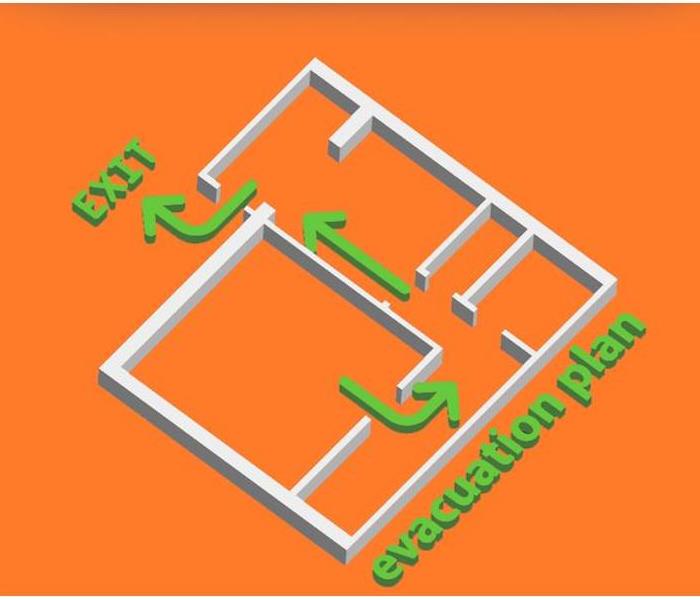 A fire drill or evacuation plan is as essential to your Seattle, WA business as insurance or an emergency restoration service at hand.
A fire drill or evacuation plan is as essential to your Seattle, WA business as insurance or an emergency restoration service at hand.
Three Points to Consider When Planning Business Evacuation Drills
A fire drill or evacuation plan is as essential to your Seattle, WA business as insurance or an emergency restoration service at hand. It helps your employees make decisions that protect them. It is also a multilayered operation that must consider multiple factors and the perspectives of everyone in the work team. These tips can help you create a thoughtful and successful plan.
1. Consider Multiple Perspectives
Since your team works in different parts of your establishment, they will all have varying experiences when performing a drill. Some employees might have an easier time escaping via a specific route than others. Include representatives from each department to agree on a drill plan that benefits everyone. Additionally, employees with special needs might need additional assistance when evacuating, such as breathing equipment, wheelchair-accessible exits, and designated helpers. Ensure these resources are available to anyone who needs them.
2. Establish Clear Communication
Staff and clients need to act fast during a dangerous situation, so it is important to communicate fire drill directions clearly. The best way to direct evacuees towards safe locations is by placing signage that points towards the correct path and the eventual exit, in addition to alternatives if the main exit is blocked. Communicate these routes and practice them with the workers until they memorize them. Teach your employees other useful skills such as guiding others during evacuation, using a fire extinguisher, and reporting an incident.
3. Pace the Frequency of the Drills
Evacuation practices are meant to prepare your team against any emergency. While you might want to practice often, this decision can actually backfire. Excessively frequent drills can cause your workers to become complacent or bored. Also, you need time to identify potential areas of improvement and implement changes. Arrange for a healthy mix of announced and surprise drills.
Organizing a fire drill or any other evacuation preparation can be overwhelmingly complex, but it is necessary to keep your staff safe. Practices such as these can help you plan more effectively.
Create a Maintenance Plan for Your Building Exterior
4/4/2022 (Permalink)
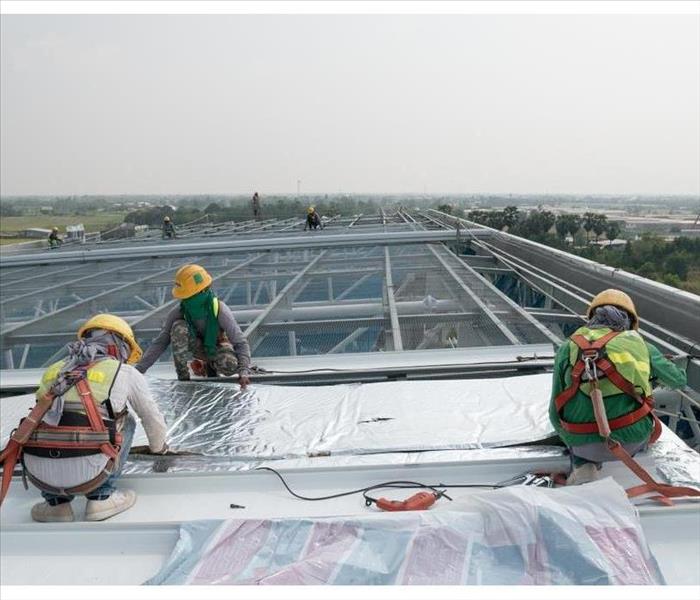 To reduce the risk of storm damage to your building, implement an exterior maintenance plan.
To reduce the risk of storm damage to your building, implement an exterior maintenance plan.
Make A Building Exterior Maintenance Plan.
It is important to set up a routine maintenance plan for your commercial building. Not only will it keep your property looking great, but proper exterior maintenance protects your building from storm damage as well.
There are many areas on the outside of your building that should be checked frequently.
1. Roofing Inspection
Your roof is the most exposed part of the building, which makes it prone to damages during heavy winds and rainstorms. Inspect the roofing materials routinely and after a storm. Missing or damaged pieces should be replaced as soon as possible.
Inspect the gutters and drains for leaves and debris which can clog the drainage system, causing water to pool. Make sure skylights and HVAC equipment are protected from the elements.
2. Window and Building Caulking
To keep your building maintained before winter arrives in Wallingford, WA, check the caulking around the windows and doors to make sure there are no gaps around the frames. If the caulking has dried out, remove it and fill the space with fresh caulk. Be sure to caulk both the inside and outside of each window.
Your building inspection should also include checking the exterior of the building. Seal any cracks or gaps in the brick and cement. Inspect the foundation as well.
3. Landscape Upkeep
Landscape inspections should be a part of your exterior maintenance plan. Check for areas that are prone to flooding and look for pooled water from the irrigation system. Make sure all sprinkler heads are in good condition and replace any damaged units.
Keep trees and bushes trimmed frequently. During a storm, loose branches can break off and damage the building and break windows. Lay down mulch and keep landscaped areas weeded regularly. If your building sustains water damage during a storm, contact a water restoration service right away.
Implement an exterior maintenance plan to reduce the risk of storm damage to your building.
3 Important Components of a Fire Safety Plan
3/31/2022 (Permalink)
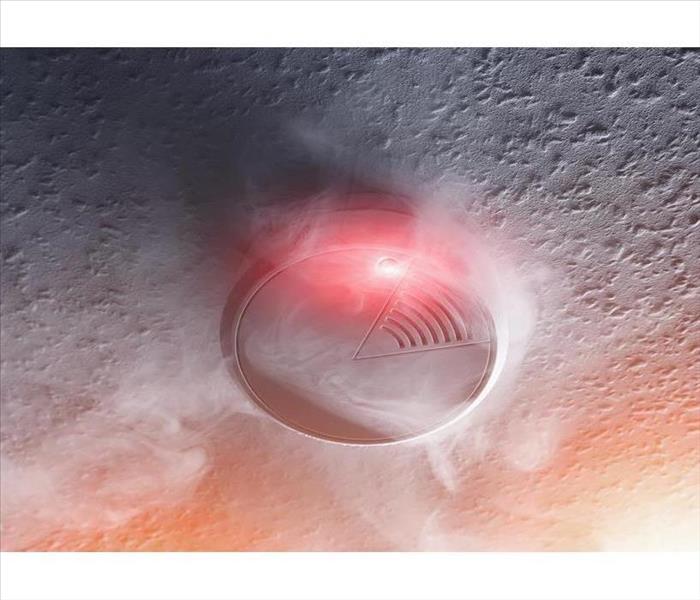 Most extensive home fires are completely preventable with the simple use of a smoke alarm.
Most extensive home fires are completely preventable with the simple use of a smoke alarm.
Fire Safety Plan
Nearly every home in America has experienced a fire at some point in its history, and every year, over 350,000 house fires occur. Those are sobering statistics and important reasons why everyone should have a fire safety plan. These three components —detection devices (including smoke alarms and heat sensors), a fire escape plan and fire extinguishers not only can protect your property and belongings but can save your life.
1. Detection Devices
Install a battery-operated or wired-in smoke detector in every bedroom, in the halls outside sleeping areas, and on every level of your home, including the basement. Though you can certainly place a smoke detector near the kitchen, a heat detector works better in the kitchen itself, because it won't be accidentally tripped by normal cooking fumes. The same is true for garages, attics and utility rooms, where electrical fires can start quickly. In these areas, a heat alarm works faster and more effectively than a smoke alarm.
2. Fire Escape Plan
A pre-determined, rehearsed escape route is an integral part of every fire safety plan. Upper bedrooms should each have a fire ladder in case the doorways are blocked by flames and smoke, and every family member should be aware of the closest exit point of every room in the house. Choose a meeting point outside your home in Greenlake, WA, in case everyone needs to take a unique escape route. If possible, install windows that are large enough to easily climb out if needed.
3. Fire Extinguisher
Keep fire extinguishers in the kitchen, basement, near your utility or furnace room, and in the vicinity of a gas grill, if you have one. Every member of the family should know where the extinguishers are and how to use them.
Most extensive home fires are completely preventable with the simple use of a smoke alarm, but in the unfortunate event, a fire does occur, have a safety plan in place. It is better to need the assistance of a fire remediation service to clean up damage to your home than a doctor to treat injured loved ones.
How Do I Know if My Business Needs Flood Insurance?
3/30/2022 (Permalink)
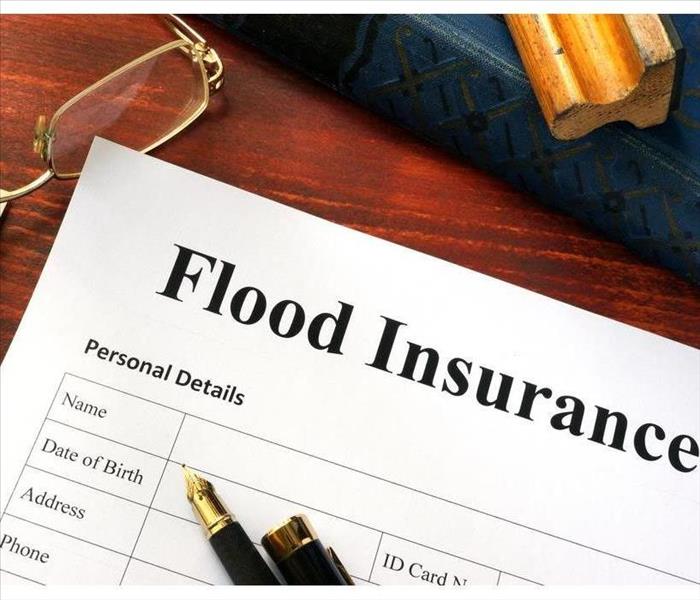 As a business owner in, you need to make sure you have the right coverage for your property when storms or other natural disasters hit your area.
As a business owner in, you need to make sure you have the right coverage for your property when storms or other natural disasters hit your area.
How Do I Determine Whether My Company Requires Flood Insurance?
As a business owner in Seattle, WA, you need to make sure you have the right coverage for your property when storms or other natural disasters hit your area. Not all water damage is covered under a standard policy, so it's important to know whether you need separate flood insurance. You don't want to wait until your property has already sustained water damage to find out what your coverage includes.
Standard Policy
A standard commercial insurance policy usually covers water damage that happens:
- As a result of storms, such as wind damage, rain, hail, or lightning
- As a result of broken pipes or plumbing failures
However, most standard plans do not cover water damage that the insurance company determines to be caused by neglect:
- slow roof leaks
- slow plumbing leaks or groundwater seepage.
These are maintenance issues that fall under the owner's liability. If damage happens suddenly due to a storm or burst pipe, those claims are usually covered. Check with your agent to find out what is included in your policy, as each business is different and insurance coverage varies by company.
Federally-Mandated Flood Insurance
If your property sits on a known flood zone, the government requires you to have a separate flood insurance policy; usually, if that's the case, you would have purchased a policy when you were given a mortgage.
Separate Riders
Many insurance companies allow you to purchase separate riders to cover water or sewer damage not included in a regular policy or mandated by the government. Flooding can happen from storm surges, melting ice and snow, water main breaks, or the overflow of lakes, rivers and streams. Sewer damage is only covered through a rider of its own. Your agent can help you determine whether your risk is worth the expense of these extra policies.
It pays to be prepared and knowledgeable about your coverage before your building or its contents ever sustains water damage. A good flood insurance policy will not only cover the loss but also the cost of cleanup and remediation, saving you thousands of dollars and an enormous amount of stress.
Tips on Flood Readiness for Your Business
3/30/2022 (Permalink)
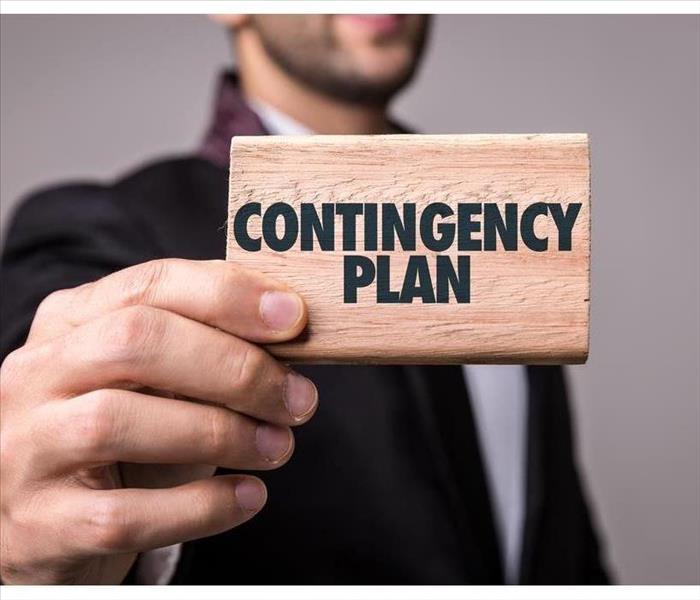 Unpredictable weather conditions can cause rising floodwaters, threatening your business with physical damage and revenue loss.
Unpredictable weather conditions can cause rising floodwaters, threatening your business with physical damage and revenue loss.
Flood Preparedness Tips For Your Business
Unpredictable weather conditions can cause rising floodwaters and threaten your business with physical damage and loss of revenue. With preparation, your risk of significant damage lessens. Taking a few precautionary measures can save you from having to clean up major water damage and lose valuable time. Consider implementing the following:
Emergency Preparedness Plan
Whatever your existing risk level, you may experience less damage to your business if you prepare by:
- Compiling an emergency resource box or closet that includes water, flashlights, batteries and a first aid kit
- Signing up for emergency notification services in your area
- Finding phone numbers for a local water restoration company
- Keeping up with preventive maintenance practices, such as cleaning gutters and storm drains
- Posting building evacuation routes in a central location
The type of plan you require depends on your level of risk for severe weather and water damage.
Risk Assessment
Consult with your city planning department, local weather agencies and nearby property owners to determine the history of flooding in your area. Knowing your risk level helps you plan for any vulnerable elements related to your structure or location. Your business insurance agent may also be able to help you determine your risk, and the Federal Emergency Management Agency provides risk maps and other resources.
Staff Training
If you discover that you bear a flood risk, it is important to involve your workforce in emergency preparedness. From broken pipes to threatening floodwaters, your staff can be helpful in helping prevent serious water damage. A little preparation can teach them what to do and how to work together effectively in an emergency. Your local emergency response personnel or water remediation specialist may generally be willing to help you design a plan for your unique situation.
If your Greenlake ,WA, business endures a flood event, you will likely be glad you spent time preparing. Water cleanup and restoration can be disruptive, but adequate preparation can reduce the impact of severe weather on your property and your bottom line.
What to Expect During Fire Restoration
2/15/2022 (Permalink)
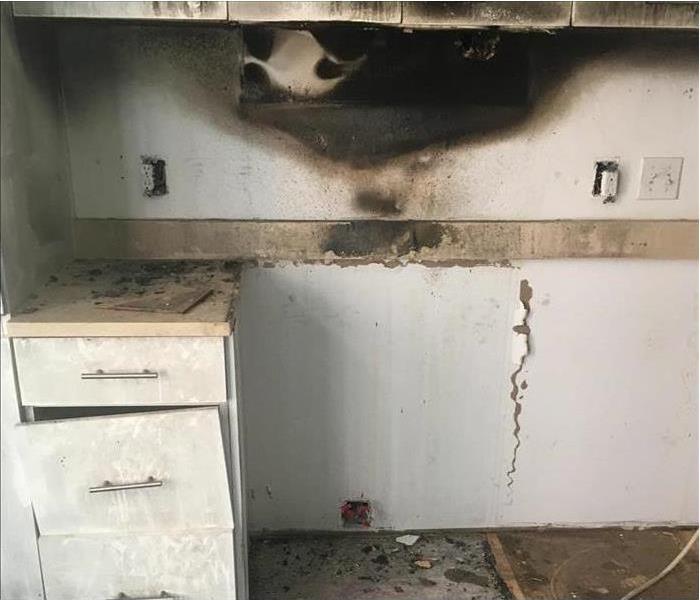 This home suffered from a kitchen fire. Our SERVPRO professionals quickly got to work to ensure that the fire damage was properly taken care of!
This home suffered from a kitchen fire. Our SERVPRO professionals quickly got to work to ensure that the fire damage was properly taken care of!
What To Expect During A Restoration After A Fire
If you have experienced a fire in your home in Woodinville, WA, then it is likely you will need fire restoration. Restoring your home can take a while and there are several steps that will need to be followed.
1. Inspecting the Damage
The first thing that you will need is a fire damage assessment. A professional will determine the amount of the damage so that they can create the best damage cleaning plan for restoring your home.
2. Mitigation to Prevent Further Damage
Before fire restoration can begin, it is important for mitigation to be performed on your home. During mitigation, steps are taken to prevent any further damage. Depending on the damage that your home has suffered, this can include boarding up missing walls or windows as well covering damaged roofs with tarps.
3. Removing Water From Your Home
If the fire was big enough that firefighters were involved, you will likely have water damage as well as damage caused by the fire. Before any repairs can be made, any remaining water will need to be removed from the home. Air movers and dehumidifiers might be used to dry everything more quickly.
4. Cleaning Your Home and Belongings
Once mitigation has been performed and all of the water has been removed, the specialists will begin cleaning any remaining soot and smoke damage. Any structures and belongings that can be restored will be cleaned and smoke odors will be removed.
5. Restoration of Your Home
The last step is restoring your home to the condition it was in prior to the fire. This includes reconstruction of any areas that have been severely damaged as well as smaller repairs such as installing carpets or repainting walls.
After an emergency, it is important to call a fire restoration service as soon as you can. Because there are many steps to take in restoring your home, you shouldn’t wait too long to begin the process.
Why Floods are the Perfect Breeding Ground for Mold Development
2/15/2022 (Permalink)
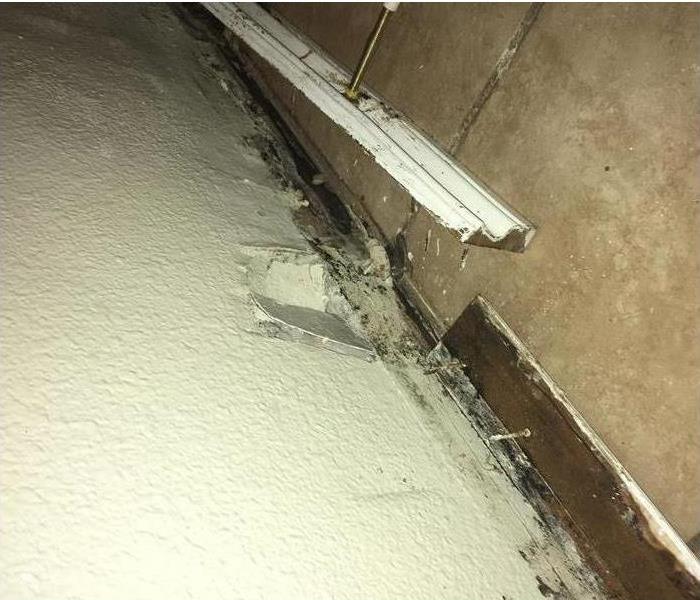 Water damage can lead to microbial growth in as little as 48 hours. Give SERVPRO a call at the first signs of a water leak to prevent mold.
Water damage can lead to microbial growth in as little as 48 hours. Give SERVPRO a call at the first signs of a water leak to prevent mold.
Why Are Floods The Ideal Breeding Ground For Mold Growth?
It’s bad enough that your business flooded. You now have to wade through the lengthy mitigation and restoration process, hoping that your business doesn’t go under in the process. However, while your focus is rightfully on your business, you should refocus your attention to the possibility of mold growth. Flooding creates the perfect breeding ground for mold development for many reasons.
1. Floodwaters
Floodwaters are not the cleanest water. Typically, the water is filled with bacteria. Additionally, it takes time for flooding to recede which means that your business is left with a pool of standing water until city sewers or natural drainage take effect. This is a perfect concoction for mold development because mold loves damp and humid environments.
2. No Electricity
Mold growth also thrives in dark areas, so when flooding also leads to sweeping power outages, mold thrives. Additionally, if the power is out then most ventilation systems are out, meaning that the interior of your facility is remaining damp and humid, potentially accelerating mold infestation.
3. Closed Spaces
Mold takes hold within 24-48 hours, and in closed spaces, it is typically at the lower end of that spectrum. Most business owners lock up their facilities tight, with sandbag barricades, as most cities advise. Unfortunately, a tightly sealed facility also contributes to a lack of ventilation.
4. Cleanup Process
Luckily, a fast cleanup response can mitigate the development of mold. Unfortunately, the cleaning process may contribute to a spreading problem because cleaning out requires ventilating the space, which increases air movement and allows for the spread. A mold remediation specialist in the Shoreline, WA, area will be able to assess your property better and help you reduce your risks.
Mold growth can occur quickly after a flood, and unfortunately, the conditions left behind after the storm has passed only increase the likelihood of an infestation. Thankfully, some specialists can help you reduce your losses and get back to business quicker.
Fire Insurance for Your Business
1/12/2022 (Permalink)
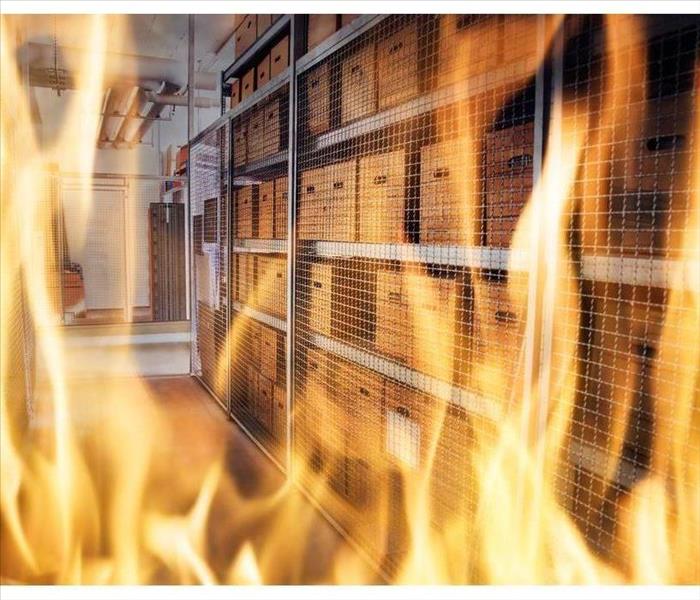 Without an appropriate fire insurance policy, small businesses may not have the financial resources to survive this situation.
Without an appropriate fire insurance policy, small businesses may not have the financial resources to survive this situation.
Your Company's Fire Insurance
Business owners generally purchase property insurance for protection against minor damages, but some don't understand that additional coverage is necessary for disasters, such as fire. While some industries are at high risk for workplace fires, just about any Seattle, WA, business should consider the benefits of fire insurance coverage.
Areas of Concern
Your business may be home to some of the most common fire risks.
• Flammable materials
• Overloaded outlets
• Open flames
• Smoking areas
• Appliances and tools without appropriate UL stickers or compliance
According to the National Fire Protection Association, fire is the primary cause of property damage losses. In a typical year, fires cause several billion dollars in property damage. For a small business, a fire could mean the end of operations. The losses involved in damage to the property aren't the only problem. Fire departments may charge for their services.
There's A Lot at Risk
In addition to losses from fire restoration services, smoke cleanup, water removal and remediation services, business owners must worry about losses due to not being open during the restoration period. A lot of money is lost in paying employees and rent during a period without revenue and additional costs may be accrued because of moving the business to another location while the fire is sorted out.
You Can Survive
Without an appropriate fire insurance policy, small businesses may not have the financial resources to survive this situation. A business property policy may cover the costs of machinery, equipment, and furnishings. (Make sure you know the difference between actual cash value versus replacement costs.) A business interruption insurance policy offers protection from losses related to lost profits and the cost of continued operations.
Take Action Now
Fire insurance usually covers physical damages, the repair or replacement of office fixtures, lost income, and operational costs during the restoration period. Discuss your coverage with your insurance representative and fire restoration professionals for the best results. Small businesses in Seattle, WA, can protect themselves from many hazards with well-thought-out insurance coverage.
Types of Water Damage Coverage
1/12/2022 (Permalink)
 Most commercial insurance policies explicitly do not cover the sort of catastrophic flood event that results from extreme rainfall, tidal waves, etc.
Most commercial insurance policies explicitly do not cover the sort of catastrophic flood event that results from extreme rainfall, tidal waves, etc.
Water Damage Insurance: What It Is and What It Isn't
Do you know when water damage to your business is covered by your existing insurance policy? Read on to better understand how to approach damaged pipes and other plumbing problems.
1. Floods or Leaks?
While most commercial insurance policies explicitly do not cover the sort of catastrophic flood event that results from extreme rainfall, tidal waves, or overflowing rivers, many other types of water damage are still covered by default plans. For example, leaking pipes and the damage they cause to the surrounding area are usually covered. As long as all issues are correctly documented and ascertained by your adjuster, your insurer will likely pay for a qualified professional water damage restoration service to bring your property back to its original condition.
2. Burden of Maintenance
However, under most default packages, your business damage will not be insured against flooding resulting from negligence. Broadly speaking, these cases usually come down to a lack of preventative maintenance. For example, if a few damaged pipes were noticeably leaking for more than a couple of weeks, it is no longer considered an unpreventable accident. In such cases, the business owner will be liable for all damages, since the flood did not result from a sudden event.
3. Other Exceptions
Coverage for fire suppression systems, such as water-based overhead sprinklers or powder-based devices, is usually more extensive than for the basic plumbing. This is because these systems are necessary for the buildings to be compliant with fire codes and because water does not move through these pipes regularly. While it is important to maintain your fire sprinklers in Greenlake, WA, for safety and legal reasons, it is unlikely that you need an additional insurance coverage package to cover them. Mold damage resulting from moisture retained in the walls or floors is usually not covered, as this is a side effect from a more fundamental plumbing problem.
Don’t allow damaged pipes and other plumbing issues to linger and incur unnecessary costs. Prevent downtime by actively pursuing the appropriate maintenance remedies outlined above.
3 Ways To Control a Mold Problem in Your Home
1/12/2022 (Permalink)
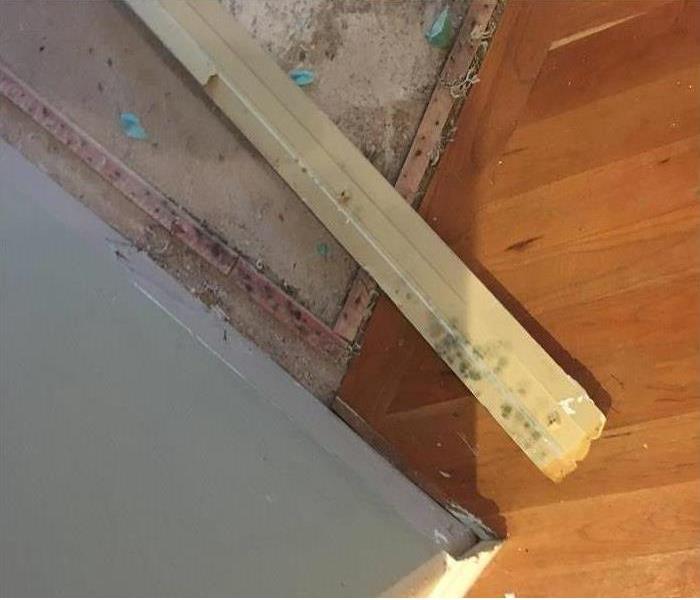 If you think your property might suffer from mold damage, let our SERVPRO team make it "Like it never even happened."
If you think your property might suffer from mold damage, let our SERVPRO team make it "Like it never even happened."
3 Ways To Get Rid Of Mold In Your House
Water damage in your home in Wallingford, WA can be problematic enough on its own. Unfortunately, areas saturated with water are likely to experience mold growth. However, there are various ways you can keep mold under control in your home.
1. Find and Eliminate the Source(s) of Water
As soon as you realize that water is leaking or flooding your home, locating the source(s) of the water can help you know what to do next. If you find that an appliance is leaking, shutting down or turning off that appliance may stop the water from flowing. However, in some instances, you may need to shut off the water in your home. By stopping the flow of water, you will keep the damage contained and lessen the areas where mold is likely to grow.
2. Keep Your Home Dry
Once water is no longer flowing into your home, it’s wise to make sure your home is as dry as possible. Using fans and opening windows can help your home dry out more quickly. Since mold grows in warm, damp environments, keeping your home dry will prevent mold from growing. Additionally, quickly taking measurements to keep your home dry can also help to prevent further water damage from occurring.
3. Take Preventative Measurements
Sometimes, you may not notice that mold has grown in your home until it has spread and caused damage. However, it can be helpful to frequently check the areas in your home where mold is most likely to grow. If you do notice any leaks in your home, it’s generally best to fix the problem as quickly as possible in order to prevent mold from growing.
With knowledge of how to manage the issue of mold growth in your home, you can also take steps toward mold prevention. If water damage in your home has caused extensive amounts of mold to grow, however, you may want to contact mold remediation experts.
Factors Required To Save a Carpet After a Flood
12/16/2021 (Permalink)
 When it comes to water removal and mitigation, you can always count on our SERVPRO team!
When it comes to water removal and mitigation, you can always count on our SERVPRO team!
Factors To Consider When Trying To Save A Carpet After A Flood
Any time your home in Greenlake, WA, floods, whether from a storm or a pipe break, your carpet is in danger of being compromised. The fibers tend to hold on to dirt and water, which can make restoration difficult and secondary damage likely. That doesn’t automatically mean you have to spring for new flooring, though. If the right conditions exist, you may be able to salvage it, cutting down on your repair costs.
What Kind of Water Caused the Flood?
The cleanliness of the water is the main factor that determines whether items in the room can be salvaged. When it comes to floodwater, there are three categories of contamination:
- Category 1 – Clean water, usually from a faulty supply line or pipe break
- Category 2 – Gray water, usually from an appliance overflow
- Category 3 – Black water, usually from storm flooding or sewer water
If the water’s contamination level falls under Category 2 or 3, your carpet needs to be replaced. The water is likely to contain harmful bacteria that would be difficult, if not impossible, to remove during the restoration process. If, however, it is clean water, a thorough drying should suffice.
How Long Has It Been Wet?
Another issue water remediation specialists consider when deciding if materials should be replaced is the length of time it has been saturated. If you call the professionals as soon as the flood occurs, they are likely to get to the problem in time to salvage as much as possible. Mold loves moisture, and it can start to grow as soon as 24 hours after water damage occurs. The longer you wait, the more you’re going to have to replace as the result of secondary damage.
If you have a pipe break in your home and your floors are flooded, call in the experts quickly. The sooner they fix the problem, the higher the probability that you can keep your carpet.
3 Ways To Prevent a Hotel Fire
12/16/2021 (Permalink)
 SERVPRO is here to help in your time of need. We are fire damage restoration experts who are available 24 hours a day to respond when you need us.
SERVPRO is here to help in your time of need. We are fire damage restoration experts who are available 24 hours a day to respond when you need us.
Three Ways To Avoid A Hotel Fire
A hotel fire can endanger the safety of everyone on the premises. Although hotels post fire safety information on doors and in hallways, evacuating from an unfamiliar place can pose a challenge. Here are three fire prevention tips for guests staying in hotels.
1. Use Electronics Responsibly
Reduce the risk of short-circuiting and fires by using electronics responsibly. Only plug devices into suitable plugs. You should never remove the third prong from a grounded plug end to plug a device into an ungrounded outlet. It is also a good idea to avoid overloading outlets. If your room does not meet your needs, ask about other options at the front desk.
2. Exercise Caution With Hot Appliances
Follow safety guidelines if you use a hairdryer, other heated tools, or a clothes iron in a hotel room. Turn off appliances after use, and allow these items to cool on a hard, flat, non-flammable surface. Do not put these appliances away until they are cool to the touch to avoid a hotel fire. If you stay in a room with a kitchenette, make sure the stove is turned off after you finish cooking. Only microwave food intended for this method of preparation.
3. Don't Smoke or Light Candles
Most hotels are non-smoking facilities. Many fires are caused when a smoker falls asleep with a lit cigarette. If you smoke, ask about designated outdoor areas. Guests should also avoid lighting candles while staying at a hotel. Open flames pose a significant fire risk, especially if you are tired from traveling.
It is not difficult to avoid starting a hotel fire. Follow the same fire safety methods you would at home, and use hotel equipment responsibly. You should still to familiarize yourself with evacuation routes. If a fire starts at a residence located in Lake Forest Park, WA, contact the fire department and a fire restoration service.
How To Manage Water-Damaged Office Equipment
12/16/2021 (Permalink)
 If you have water damage in your business, you can count on SERVPRO, we offer our cleanup and restoration services around the clock, 7 days a week
If you have water damage in your business, you can count on SERVPRO, we offer our cleanup and restoration services around the clock, 7 days a week
What To Do If Your Office Equipment Has Been Flooded
Sustaining water damage and restoring a flooded company can be daunting tasks for any Richmond Beach, WA, business. In addition to soaking walls and flooring, a leak or broken pipe can also saturate essential equipment. While some things, like books and paper, may not be salvageable, you may be able to save many items. Recognizing specific care requirements for a variety of objects may help you complete an efficient cleanup and restoration, allowing you to return to normal business operations as quickly as possible.
Electronic Equipment
Water and electricity can be a dangerous mix. To minimize the risk of electric shock and help avert a short circuit, you should avoid plugging in any electronic device located inside the flood zone:
- Computers
- Printers
- Appliances
Because of their intricate components, an electronics specialist should analyze each device to determine its salvageability and complete necessary repairs.
Office Furniture
Like all saturated items inside your flooded company, office furniture should be promptly removed and dried. Leather and upholstered couches and chairs may require professional cleaning. Because of the risk of mold contamination, you may need to discard extremely saturated items.
Wooden furnishings may also require special care. To prevent warping and cracks, you should gradually dry these pieces. Employing heaters and leaving wooden desks, bookshelves and chairs in direct sunlight for an extended period may cause additional damage.
Carpets and Cloth Items
Mildew can quickly develop on damp fabric. To minimize this risk, you should quickly address wet cloth, including curtains and small, removable carpets. Dry cleaning may be the most effective way to cleanse and refresh these items.
A Restored Office
A broken pipe can cause significant destruction inside any business. The key to surviving a flooded company is a swift response. Because the task can be extremely challenging, obtaining professional assistance may be the best way to efficiently dry, salvage and restore your water-damaged equipment and office furnishings.
How Much Does Water Restoration Cost?
11/19/2021 (Permalink)
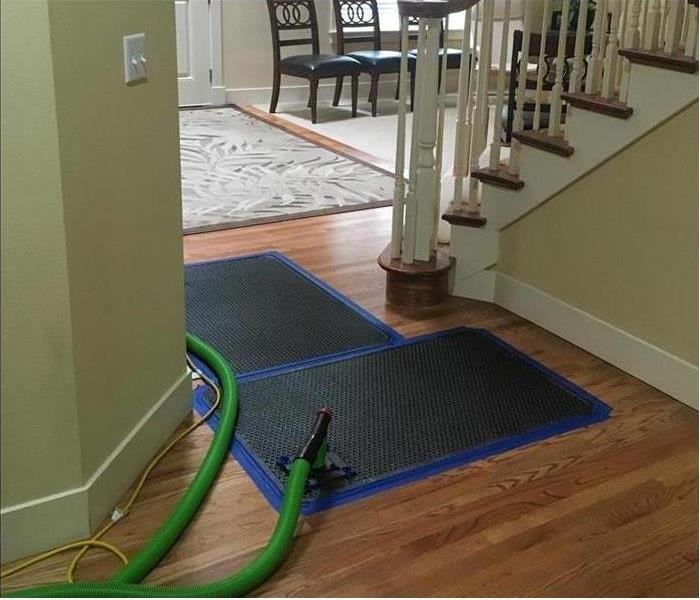 Our SERVPRO of Seattle Northwest team frequently uses these floormats to dry flooring affected by water damage.
Our SERVPRO of Seattle Northwest team frequently uses these floormats to dry flooring affected by water damage.
What Is the Price of Water Restoration?
Water damage repair at your home in Seattle, WA, can cost you time, energy and money. How much does the process cost monetarily from start to finish? The short answer is that it depends.
What Are the Factors Involved in Pricing?
When it comes to water damage, the average flood repair in the United States runs homeowners about $2,700. However, this figure fluctuates depending on a variety of factors.
• The amount of damage in need of repair has a significant impact on cost. Typically, if drywall and carpeting are involved the average restoration cost rises to approximately $7,500.
• Type of water can also a key contributor to cost. Clean water from sources such as pipes or rain can cost roughly $3.75 per square foot. Black, or contaminated water from sewage, is around $7 per square foot.
• The speed of remediation is often important because the longer you wait to start removing water, the more secondary damage can occur. This can increase the potential cost.
• Location often plays a role in terms of labor cost. For example, New York and Chicago are two of the more expensive restoration areas.
Why Hire a Water Restoration Specialist?
Even though it may seem more expensive to hire a restoration professional for damage repair, it can save you time and money in the long run. Not all water damage is visible or obvious to homeowners. There may be hidden moisture that can cause mold and become a financial burden later. Specialists use equipment, such as infrared cameras, to remediate moisture and prevent secondary damage.
The average flood often requires specialized gear and techniques. Depending on your unique situation experts can use a variety of methods and tools for removing excess basement water, drying, cleaning, disinfecting and restoring your home and contents.
Whether you have a small amount of flooding from clean water or a significant amount from black water flooding at your home in Seattle, WA, it can be crucial to initiate water damage repair as soon as possible. Immediate, professional help can save you time and money in the long run.
Removing Dryer Lint From the Exhaust Area
11/19/2021 (Permalink)
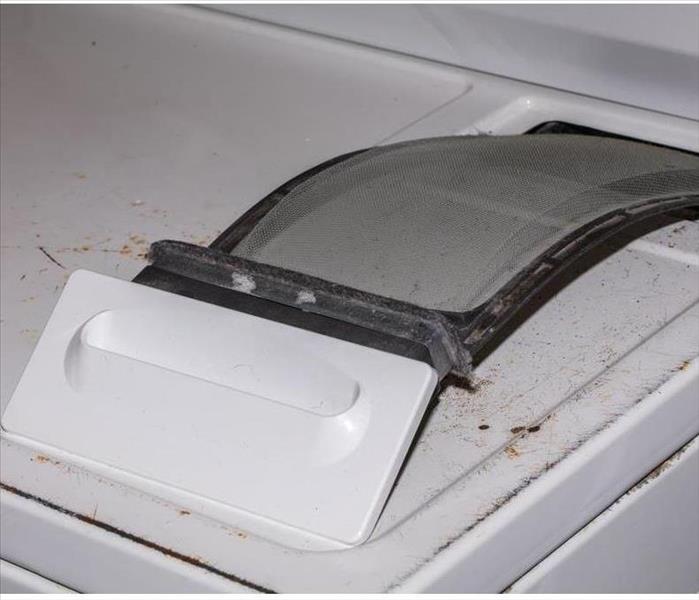 To avoid an accident that leads to fire damage, you generally need to keep your dryer as lint-free as possible
To avoid an accident that leads to fire damage, you generally need to keep your dryer as lint-free as possible
Cleaning the Exhaust Area Of A Dryer
If you recently noticed a lot of lint buildup in the dryer at your Greenlake ,WA, home, the risk of a lint fire might have crossed your mind. It can be especially hazardous for lint to build up in the dryer’s exhaust area. Here are five steps to take if you want to rid your appliance’s exhaust section from lint and avoid a dryer fire.
1. Clean the Lint Filter
Before you do anything else, make sure to clean off the dryer’s lint filter. You will also want to do this every time you are about to run the machine. You can usually remove this lint with your hand, but you can also run the filter under water.
2. Unplug Your Dryer
Before you do any further work to prevent a lint fire, make sure the dryer equipment is unplugged. Forgetting to do so could cause a dangerous accident.
3. Access Exhaust Area
Take off the panel at the back of the dryer and remove the hose at the machine’s exhaust area. You can then reach the inside of your dryer and the exhaust section to clean out lint.
4. Clean Dryer Interior
Your next task is to clean the interior of the machine and the exhaust area. A cloth and a vacuum are the best tools to use.
5. Repeat Steps Yearly
To avoid an accident that leads to fire damage, you generally need to keep your dryer as lint-free as possible. Repeat the four steps above every six months.
Lint fire prevention can seem very challenging, but the five steps above should really help you to be prepared. As long as you remember to keep checking for lint and getting rid of it when you do find it, you will be in a better position to keep your Greenlake ,WA, home free of dryer fires.
How to Keep Working When the Lights Go Out
11/19/2021 (Permalink)
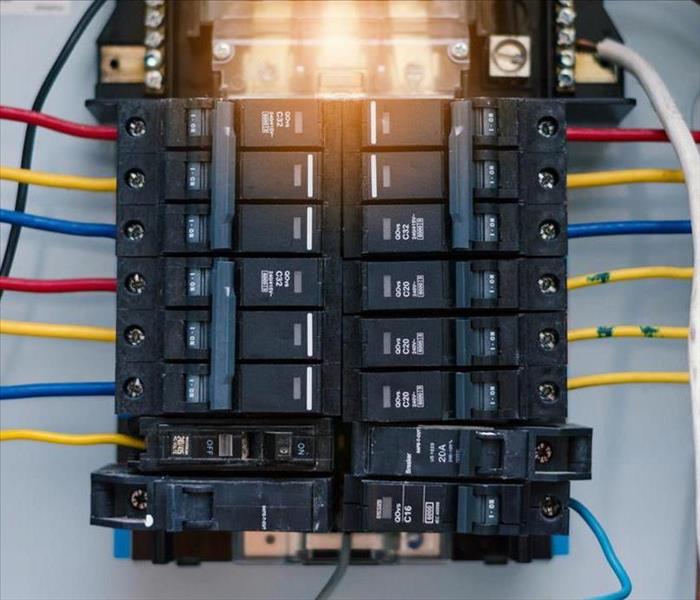 A power outage doesn't have to mean that your business comes to a halt, but if you experience damage from a storm, SERVPRO can help you!
A power outage doesn't have to mean that your business comes to a halt, but if you experience damage from a storm, SERVPRO can help you!
How To Continue Working Even When the Lights Go Out
Weather can have a huge impact on your business. Hurricanes, tornadoes, and blizzards can spell disaster for anyone. Even if your business doesn’t take a direct hit, it may still be affected by inclement weather. For example, what do you do if there is a power outage in Wallingford, WA? Here are a few tips in the event you lose power due to a natural disaster.
1. Decide what is essential and turn everything else off. If you have a portable generator to keep you up and running, that’s great, but that’s going to cost you fuel to run. Conserve fuel by turning off what you don’t absolutely need, such as decorative lighting or extra work stations. Conservation is key during times of emergency and disaster.
2. Keep the generator outdoors. This cannot be stressed enough. Read the owner’s manuals for any generators you are using and pay careful attention to all safety instructions. A power outage can be inconvenient and annoying, but improper use of a portable generator can be downright dangerous – even fatal. Don’t risk it.
3. Determine if work can be done from home. It will depend on what type of business you’re in, but if it is possible for some of your staff to work from home (assuming that they have power), you may need to ask them to do so temporarily. This may be easier for some departments than others, but whatever you and your team can do to keep things running smoothly will be helpful.
A natural disaster can be disastrous for business, but these tips can help you minimize your lost time and profits. If you are lucky enough to not lose power, it can be a nice gesture towards the community if you use your good fortune to help out others, too. A power outage doesn’t have to mean that your business comes to a halt, but if you experience damage from a storm, companies that specialize in restoration can help get your business back up to speed.
Choosing the Best Smoke Detector
10/26/2021 (Permalink)
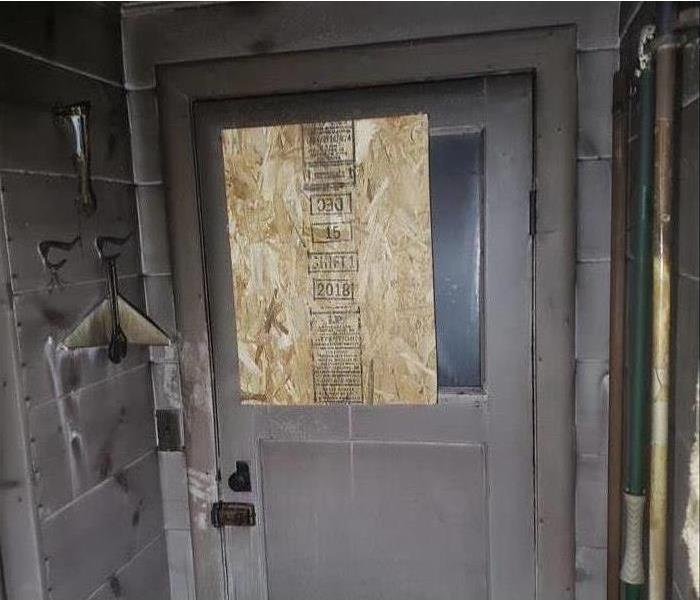 If your Seattle home faces fire loss, give SERVPRO of Seattle Northwest a call. We can help you!
If your Seattle home faces fire loss, give SERVPRO of Seattle Northwest a call. We can help you!
The Best Smoke Detector to Buy
A house fire in Seattle, WA, can be a frightening experience, but according to the National Fire Protection Agency, one of the best fire safety measures is to use a properly functioning smoke alarm. This simple step can dramatically increase your chances of survival if a fire occurs while you are at home. That’s why it’s important to know how to choose a smoke detector that you can rely on to protect you and your family.
Choose the Type of Smoke Alarm
- Ionization alarms use a minute amount of americium-241, a radioactive element, to ionize the air that flows into the mechanism. If smoke is introduced, the flow of air is interrupted, which triggers the alarm to sound. These alarms work better at detecting fires that flare up quickly and don’t produce much smoke, such as those started with highly flammable materials. Ionization alarms are the most cost-effective.
2. Photoelectric alarms incorporate a light and a sensor. In its normal state, the sensor does not detect the light; however, smoke particles disperse the light, causing the sensor to detect it and activate the alarm. This type of alarm is better at detecting fires that produce a lot of smoke, such as smoldering fires that are started in beds or upholstered furniture. Photoelectric alarms are more expensive than ionization alarms.
3. Dual sensor alarms combine aspects of both ionization and photoelectricity; therefore they detect both types of fires regardless of how much smoke is produced. Because they are the most effective, they are also the most expensive.
Note the Power Source
Most smoke detectors run on batteries. If they do, you need to be sure to change the batteries regularly, at least once per year. However, some use lithium batteries, which can last up to 10 years. Some even can be connected directly to your home’s current, only using batteries as backup when the power is interrupted.
A smoke alarm can help prevent fires, but sometimes they happen anyway. In the unfortunate event that your home is damaged by a fire, a professional restoration service can relieve much of the burden of home restoration.
How To Use a Fire Extinguisher
10/26/2021 (Permalink)
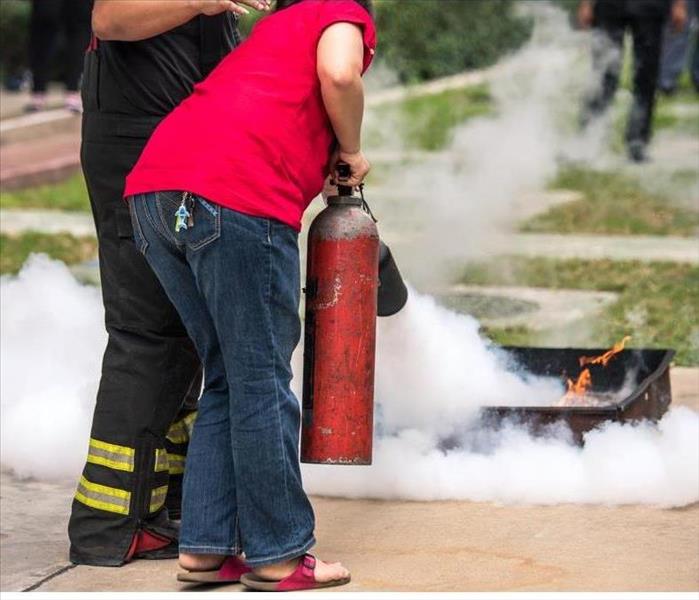 As soon as a fire starts, get the extinguisher and identify a safe evacuation path.
As soon as a fire starts, get the extinguisher and identify a safe evacuation path.
The Proper Use of a Fire Extinguisher
A fire extinguisher is a helpful safety tool for suppressing small to medium-sized fires and limiting fire damage. As soon as a fire starts, get the extinguisher and identify a safe evacuation path. You should check to make sure that the extinguisher you have on hand contains a suitable substance for the type of fire you are trying to suppress. It is also a good idea to sound the fire alarm in a commercial property and contact the fire department before attempting to suppress a fire.
Whether you have never used a extinguisher or it has been a long time since you experienced a fire emergency, here are four simple steps you can follow.
- Pull the pin. Pulling the pin on a extinguisher will break the tamper seal.
- Aim the fire extinguisher nozzle, hose, or horn. Point the dispenser at the base of the fire. Avoid making contact with the discharge horn on a CO2 extinguisher, as it may become very cold.
- Squeeze the handle. Squeeze the handle to dispense the substance within the extinguisher in the direction of the fire.
- Spray from side to side. Move the spray horizontally across the base of the fire until it appears to be out. Keep in mind that a fire may seem to be out and then reignite.
Keep watching the affected area to make sure the fire does not restart or have firefighters inspect the area to make sure it is out. Once you use a fire extinguisher you will need to either refill or replace the extinguisher, depending on whether the design is reusable or disposable. Reusable extinguishers cost more up front but less to refill than buying a new disposable extinguisher. If your commercial property in Greenlake , WA sustains fire damage from a kitchen fire or electrical fire, you should contact a commercial restoration company.
Mold Growth: An FAQ
10/26/2021 (Permalink)
 Mold remediation is a complex process that begins with eliminating the source of the mold. SERVPRO can help you with any mold damage In your home.
Mold remediation is a complex process that begins with eliminating the source of the mold. SERVPRO can help you with any mold damage In your home.
Mold Growth: Frequently Asked Questions
Mold may be disgusting and a danger to your home, but do you truly understand what mold is? Let’s take a look at a few frequently asked questions about mold, and what you can do to prevent its outbreak in your Wallingford, WA home.
What Is Mold?
Mold is a fungus that can take root in your home and proliferate, causing unsightly stains and aggravating allergies. Once mold sinks in deep it can be hard to get rid of.
What Causes Mold to Grow?
Mold growth is primarily caused by excess moisture in your home environment. You can frequently find it in places of your home that have suffered water damage. Factors that contribute to mold growth include:
- High humidity environments
- Water damage from flooding or leaking
- Broken and damaged pipes
- Condensation from malfunctioning appliances
Is Mold Different from Mildew?
While both mold and mildew are fungal growths, they’re not the same thing. You can generally tell them apart by texture; where mildew tends to be soft and powdery and will flake off to the touch, mold tends to be a fuzzier growth with a thicker texture.
How Can I Get Rid of Mold?
Mold remediation is a complex process that begins with eliminating the source of the mold. This means identifying where your water damage is coming from and repairing your leaking roof or broken appliance, or using a dehumidifier to remove moisture from the air. Cleanup can require disposing of mold-infested items and scrubbing others with baking soda and vinegar or harsher chemical solutions.
Once the Mold Is Gone, Will It Come Back?
It can. Mold is never wholly gone; it just goes dormant as invisible spores in your environment. If mold finds a combination of organic matter and moisture to feed on, then it can take root again and begin to grow. It’s best to remain vigilant and continuously seek to eradicate mold sources from your environment.
Keep Bathrooms Mold Free
10/4/2021 (Permalink)
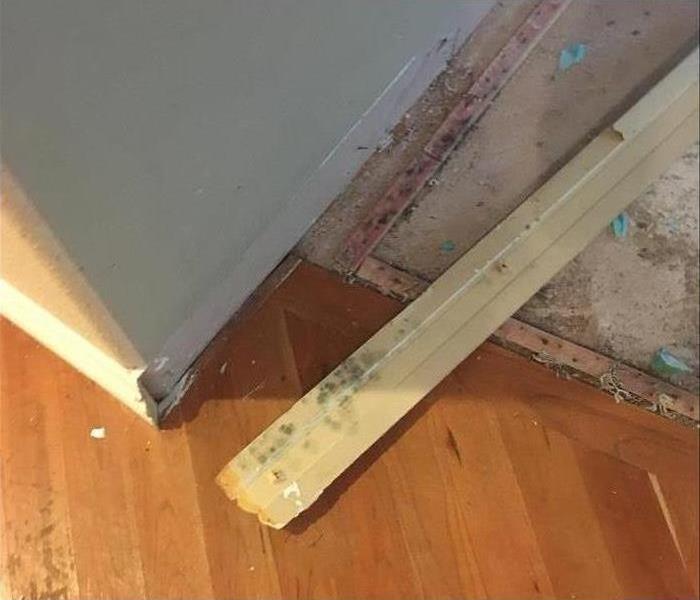 Mold damage in a Broadview, WA home
Mold damage in a Broadview, WA home
A nice warm shower or bath can be a great way to end the day or re-energize in the morning. You aren’t alone in being drawn to the comforts a bathroom can provide. Lingering dampness after bathing and potential water damage create welcoming environments for mold growth.
Finding the Mold
While sometimes obvious, mold damage can also be sneaky. Hidden water damage may likely be the culprit if you notice the distinct musty odor without the visual cues. When finding the source, check the following areas:
- Inspect toilets, sinks and pipes for signs of a leak or mold.
- Check caulking around tubs and showers.
- Remove ventilation fan cover to look for signs of growth.
- Inspect walls, grout, wallpaper, drywall, rugs and other porous materials for dampness.
Preventing Growth
The pesky fungus may be annoying, but luckily mold prevention is easy. Incorporating a few daily habits and regularly checking for damage can keep it at bay. Some tips include:
- After bathing, squeegee walls to eliminate lingering water.
- Always use the ventilation fan when bathing and keep it running for 30 minutes afterward.
- Mold loves humidity. Try to keep levels below 50% in the home via a dehumidifier or air conditioner.
- Keep bathrooms clean. Washing the rugs and towels and cleaning toilets, sinks and showers can eliminate conditions that mold and mildew love.
Mold Remediation
If a leak happens and results in water damage, getting rid of the mold simply requires a little labor or calling on a professional to take care of the issue. This will involve removing any caulking, drywall or other materials with signs of mold. A thorough cleaning and 48-hour dry time will be needed to eradicate and prevent growth.
Protecting your home in Broadview, WA from mold doesn’t have to be a cumbersome task. Making a few changes and occasionally inspecting the bathroom can keep it fungus-free.
How To Clean Your Home After a Flood
10/4/2021 (Permalink)
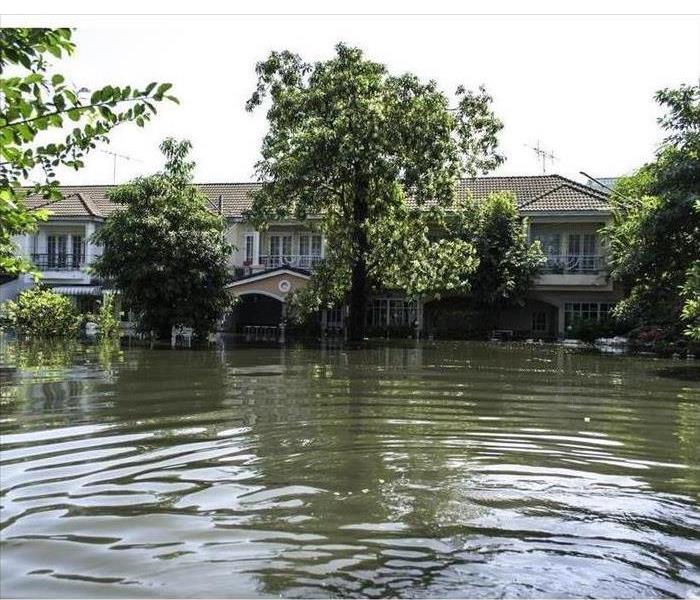 A flooded home in Seattle, WA.
A flooded home in Seattle, WA.
Cleaning Requirements to Follow After a Flood
After a flood in Seattle, WA, cleaning up the damage to your home can seem like an overwhelming task. Thankfully, there are storm damage restoration experts who can make the process go more smoothly. In fact, there are certain items that should only be cleaned by professionals, including:
- Upholstered furniture
- Washing Machines
- Televisions
- Dryers
- Dishwashers
- Radios
- Vacuum cleaners
Still, there are some steps you can take to restore your home before professional assistance arrives. If you do want to do some tidying up after a storm, there are some cleaning requirements you should follow.
Disinfect Surfaces
To prevent germs from spreading throughout your flooded home, you should use a strong cleaner to wipe down every surface of your home. Then, apply a powerful disinfectant to each area. The EPA has a list of registered disinfectants that you can use.
You can even make your own flood disinfectant using a quarter cup of bleach for every gallon of water. Make sure to apply a bleach solution to your kitchen counters and cupboards before returning your dishes to those areas. Any contaminated items should be removed from the home as soon as possible.
Kitchen Cleaning Requirements
As part of your flood clean, you also need to disinfect any metal items in your kitchen, including pots, pans and silverware. However, chlorine bleach can cause metals to darken. You should thus clean these objects by placing them in boiling water for 10 minutes. Meanwhile, glass, china or porcelain dinnerware should be placed in a solution that has two tablespoons of bleach for every gallon of hot water.
Freeze Certain Valuables
After a flood, wipe the mud off important books or photographs and place them a frost-free freezer to prevent the growth of mildew. You can then thaw and clean them at a later date.
Follow these above cleaning requirements to preserve your belongings after a flood. Clean what you can, but leave the big projects to restoration professionals.
Do All Building Materials Need to be Replaced Following a Flood?
10/4/2021 (Permalink)
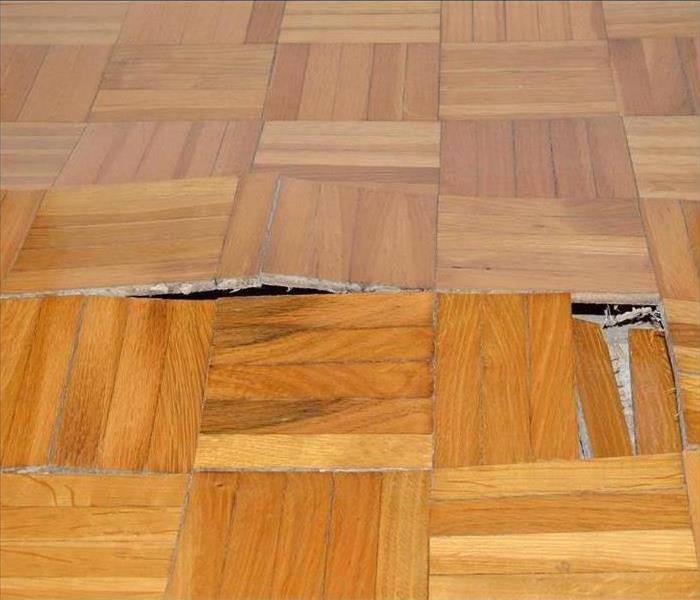 Swelling wood floor in North Beach, WA
Swelling wood floor in North Beach, WA
Life can be good in North Beach, WA, so a flood is likely the last thing on your mind and certainly the last thing you want to deal with. In the event of a household flood due to a leaking supply line or broken pipe, you may wonder what to do and whether the home’s structure can be saved. Facing the prospect of swelling wood and water pipe repair can be intimidating and worrisome, but not all building materials need to be disposed of or replaced.
How Water Affects Building Materials
Whether structural materials are hopelessly damaged, depends on how fully, and for how long they were exposed to water. The following is what happens to various building materials.
Wooden studs - Swelling wood occurs when exposed to water, particularly if submerged
Subfloor - Absorbs water and may not only swell but may also begin to disintegrate
Sheet rock - May possibly be saved upon drying out, provided the source was clean water
Insulation - Absorbs and wicks moisture and may not dry out well
The Possibility of Mold
In addition to water damage, mold may take hold in any materials that are not dried out quickly. Drying is a critical stage of the cleanup and it may require the services of water mitigation and restoration professionals in North Beach, WA, who can bring industrial fans, if needed. They can also assess the need for replacement or the possibility of repair of various materials. Those exposed to clean water may possibly be dried out and reused, but those which have an overgrowth of mold may need to be disposed of.
As you can see, when a flood comes from a supply line or other clean water source
Chances are fair that the building materials might be saved. Once the water pipe repair and swelling wood are all resolved, you can breathe a sigh of relief as your family resumes its normal routine.
Toss it out: A Guide to Throwing Away Items After a Fire
7/29/2021 (Permalink)
 You don’t want to risk ingesting anything that you know was either in or close to the fire.
You don’t want to risk ingesting anything that you know was either in or close to the fire.
After a Fire, Toss It Out: A Guide To Disposing Of Items
It’s impossible to accurately depict how devastating a fire can be when it rages through a person’s home. If you’ve been the unfortunate victim of this tragedy, you know what a helpless feeling you can have. In the aftermath, you need to go through the cleanup process and decide what to keep and what to throw away. There are some things you can salvage, while others pose health hazards to hang onto.
Food
You don’t automatically have to throw out all of your food following a fire. However, fire damage at your Greenlake ,WA home can render some things unhealthy. Inspect your food supply carefully following a fire to determine what can say or go. You should toss the following:
- Opened containers or perishable foods.
- Food you stored in thin plastic bags or cardboard.
- Non-perishable food that was close to the heat.
Medicine
High heat will wreak havoc with your medicine or cosmetics. You don’t want to risk ingesting anything that you know was either in or close to the fire. You definitely should throw away the items if they are charred or have other obvious defects or damage.
Burned Apparel
Though you hate the thought of having to replace your wardrobe, much of it may be unsalvageable. You may be able to save some items by thoroughly cleaning it. But if there are obvious burn marks, you may be out of luck. Use caution when deciding whether to keep baby clothes.
Bedding
If a fire at home affected mattresses, your best bet is to discard it. You don’t want to sleep on something that was exposed to smoke damage and harmful materials.
It’s hard to throw away items, especially if they have intrinsic meaning and value. However, you’ll feel better knowing you’re providing a safer environment for your loved ones.
Coping in the Immediate Aftermath of a Storm
7/28/2021 (Permalink)
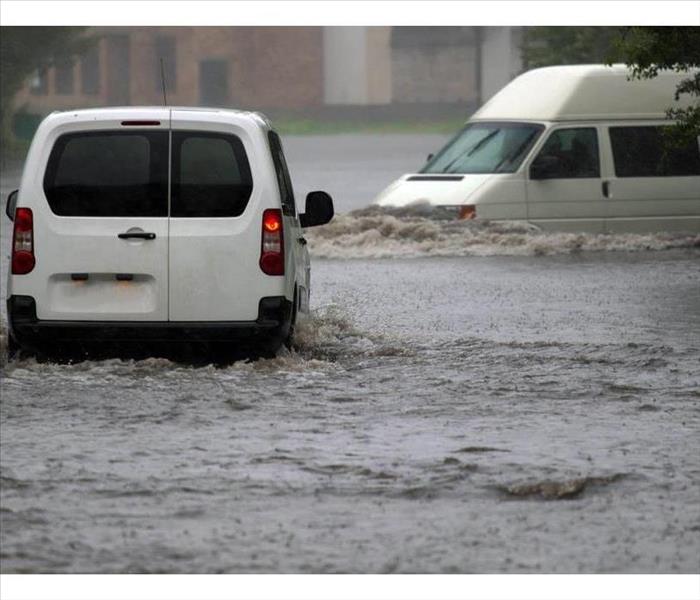 Avoid driving in flooded streets
Avoid driving in flooded streets
Storm Tips
People who live in Wallingford, WA, are no strangers to the destructive power of storms, whether it is high wind, precipitation or flooding. However, a few storm tips about what to do while waiting for help to arrive can be helpful to even the most seasoned storm veteran.
Safety Is the First Priority
• Summon help for any medical emergencies.
• Stay calm. Determine if anyone needs assistance and help if you can.
• Be sure the storm event has abated before checking surroundings for storm damage.
• Listen for official instructions on local radio, television, or internet news sources.
• Avoid driving so that roads remain clear for rescue personnel.
• Keep track of children; flooding, in particular, can remain treacherous for some time.
• Keep clear of moving water, downed power lines and compromised trees and structures; effective storm tips include perils of the aftermath.
• Follow official directions regarding evacuation or travel.
• Understand that a response for services will take time. Avoid repeated phone calls as others may also be seeking help.
• Contact your home insurance company to report damage and schedule an appointment for an adjuster’s inspection.
Securing Your Home Comes Next
Wait for an insurance adjuster to arrive to accurately record the extent of storm damage to your home and belongings. It may be necessary to secure your home from further loss or damage. Tarps or plywood can be put in place to prevent water damage, for instance. However, don’t begin repairs until your insurance company gets a full report from the adjuster.
There is a certain level of excitement and adrenaline rush attached to storm activity, and emotions can run high. However, a healthy amount of respect for the power and unpredictability of nature is in order. Heed storm tips and share them with your family, friends, and neighbors. Repairing the damage will happen soon enough, and help will be available.
Proactive Cleaning Around the Clock
7/11/2021 (Permalink)
 SERVPRO of Seattle Northwest is working around the clock to provide proactive cleaning.
SERVPRO of Seattle Northwest is working around the clock to provide proactive cleaning.
SERVPRO is Here to Help during this time of need
During this unprecedented time caused by the global pandemic of coronavirus, this is a reminder to our customers that we are specialists in cleaning services, and we adhere to the highest cleaning and sanitation standards.
Specialized Training
We are prepared to clean and disinfect your home or business, according to protocols set forth by the Centers for Disease Control and Prevention. We have years of experience in dealing with biological contaminants, and we will go beyond the scope of work that regular janitorial staff perform on a daily basis.
The CDC encourages cleaning of high-touch surfaces such as counters, tabletops, doorknobs, light switches, bathroom fixtures, toilets, phones, keyboards, tablets and tables. Other spaces mentioned in the CDC’s guidance for commercial spaces include:
- Kitchen/Food Areas
- Bathrooms
- Schools/Classrooms
- Offices
- Retail Spaces
- Water Fountains
- Shelving/Racks
- Sales Counters
- Carpets and Rugs
- Stair Handrails
- Elevator Cars
- Playground Equipment
- Fitness Equipment
Specialized Products
The CDC recommends usage of a labeled hospital-grade disinfectant with claims against similar pathogens to the coronavirus. Multiple products in the SERVPRO product line carry the EPA-approved emerging pathogens claims. While there is currently no product tested against this particular strain of the coronavirus, we are following all guidelines as provided by the CDC and local authorities.
Call Today for a Proactive Cleaning
If your home or business needs deep cleaning services, call the experts today – SERVPRO of Seattle Northwest is your trusted leader in cleanup and restoration.
What Lies Beneath the Toilet? Mystery Revealed!
7/7/2021 (Permalink)
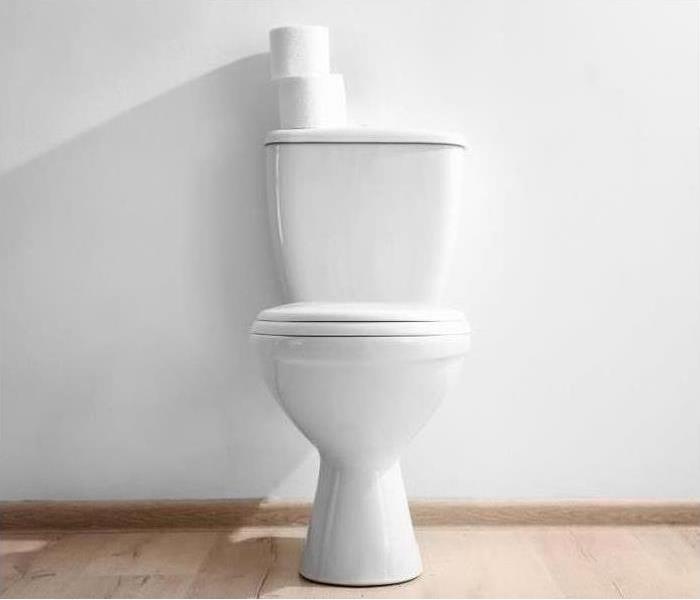 Are you surprised that there are just two simple parts under the porcelain?
Are you surprised that there are just two simple parts under the porcelain?
What Lies Beneath the Toilet?
On most days, you don’t care how your toilet works, you’re just glad it magically whooshes waste to a land, far, far away, until the day it doesn’t. Today, you notice a leaking toilet and from the look of the floor, it may have been leaking for a while. It’s time to learn what secrets lie beneath the porcelain in Seattle, WA.
Mystery Revealed
Don’t worry, a toilet is simple. You are familiar with the tank and the supply valve, but you may not have experienced the mystery from under the toilet. Here is the big reveal, which comes down to two features:
• Wax Seal. This ring-shaped seal is usually made of wax and, usually, is the reason for the leaking toilet. Sometimes a bad seal is due to improper installation, but it also just happens over time and wear. No matter what you learn about the next part, you will definitely need to scrape off the old wax and replace it.
• Closet Flange. This is a piece of metal or plastic that connects the toilet to the exit drain and the floor. Here is where things could get complicated with problems like improperly tightened bolts, a broken flange, or a flange that sits below the surface of the floor. You will need to resolve any problem with the flange before replacing the seal.
The good news and bad news are the same: there many different materials for flanges and many ways to solve problems with this critical component. Your objective is to stop the leaking toilet by making a good seal and to making sure your flange is never lower than your flooring.
It’s Not Complicated
Unfortunately, the mess of a bathroom leak is usually the first sign you see and that means you have some additional cleanup to do. Water damage repair specialists can help assess the situation to determine the best way to proceed to reduce your risk of secondary damage.
3 Tips To Eliminate Cigarette Smoke Odor
7/7/2021 (Permalink)
 Give SERVPRO a call for deodorization services.
Give SERVPRO a call for deodorization services.
What Is The Best Way To Eliminate Cigarette Smoke Odor?
Cigarette odors can be very persistent. It is possible to eliminate the smell that lingers after smoking indoors through home deodorization treatments. Here are three tips that can be helpful for getting rid of the residual smell of cigarette smoke at a home in Seattle, WA.
1. Clean Exposed Surfaces
Nicotine, tar, and other chemicals in cigarettes can cause a residue to form on surfaces such as ceilings, walls, and window blinds. These surfaces can be treated with either dry or wet cleaning methods.
A chemical sponge is an effective way to clean residues. This treatment does not contain chemicals, and is made of absorbent rubber. Wet cleaning with a degreasing cleaner such as Trisodium Phosphate or the phosphate-free TSP-PF formula can break up residue and eliminate odors. These treatments are ideal before allowing painted surfaces to dry, applying a stain-blocking primer, and repainting.
2. Filter the Air
Air filtration can reduce the number of smoke particles in the air. Homeowners may use a free-standing HEPA air filter or attach an air scrubber to an HVAC system. Filtration may not completely eliminate smoke odors. A home deodorization treatment can reach smoke particles on surfaces or areas that are difficult to clean and neutralize smells.
3. Deodorize
There are several treatments that a homeowner can pursue depending on the severity of smoke odors. Ozone machines and thermal foggers are both very fast and effective, but require evacuation during treatment. Hydroxyl generators and vapor modification may take longer, but these treatments can proceed while occupants remain at home.
These three tips can help a homeowner get rid of the odor of cigarette smoke at a residence in Seattle, WA. While it may be possible to start the cleanup process on your own, a smoke damage remediation service can provide home deodorization treatments to ensure that every trace of the smell is gone.
How To Handle Water Leaks Near Light Fixtures in 3 Steps
6/30/2021 (Permalink)
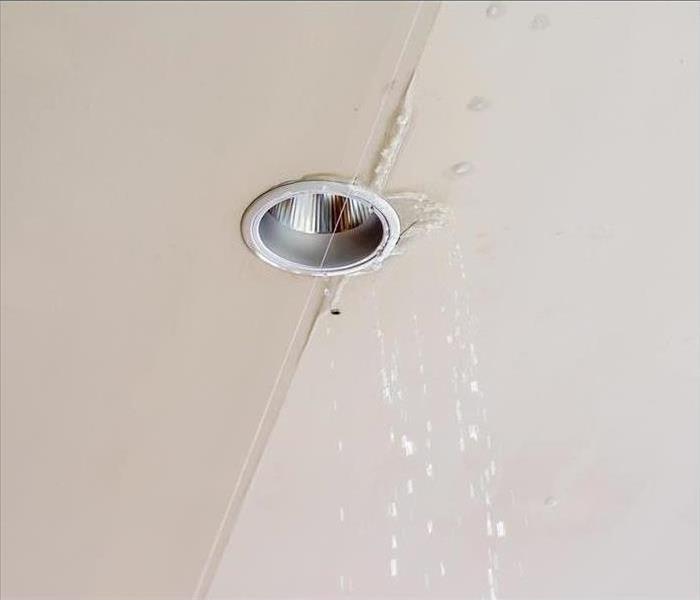 The presence of water in light fixtures is especially dangerous.
The presence of water in light fixtures is especially dangerous.
3 Easy Steps You Can Take To Control This Scenario
Water leaks are always concerning, as they can greatly damage your North Beach, WA, home and property. The presence of water in light fixtures is especially dangerous since water and electricity together can harm you. You will need to handle these situations carefully.
1. Shut Down Electricity
Before conducting repair efforts, it is important to disable the danger of electricity immediately. If it is safe to do so, head straight to your house's service panel and shut down the main source of power. Even if the damage is limited to one specific area, it is better to turn off all power until the area is secure. Test the lack of electricity by using a non-contact voltage tester on a dry appliance.
2. Turn Off the Water Valve
Another important step in mitigating the situation is cutting off the main supply if the water in the light fixtures comes from a leaking pipe. Water, alongside any chemicals in the water, can conduct electricity and endanger anyone in the area. Look above to detect any water drops, ceiling damage, mold or other signs of a plumbing failure. You will need to locate your house's main water valve and shut it down immediately.
3. Call the Appropriate Professionals
Now that the affected appliances and locations are free of danger, it is time to call the professionals who can resolve the problem. If there are broken pipes, a plumber can repair the system and stop further damage. Call an electrician to fix the light fixture or device in question and to ensure it is the right time to bring back power. After that, an emergency remediation specialist can help restore your home to its former state.
Water damage can harm you and your loved ones and further destroy your home, especially when it comes to water in light fixtures and other electronic devices. Take the proper steps to minimize the hazards and keep your household safe.
Furnace Floods Should Get Immediate Attention
6/18/2021 (Permalink)
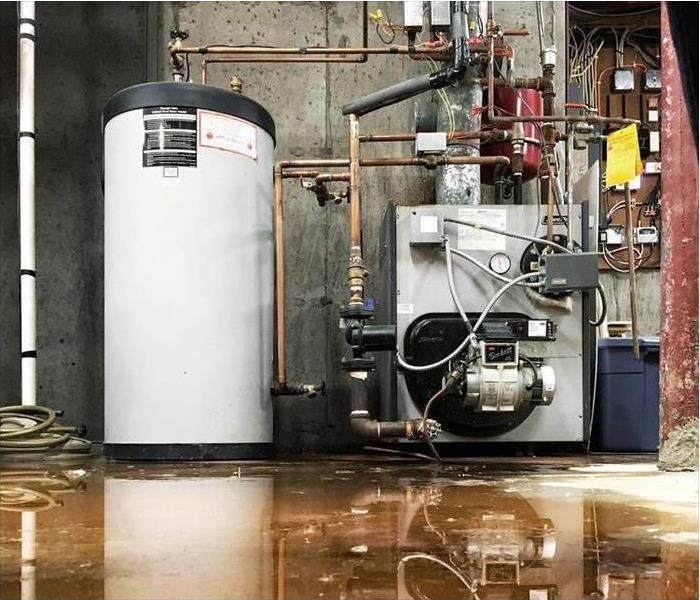 Furnace flood in Haller Beach, WA.
Furnace flood in Haller Beach, WA.
Furnace Floods Should Get Immediate Attention
You walked into work prepared for a busy day. You weren't necessarily ready, though, to handle the magnitude of a furnace flood. Overnight, a pipe burst, leaving you with a very wet, soggy mess of carpet and drywall. Now, unfortunately, you stand staring at a river in your basement, facing the task of trying to fix it. Is this a major problem? Yes, it really is. It's not a time to procrastinate or attempt a do-it-yourself method. Without a doubt, business owners dealing with this strife should seek assistance as soon as possible.
1. How Do I Know if the Furnace Is Okay?
Side on caution anytime water comes near a flooded furnace. It is a severe hazard. If water entered anywhere near the circuits or gears, an electrical fire could start. To ensure this doesn't happen, contact a water restoration company in Haller Beach, WA. The team can assess the damage, determining the best methods for cleanup. While you wait, shut off gas and electric to the area; then, remain elsewhere.
2. Does It Require Replacement?
Because a furnace flood poses a danger to the overall building, most often business owners may be asked to change out the unit. Bear in mind that water can seep into crevices, possibly rusting the interior of the device. If that happens, simply replacing circuitry or valves is not enough. For peace of mind, it's often best to get rid of the furnace and pick up something new.
3. What Other Precautionary Steps Are Needed?
It's possible moisture and microbes made it into the duct system. For this reason, don't neglect air duct cleaning. Your crew can ensure that the system is not only dried out but free of mold and particles.
When a furnace flood occurs, call in specialists to evaluate the severity of the situation. Using their background knowledge, they'll prepare a remediation plan and get to work, putting your establishment back together again.
4 Ways to Keep Your Garden Free of Mildew
6/14/2021 (Permalink)
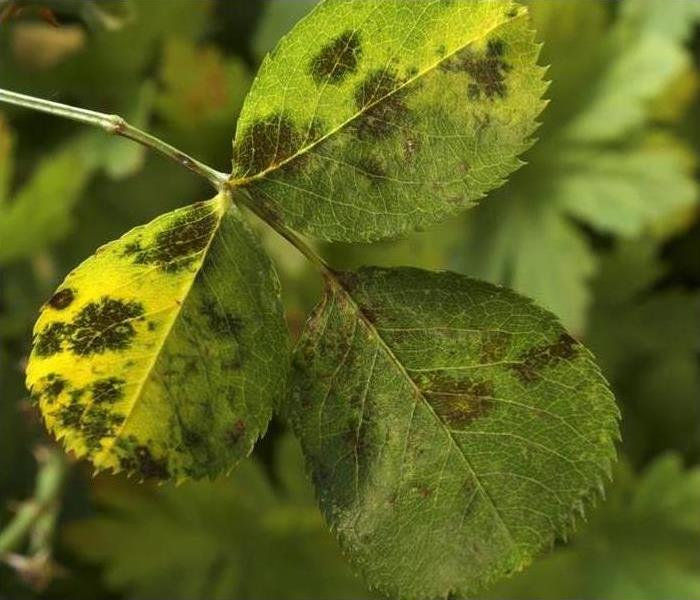 Prune your plants to remove mildew growth.
Prune your plants to remove mildew growth.
Techniques To Remove Mold Growth
Keeping a garden in Seattle, WA can be an enjoyable pastime, but sometimes problems can arise. If you notice a white, powdery substance forming on your plants, then you likely have a mildew problem. Plant mildew is a type of mold that only grows on plants. This can be harmful to them, so you should use the following techniques to remove the growth.
1. Wash Your Plants
In some cases, simply cleaning your plants with water can be enough to remove the mildew growth. Some plants are delicate, so be sure to take proper care when doing this. Using a spray bottle with plain water can remove most mildew.
2. Keep Leaves Dry
Although washing your plants with water is a good way to remove mildew that has already grown, keeping your plants dry can help prevent the mildew growth from returning. Plants absorb water in their roots, so there is often no need to water the leaves. If you notice mildew growing, water closer to the ground to avoid exposing foliage to excessive moisture.
3. Give Your Plants Space
While it may look nice to have many plants growing in a small area, this is not always best for the health of your plants. Leaving a larger space between plants will improve air circulation in the area to help keep moisture levels lower. It is also possible for plant mildew to spread between plants that are closer together.
4. Prune Infected Areas
In severe cases, you may need to prune your plants to remove mildew growth. Pruning the areas with high levels of mildew will not only remove the infection, but it will also allow more air to circulate around the plant and keep it dry. Mold and plant mildew need moisture to grow, so reducing excessive moisture is the best way to prevent this fungus from forming. If you have a problem with mold in your home, a clean up and restoration service can help remove it.
How Mold Can Happen Even in Dry Climates
6/11/2021 (Permalink)
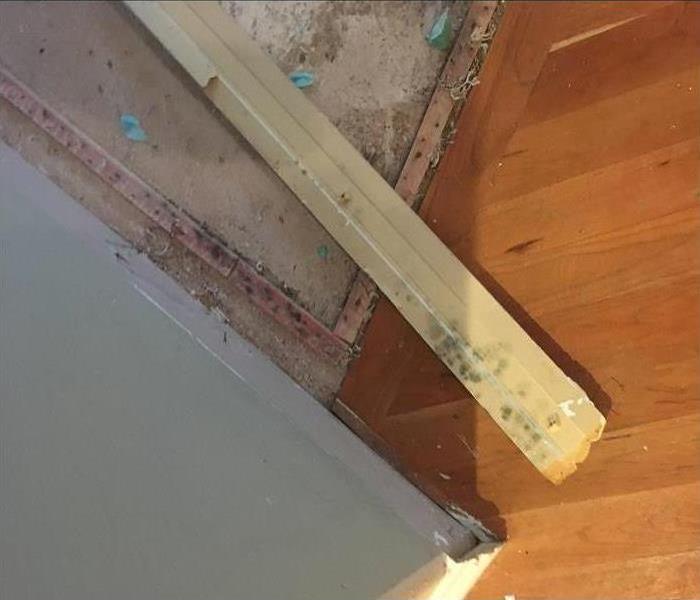 Mold growth on baseboard.
Mold growth on baseboard.
How Mold Can Happen Even in Dry Climates
As a commercial property owner in Wallingford, WA, you are likely keenly aware of fire safety measures, but do you consider the threat of black mold? Many property owners in this area feel that the dry climate protects them against the possibility of mold growth, but that is not true. Ask any mold remediation company, and they will tell you mold spores exist everywhere, meaning there is always a possibility for growth and damage. However, there are three likely causes for concern that you should watch for.
- Weather Damage
- Undetected Leaks
- HVAC or AC Systems
Weather Damage
Even in Wallingford, WA, rain and wind damage can be a problem for businesses. While monsoons don't frequently happen, when they do, buildings can suffer a significant amount of damage, especially to the roof. However, because of the lack of frequency of these storms, many property owners don't think to inspect their roofs for damage, which means that attic spaces can have water damage that goes unnoticed. If left unabated, water damage can lead to mold development.
Undetected Leaks
Other common causes of black mold and different fungal varieties are undetected leaks. Now, if you own a warehouse, this may not be as much of a problem for you because most of the facilities plumbing is open, making leak detection a breeze. However, if you own a more conventional or traditional building, the plumbing is typically situated behind walls, making early detection nearly impossible without the help of a plumber. Therefore, as a property owner, make sure to keep an eye on water bills and usage, ensuring that nothing is out of the ordinary.
HVAC or AC Systems
Mold cleanup also occurs quite often in HVAC and AC systems. These units typically have problems with condensation buildup, which can lead to mold. Therefore, check filters routinely and stick to annual inspections.
While not every mold is toxic black mold, all varieties can exist and develop even in dry climates. Therefore, it is necessary to be vigilant about the inspections and maintenance schedules of your commercial property.
What to Expect in a Fire Damage Restoration
6/9/2021 (Permalink)
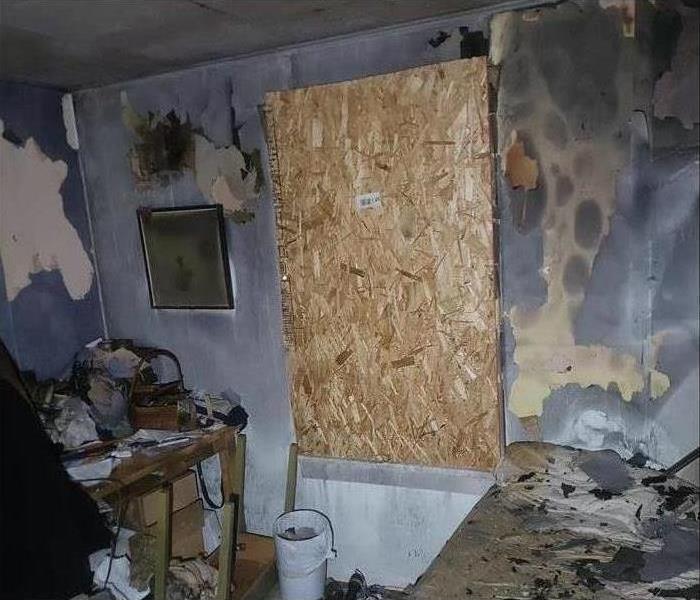 Board up services after a fire in Fremont, WA.
Board up services after a fire in Fremont, WA.
Basic Procedure For a Fire Restoration Project
Seeing your home go up in flames can be an emotionally draining experience. However, you have to act quickly to prevent further destruction. Any delay could potentially drive the damage cleaning costs through the roof as the structure sustains more water damage, and mold builds up in the walls.
Here’s the basic procedure for a fire restoration project in Fremont, WA:
- Initial contact
- Assessment
- Board up and tarp
- Cleanup and rebuilding
Call a Restoration Company
Call a fire restoration service as the first thing you do after getting off the phone with insurance. Regardless of the time of day, a representative from the cleanup service should pick your call and schedule an inspection ASAP. Consider that as an essential feature of a restoration company when shopping around.
Inspection
The cleanup service should come to check out the damage. During this visit, the expert will be assessing the extent of fire, soot, and smoke damage throughout the house. They will also identify things that can be salvaged and those that need replacement. At the end of this exercise, the service should be able to give an accurate quote for the job.
Board up and Tarp Services
On the first day of work, the restoration team will start by sealing any holes in the house. For example, if a fire burns a hole through the roof, sealing it will keep rainwater out, preventing further water damage and mold growth.
Clean up and Rebuilding
Your average restoration services will clean up the soot, get rid of burnt materials, and remove water from a fire-damaged home. Only the best will go the extra mile to rebuild the structure and make it habitable. Look for a service that covers cleanup to finishing work and everything in between.
Generally speaking, fire restoration is a multistep process that will breathe life into your burnt structure, making it a home again.
Top Reasons One Fire Alarm Isn't Enough
6/9/2021 (Permalink)
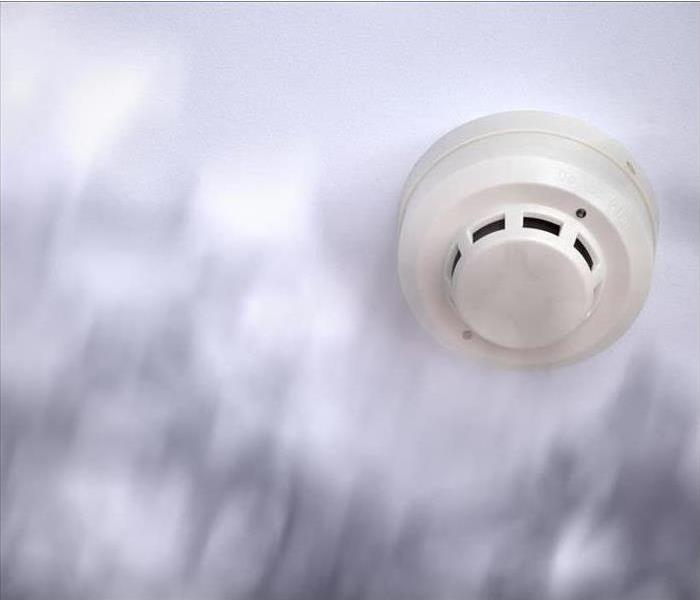 Having at least one fire alarm definitely increases your protection against a fire.
Having at least one fire alarm definitely increases your protection against a fire.
Reasons One Why One Alarm Isn't Enough
The value of smoke detectors has been well established. Experts estimate that having a fire alarm in your house can significantly cut the risk of fire damage or injuries. But many homeowners think just one alarm is enough to reduce the risk. The truth is that not having enough alarms in your Fremont, WA, home can be almost as bad as having none at all. In fact, there are several reasons why one alarm isn’t typically enough.Public awareness has made fire detectors one of the most common fire-prevention devices in a home. As a result of public awareness efforts:
- As many as 96 percent of American homes are believed to have alarms
- Smoke alarms have contributed to cutting the risk of home fire fatalities by nearly half
Clearly, any alarm is better than none. But to be effective, it’s key that you have more than just one.
One Per Room
It’s natural to think that an alarm in a common area is enough. But experts say at a minimum, you should have one alarm per room. This can help protect your property against fires that can start in unexpected places like bathrooms.
Bigger Means More
A typical detector is only effective for about a 900 square-foot area of a building. Use your home’s measurements when buying detectors. For example, a 2,000 square-foot home should have at least three alarms.
Level Up
Fires that start on one level often result in destruction to other levels of the home. This can be prevented by having detectors on every level, which experts suggest.
Having at least one fire alarm definitely increases your protection against fire. Take things a step further by equipping your home with the ideal number of alarms. Use these tips or talk to your local fire and smoke damage cleanup experts to learn more about how many alarms your home truly needs.
How Do You Get a Mold Assessment for Your Home?
6/1/2021 (Permalink)
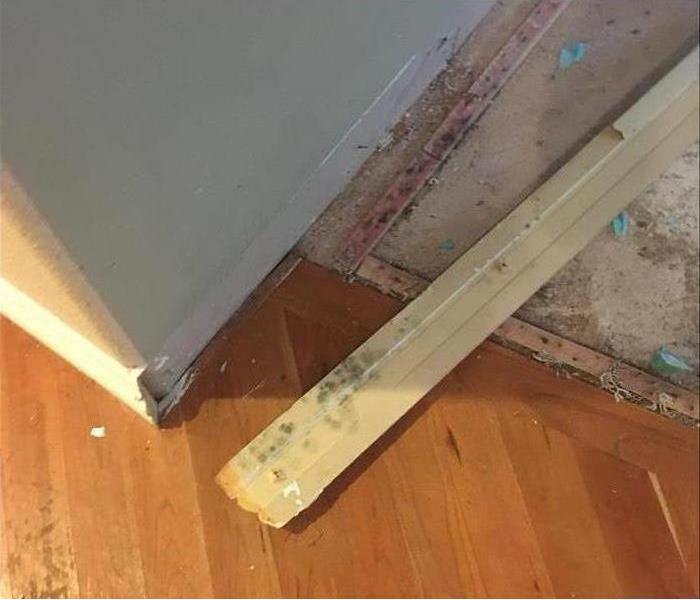 Mold found behind baseboard.
Mold found behind baseboard.
Before a home can have its mold problem addressed, it needs to have a high-quality mold assessment done. There are two basic ways to do this: either run a DIY test or have a professional inspection. In all cases, experts recommend having a professional do it.
What Is Black Mold?
In its natural environment, mold is kept in careful check by the sun. It can only grow in areas almost continuously in shade and subject to dampness. It also must compete with other fungi for the nutrients needed for its growth when it grows outside.
All mold needs lots of moisture to grow. Inside a home, this normally comes from sources such as
- Plumbing leaks
- Sewer leaks
- Roof leaks
Mold can really find a safe harbor indoors. It loves to grow on cellulose, such as that found in wallboard and wood. Plus, mold spores are everywhere, with hundreds found in a typical cubic meter of air. This is normally harmless and of no concern. However, it becomes a problem when exposed to frequent excess moisture.
What Is a Mold Assessment?
When a mold remediation expert in Haller Beach, WA, performs an inspection, it doesn’t just include a test. They bring commercial equipment, such as a hygrometer and infrared camera, to search for hidden water leaks.
Black mold is a serious problem, but even worse is the water damage being caused by the leak. If it goes on long, it can easily cause thousands of dollars in damage – and it might not be covered by insurance if you’re found negligent. Indoor mold growth is always a key sign of dampness getting where it shouldn’t, so never ignore it.
However, it differs from mildew. Mold only grows on porous surfaces with nutrients available as food. Mildew grows on grout and tile and usually can be easily cleaned up by the homeowner with a solution of bleach and water.
A good mold assessment can find hidden water leaks before they cause severe damage. A simple DIY test isn’t enough information to make a proper appraisal, though.
3 Reasons Why Your Business Should Purchase a Flood Insurance Policy
6/1/2021 (Permalink)
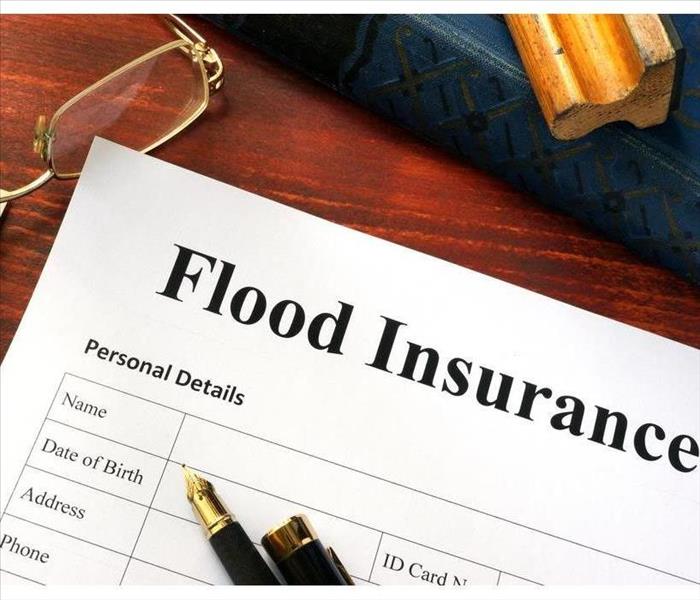 It is often a good idea for your business to purchase additional flood insurance.
It is often a good idea for your business to purchase additional flood insurance.
Reasons To Purchase Flood Insurance
If you own a business in North Beach, WA, you probably already have some kind of commercial insurance. However, your policy might not cover everything. Buying additional flood coverage might add to your company’s expenses, but it is often a good idea anyway. The following are some reasons why.
1. It May Be a Requirement
Sometimes, flood insurance is a requirement rather than an option. If you are located in an area that experiences flooding often, then this will probably be the case for you. It is required to purchase this extra coverage if you have a mortgage with an insured or federally regulated lender.
2. Flooding is Likely Not Included in Your Basic Insurance Plan
Even if you are not required to buy additional coverage, you may want to do so anyway. This is because flooding is usually not included with basic commercial insurance. In the event of a flood, your building could experience severe damage that will not be included in your insurance claim. This type of insurance can be helpful even in areas that do not have a high risk of flooding since the weather can be unpredictable.
3. Restoration Can Be Expensive
Without flood insurance, you will have to pay for any flood damage on your own. Because this kind of damage can be extensive and may affect many areas of your building, the cost of repairs can be high. Restoration after a flood can include rebuilding certain parts of the building, repairing or replacing damaged furniture and electronics, and removing mold growth. If you do not have coverage, this work can have a big financial impact on your business.
Because your basic insurance does not likely include floods, it is often a good idea for your business to purchase additional flood insurance. This will be a huge help if you need to hire a water damage remediation company to make repairs after a flood. Otherwise, you may be stuck paying the bill out of your company’s funds.
4 Things Landlords Can Do To Reduce Plumbing Maintenance Costs
6/1/2021 (Permalink)
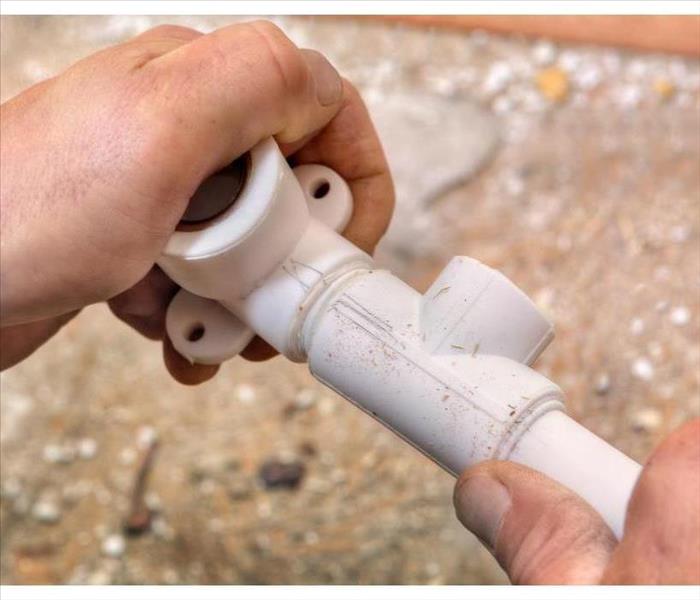 Your polybutylene pipes require basic monthly maintenance and special treatment.
Your polybutylene pipes require basic monthly maintenance and special treatment.
4 Things Landlords Can Do To Reduce Plumbing Maintenance Costs
Landlords are responsible for maintaining the plumbing in their rental units. Fortunately, they can do a few things to reduce the total cost they pay for maintenance and repairs.
1. Regular Maintenance
Landlords are required to provide a property that is livable throughout the entire stay of their tenants. One of the best ways to fulfill this responsibility and lower the chances you will have to pay for a water remediation company in Fremont, WA, is to perform regular maintenance. This means ensuring that even your oldest polybutylene pipes receive regular treatments. Additionally, it also means taking measures to prevent clogs and other plumbing issues.
2. Check Working Condition
One way to check the working condition of polybutylene pipes is to have an inspection conducted. Regularly doing this will alert you to any small clogs and weak spots in your pipes that need to be fixed before they worsen.
3. Check Tenant’s Behavior
Your polybutylene pipes require basic monthly maintenance and special treatment. Therefore, you want to make sure that your tenants don't put fats, grease, and other oily substances down the drain that can trap hair, soap scum, and food particles and cause plumbing issues. This includes not only sink and shower drains but the toilet and laundry pipes as well.
4. Transfer Risk to Another Party
Regular maintenance can reduce your chances of plumbing issues, but it cannot eliminate the threat. Earthquakes, tree roots, and misuse can still be sources of problems, so you should take measures to transfer the risk to other parties. This means getting a proper insurance policy for problems outside of your control and having a plumbing clause in your lease that requires your tenants to take responsibility for their actions.
As a landlord, you are responsible for the plumbing maintenance in your units. To lower these costs, you should take action to prevent excessive water damage and limit your liability.
How Property Managers Can Prepare for Storm Damage
5/30/2021 (Permalink)
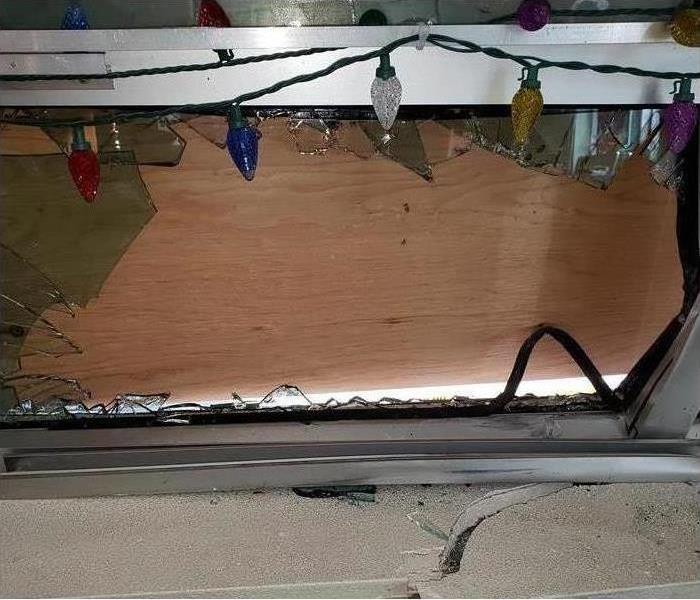 Taking storm preparedness seriously is vital for anyone who works in property management.
Taking storm preparedness seriously is vital for anyone who works in property management.
As someone in property management, you know there are various risks that you face each day. One of the costliest dangers that you must prepare for is storm damage. Without proper preparation, a storm can cause severe harm to your property and lead to steep repair and replacement costs. However, equipping yourself for the next storm on your Broadview, WA, property is only a matter of following a few simple steps. Here are some essential storm preparedness guidelines to follow before a natural disaster targets your area.
Gather Relevant Information
Having all of your information in place before a storm will allow you to feel in control once the bad weather hits. Be sure to verify that you have the following key pieces of information well in advance of the storm:
- Updated contact info from renters
- Renters’ emergency contacts
- Contact info for service providers (roofers, general contractors, etc.)
- Current service agreements
Taking inventory of this necessary information ahead of time can prevent you from feeling unprepared in the event of a storm.
Prepare Your Renters
It’s completely natural for your renters to feel nervous or overwhelmed at the thought of an imminent storm. That’s why a crucial storm preparedness guideline is to clearly communicate with residents so that they understand what to do in a severe weather event. The more informed your renters are, the more confident they will feel.
Take Every Detail Into Account
To be as prepared as possible before a storm, you need to create an elaborate plan that takes every potential risk into account. Everything from employee roles to your insurance policy should be included in your emergency plan. For extra safety, be sure to outline what each employee should do before, during and after the storm to ensure that they have adequate guidance every step of the way.
Taking storm preparedness seriously is vital for anyone who works in property management. To keep your building in optimal condition after the weather incident, be sure to contact storm damage restoration professionals immediately.
How Do Partial Losses Differ From Total Losses?
5/3/2021 (Permalink)
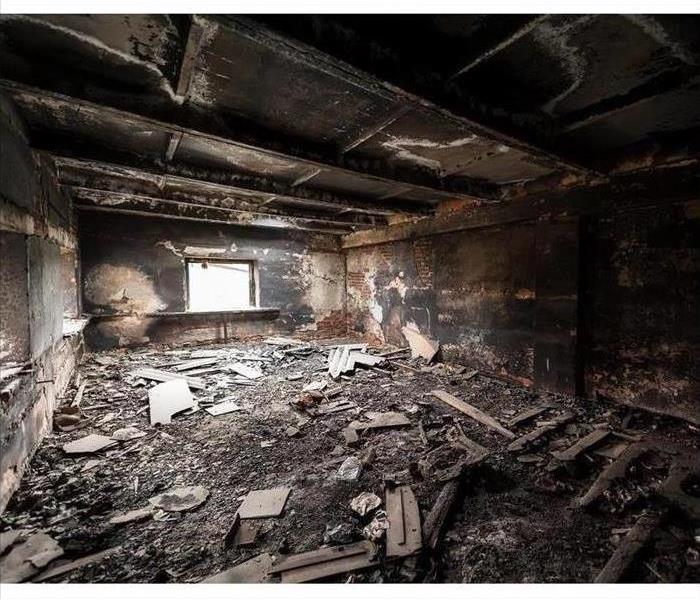 In the event of a partial fire loss, cleanup and restoration experts should check for hidden damage.
In the event of a partial fire loss, cleanup and restoration experts should check for hidden damage.
A partial loss indicates that a structure was not irreparably damaged. In general, this level of damage may require restoration and repairs, but not a complete rebuild. Find out how to determine the extent of fire loss at a commercial building in Wallingford, WA.
The Damage Is Limited
If a particular area of a structure has sustained fire damage while other areas are only affected by heat or smoke, the loss is likely to be partial. The following are some of the most common forms of partial loss:
- Burnt or charred building materials or contents
- Heat-damaged building materials or contents
- Smoke-damaged building materials or contents
Buildings that remain structurally sound can still suffer an extensive partial loss. An actual total loss involves a situation in which a property has burned down or sustained such extensive structural damage that a complete rebuild is necessary.
Restoration Is An Option
A fire loss is likely partial if a building can be cleaned and restored. This even applies to situations in which a certain portion of a structure sustains significant damage and may have to be rebuilt, but the building remains structurally sound on the whole and safe for occupation after cleaning and restoration.
Contents Can Be Restored or Replaced
Fire damage at a commercial building is likely to involve damaged contents. Getting a professional verdict on the condition of equipment can facilitate claim settlement. Any assessment should account for fire, heat, and smoke damage. It is helpful to have an insurance policy that covers replacement costs rather than actual cash value with depreciation.
In the event of a partial fire loss, cleanup and restoration experts should check for hidden damage. Fire damage that appears minor may actually be more extensive. Experienced fire restoration professionals can inspect and accurately identify the extent of loss for the purpose of making a commercial property insurance claim.
Basic First Aid Procedures for Burns
4/24/2021 (Permalink)
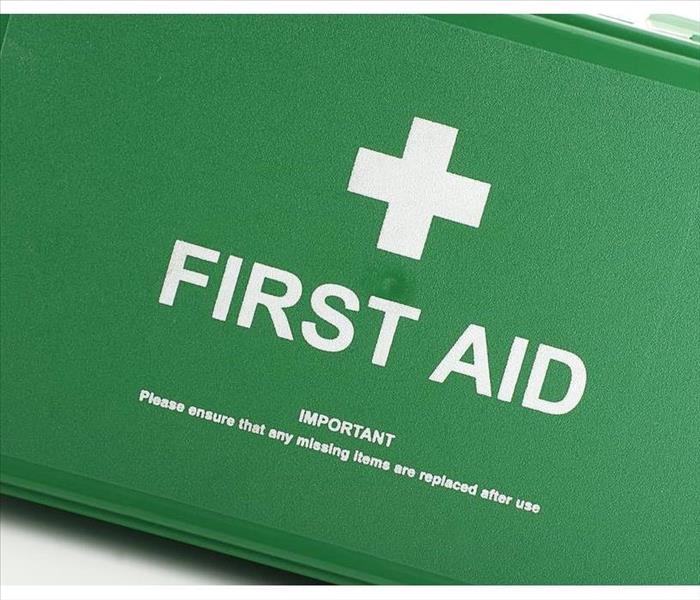 Basic burn first aid is a valuable skill for anyone to have.
Basic burn first aid is a valuable skill for anyone to have.
When a fire breaks out in a commercial building, there is always the possibility of personal injury in addition to fire damage to property. A company should work to educate employees on how to handle burns, minor cases of smoke inhalation and instances of stress. Anything too serious such as severe burns or damaging respiratory injuries should be left to medical professionals. In these cases, the responsibility of employees is to call for emergency personnel and keep the patient comfortable. Basic burn first aid is a valuable skill for anyone to have.
The Treatment of Minor Burns
With burns, it is important to start with the basics. First, the person in the position of administering first aid should make sure the scene is safe. This includes watching out for areas of fire damage. The next step is to remove the injured person from the fire or hot element if possible and then cool down the burn, usually with cold water. Further treatment should proceed as follows:
- Gently remove any rings or jewelry near the burn
- Elevate the burned area if possible
- Do not break any blisters on the skin
- Apply a lotion containing aloe vera or other moisturizer
- Bandage the burn with sterile gauze
Mild pain relievers can be given to reduce pain. The injured person should also be monitored for signs of shock.
The Remediation of Property Damage
Soon after a business fire in Ballard, WA, fire restoration efforts should begin. A quality fire mitigation company has the necessary knowledge and equipment to deal with nearly every aspect of a fire. Trained technicians will start with a rapid inspection and assessment of the property and then proceed with a plan of action. They will work quickly and efficiently to restore the building to its original condition.
Both fire damage and injuries are often the unfortunate consequences of a fire. With proper actions, the scope of these negatives can be reduced.
How To Dry Out a Building After a Pipe Burst
4/21/2021 (Permalink)
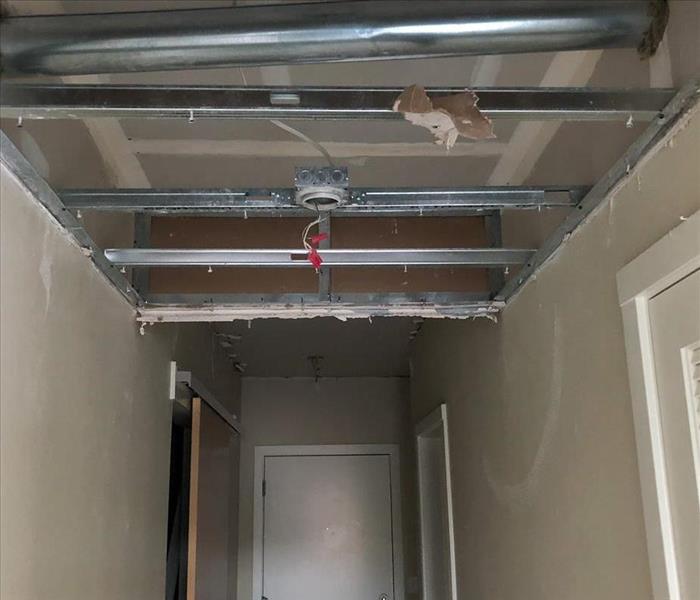 There’s never a convenient time for flooding or water damage to strike your business.
There’s never a convenient time for flooding or water damage to strike your business.
When a pipe bursts in your building, you need to think quickly and stay on your toes to avoid more problems like mold growth. The best way to go about restoring the property after water intrusion is to first ensure that your building is as dry as possible. While you are waiting for experts to arrive, there are things you can do that will speed up the drying process. Here are some damage tips to keep in mind when drying out your Seattle, WA building.
1. Assess the Damage
Following a pipe burst, the first thing you’ll want to do is to mindfully walk around your property and document any problems. Although diving into cleanup will increase your chances of salvaging parts of your property, there will likely already be some things that are beyond minor repair. Accurate documentation will aid you when you speak with your insurance company about these damages.
2. Let In the Breeze
Natural air is often the best way to dry out your building. One of the best damage tips you can follow is to immediately open the windows in any of the rooms that have been affected by the water. You can also bring in fans, which will offer additional circulation in places that outside air may not be able to reach.
3. Get Rid Of the Water
You can tackle standing water with a wet/dry vacuum to ensure that some of the moisture is removed from the building right away. Other important cleaning tips are to grab any soaked furniture or rugs and place them outside. They can dry in the fresh air, and the water in your building will evaporate faster without the added moisture of wet fabric.
A burst pipe most definitely warrants a visit from a professional water removal specialist to help with the cleanup. In the meantime, these damage tips can help you jump-start the drying process.
Tips for Grilling Safely
4/18/2021 (Permalink)
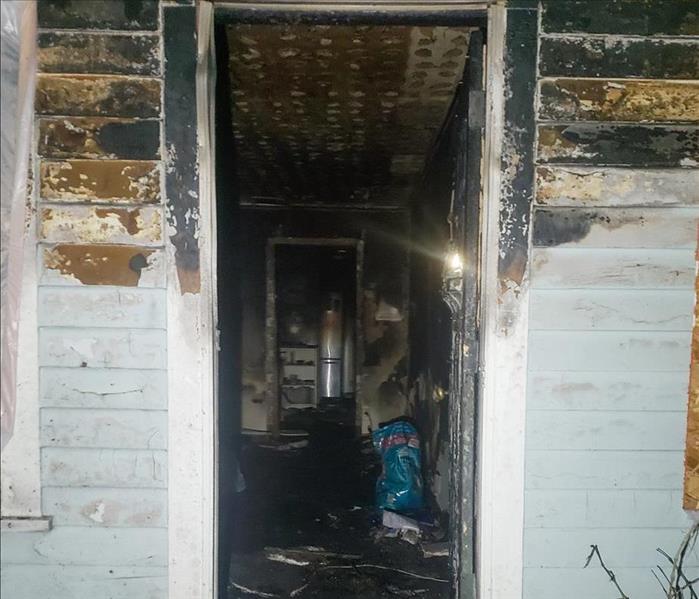 When your Seattle home or business experiences fire or smoke damage, you need professional help quickly.
When your Seattle home or business experiences fire or smoke damage, you need professional help quickly.
If you enjoy grilling at your Seattle, WA home then you may already know some of the important safety steps for avoiding a grill fire. If you’re new to grilling, then some of these tips recommended by many fire damage professionals may help.
1. Before You Grill
One way to help prevent a barbecue fire before you even begin to cook, is by placing your grill in a safe location. It’s recommended to have a debris free area away from the house, awnings or overhanging trees. It’s also recommended to clean your grill before use, and on propane units to check all the connections to ensure there are no leaks.
2. While You Grill
There are also steps to help avoid a grill fire while you cook. Never leave your grill unattended, and keep children and pets away from the unit while it is on. Keep an eye out for any embers or sparks that may occur during the cooking process to ensure they don’t land anywhere where they can catch. If you smell gas while using a propane unit turn the grill off immediately. If the smell persists call the fire department.
3. After You Grill
You can help prevent fire and smoke damage by following safety steps after you finish cooking. Ensure that your grill is properly turned off after use, or if using a charcoal grill that all the coals or embers are completely cool before they are removed from the grill. Follow the manufacturer's instructions for proper cleaning.
With the right safety steps in place you can prevent a grill fire at your home. Keep your grilling area clear of debris, make sure the grill is placed away from any area where sparks could catch while you cook, and always make sure any embers are put out when the grilling is complete. If you do experience a fire, a restoration professional may be able to help.
3 Ways to Be Rid of Smoke Odors Fast
4/15/2021 (Permalink)
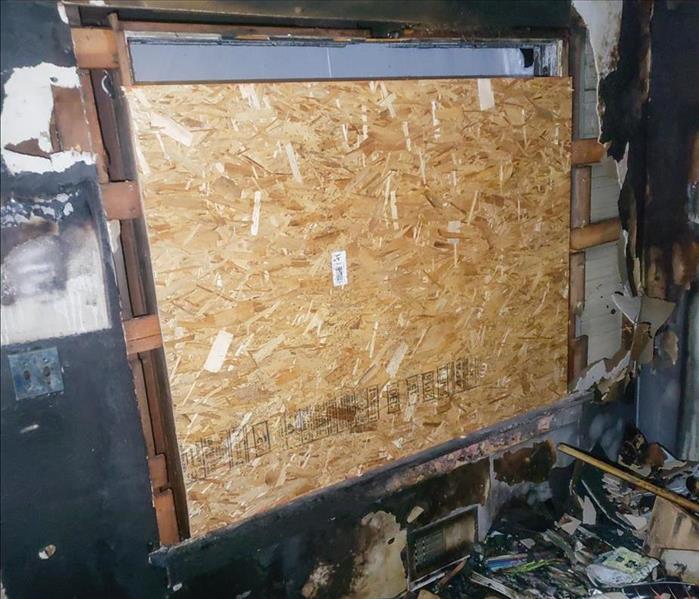 Our Seattle area SERVPRO team is trained to address small and large fire damage projects.
Our Seattle area SERVPRO team is trained to address small and large fire damage projects.
Whether the result of a fire or merely of a guest with a habit, smoke odors can be tough to get rid of. When smoke has infiltrated your Seattle, WA home, smoke cleaning is in order. Do you know what to do? Start with these three tips and you’ll be rid of smoke odor fast.
What Causes the Smell
Smoke can cause odors by direct contact with materials or via getting into a building’s HVAC system. Smoke can penetrate things like
• Furniture
• Walls
• Carpets
Smoke smells can be tough to get rid of, but there are a few steps that can help.
Remove the Source
Removing the source of smoke smells is one of the most obvious steps to take. Furniture in an area frequented by a smoker can hold odors and may be a loss. In the event of a fire, items that are extensively exposed in the room whether the fire started can be a big source of smell, so you’ll want to get rid of them as part of your smoke cleaning efforts.
Clean What You Can
Particularly after a fire, it’s tempting to toss out the obviously damaged items and move on. But even things that aren’t destroyed can be reservoirs for smoke damage. Use a wet sponge to wipe down porous surfaces and a dry one for less porous materials.
Use an Odor Counteractant
For the best results, you may want to invest in an ozone treatment. Ozone is what causes the fresh, clean scent we sense after rain. Ozone treatment works by exposing smoke damaged surfaces to ozone gas for a set amount of time. This is typically highly effective.
Air quality can have a huge impact on your quality of life. If smoke odors persist in your home, try the above tips or reach out to an expert in ozone smoke cleaning to get the stink out.
Commercial Building Restoration Services
4/10/2021 (Permalink)
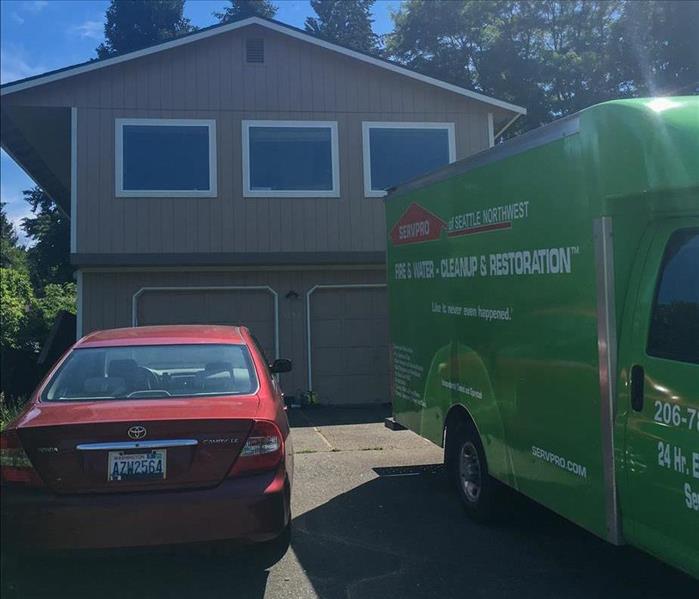 When a storm hits your Seattle business, you need the company with storm damage experience and expertise.
When a storm hits your Seattle business, you need the company with storm damage experience and expertise.
Commercial Building Restoration Services
When fires or water damage happen, they may occur at your office or business. Who do you call? Knowing the right company to help in an emergency is important to get your Seattle business back up and running as quickly as possible.
SERVPRO of Seattle/Northwest is available 24/7 to help you restore your Seattle commercial property and get you back to business. We have the expertise, equipment, and highly trained personnel to handle your commercial water, fire, or mold damage. We can also access the resources of our national network of 1,650 Franchises to handle large commercial projects and major storm events. Learn more about our commercial restoration services:
Commercial Services
- Overview of Commercial Services
- Commercial Restoration
- Commercial Water Restoration
- Commercial Fire Restoration
- Commercial Mold Remediation
- Commercial Storm and Major Events
- Disaster Recovery Team
- Commercial Cleaning
Call Today!
(206) 789-2300
SERVPRO of Seattle/Northwest
3 Ways to Mitigate Wind Damage
4/9/2021 (Permalink)
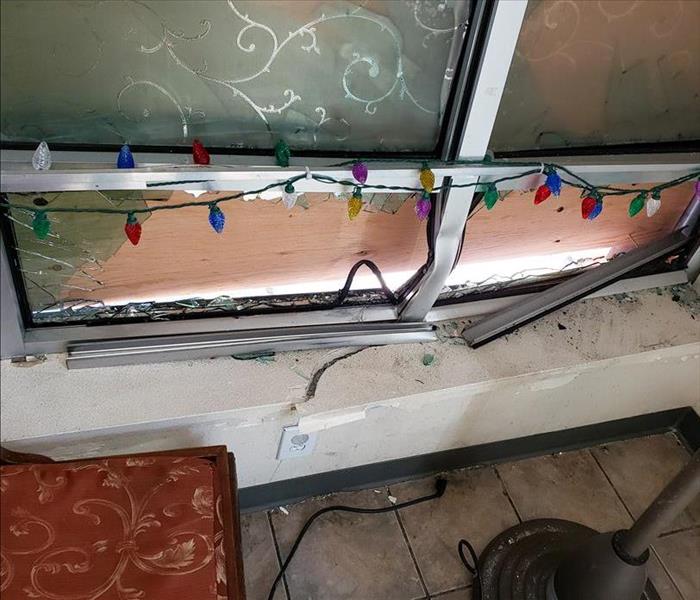 Commercial storm damage.
Commercial storm damage.
Three Ways To Limit Wind Damage
Damage caused by wind can occur alongside storm damage or separately due to strong gusts. In the worst-case scenario, wind damage to the roof, windows or any other part of a commercial structure could result in a roof leak or expose the interior. Here are three ways to limit wind damage to the exterior and interior of a commercial building located in Wallingford, WA.
1. Inspect a Structure for Wind Damage
After a windstorm subsides, the owner or manager of a commercial building can identify several signs of damage. Missing shingles may be evident on a pitched roof or on the ground. It may also be helpful to go up on the roof or arrange for a professional roof inspection after windy weather.
2. Board Up or Tarp Over Breaches
Any breaches in a structure should be covered. While missing roofing materials may lead to a roof leak, a broken window or damaged door can leave a building open to the intrusion of flying debris, rain or trespassers. Board up accessible openings in a building or use tarps and anchor boards to prevent rain from penetrating into damaged roofing until repairs take place.
3. Restore Damage As Soon As Possible
It is a good idea to repair a damaged roof or other types of damage caused by wind sooner rather than later. Even if high winds are expected to continue, a well-maintained or recently repaired structure may be less susceptible to repeated damage, whereas a structure that has already sustained damage may suffer more severe storm damage.
High winds can cause a roof leak and damage the enclosure of a commercial building in Wallingford, WA. If loose flashing or the failure of a window or door compromises any part of a structure, storm damage restoration will be necessary to address external problems that expose a building interior to storm damage.
Simple cleaning tips for tackling mold and mildew in your Seattle NW home
4/7/2021 (Permalink)
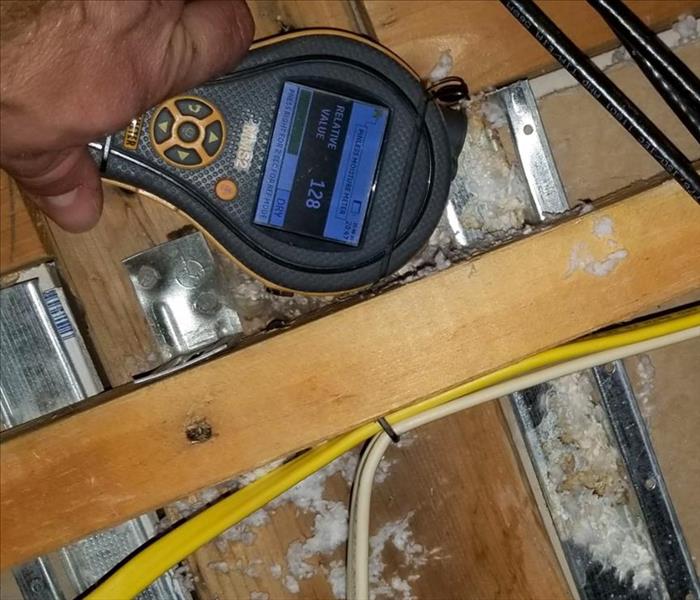 Mold can begin growing in as little as 48 hours after a water loss.
Mold can begin growing in as little as 48 hours after a water loss.
Dealing with nasty mold and mildew are common cleaning issues that can arise within your home or business. Unfortunately, our Seattle climate can give mold and mildew the perfect conditions to grow and thrive in, and can be found anywhere from damp clothing to upholstered furniture and carpets.
When you find mold and mildew on your furniture and carpets, and need professional help to get rid of it properly, our expert service professionals at SERVPRO of Seattle Northwest will use our state of the art equipment to help you take care of your mold issue quickly and safely.
However, if your mold and mildew problems are less catastrophic here are a few simple tips to help you remove mold and mildew from…
...white-cotton clothing
Apply a solution of one part bleach to three parts water to the stain and allow the solution to sit for 5-10 minutes, then wash as directed.
...non-bleachable clothing
If the article of clothing cannot be bleached, try removing the mold with lemon juice or white vinegar. Soak a cotton pad in lemon juice or vinegar and place it on the stain. Allow the solution to soak for several minutes. Then, remove the cotton pad, and sprinkle the area with some salt to further boost the effect of the acid. If possible, place the item in a sunny spot to dry. The sun rays will also bleach stains. Repeat as needed, then wash the garment as usual.
If the mildew stain persists, bring the article to a professional dry cleaner.
...grout and walls
To clean mildew and mold effectively from walls and grout, mix a solution of one part bleach to three parts water. Dampen (don’t soak) a sponge with the solution and apply it to the moldy areas. As the mildew disappears, dry the area using an old towel.
...upholstery
If your upholstered furniture has water damage and a substantial amount of mold growth, it should be replaced.
However, if there's only a small mold stain, you can try using a 3% hydrogen peroxide solution. Blot it on the mold and allow it to work for a minute or so. Rinse solution from the area by alternately dabbing it with a damp cloth or sponge and a dry cotton cloth. This probably will not remove the mold, but it may help lessen the stain.
Consult a professional if the stain persists or reappears.
...carpet
Be very careful dealing with mold on your carpet, its best to get the opinion of a certified mold expert, and let them safely remove any substantial amount of mold from your home or business.
If you need assistance for water or mold clean up & restoration, give SERVPRO of Seattle Northwest a call at (206) 789-2300
We're available 24/7 for emergency services.
What You Should Do When Dealing with Fire Damage in Your Seattle Home
4/4/2021 (Permalink)
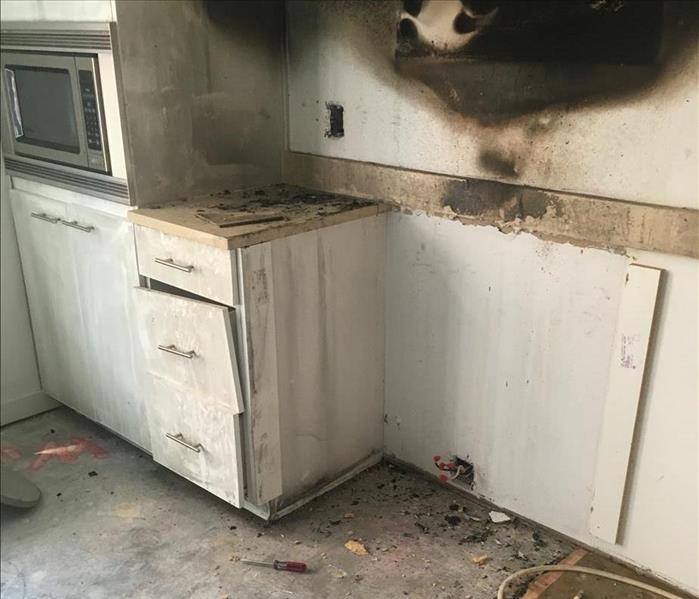 Our Seattle area SERVPRO team is trained to address small and large fire damage projects.
Our Seattle area SERVPRO team is trained to address small and large fire damage projects.
Life has enough interruptions and bumps along the way without the unwanted disaster of a house fire. The aftermath is almost as bad but much longer-lasting. Even small fires can use the assistance of a professional cleanup/restoration company. Cooking fires that spread beyond the stove, barbecue grills that go up in smoke, and even small appliances that catch fire can cause damage to surrounding areas.
Small Fires can Pose High Risks
While you should never pour water on a grease fire, nor on an electrical one, many times that is a person's first reaction anywhere. This can cause even more damage. Cooking fires and electrical shorts are common causes of Seattle home and business fire damage. It can also create physical risks to people standing nearby. With grease fires, baking soda should be poured into the pan and any grease or oil that has caught fire outside of the cooking pan or skillet instead of water.
With electrical fires the appliance should be unplugged if it can be safely done, but not by pulling on the cord. This can cause the cord to snap, leaving the plug, without the cord, still in the outlet. The power to the area where this is happening should be shut off at the fuse box as quickly as possible to eliminate the hazard.
After the Fire is Out, It's Time to Repair the Damage
When there's been a localized fire, you should have someone assess the damages for you. This can often help with insurance documentation.
Damage can range from blackened walls and countertops to heavily burned surfaces, electrical wires being damaged and requiring replacement, to floors suffering damage so severe they must be replaced to be safe again. Having experts conduct the repairs needed can expedite insurance claims being resolved, as well.
Locally Owned Company with National Resources
At SERRVPRO of Seattle Northwest, we have highly trained and skilled professionals who are experienced in all sizes of fire damage clean up and restoration. We are available 24 hours a day, seven days a week to help clean up and repair fire damage, no matter how large or small. Call us at (206) 789-2300 to get the necessary damages repaired, and the mess eliminated so you can go back to your daily routine.
Protecting Your Seattle Northwest Home from Storm and Water Damage
3/30/2021 (Permalink)
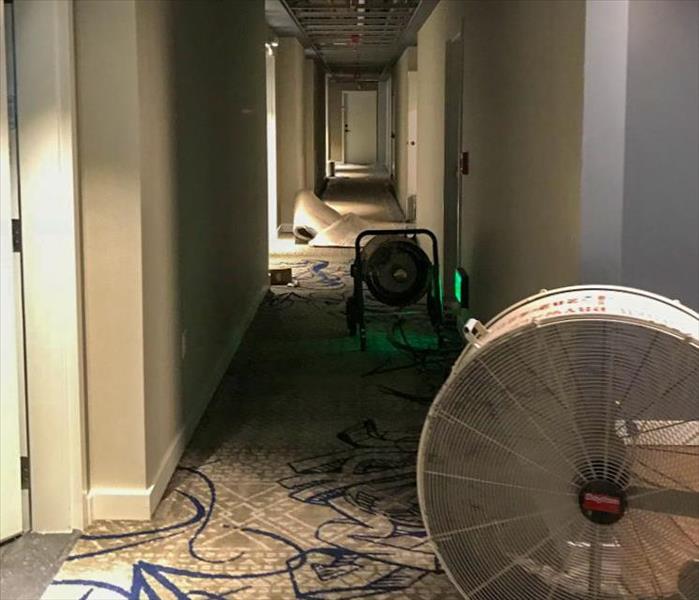 From ceiling fixture leaks to flooding after natural disaster, SERVPRO is here to help.
From ceiling fixture leaks to flooding after natural disaster, SERVPRO is here to help.
Flooding in your home can happen at any time, but your home can be even more exposed to water damage when it rains. As we move into the late Winter and early Spring months here in Seattle, storm damage can become more of a threat to your property. Follow these tips to help protect your home from water damage during the next rain storm.
- Modify your homes water valves. If the city's main sewer line gets backed up during a heavy rain storm, you could find yourself standing in a a puddle of you-know-what. You may want to consider installing an interior or exterior backflow valve. Backflow valves prevent your water system from being contaminated from water flowing backwards into your supply lines.
- Clear gutter, drains, and downspouts. Clogged gutters and downspouts can end up in a messy flood. Take the time to clean them and clear them of all debris before the rain comes.
- Cover air vents. One of the most common ways water finds its way into a home is through the home's air vents. If you know that heavy rain is in the forecast and that you are at risk of flooding, cover your air vents with thick plastic sheeting from both the outside and the inside.
- Check your sealant surrounding doors and windows. Make sure that any gaps or holes in the sealant surrounding the doors and windows are filled in. This will help stop rain water from finding its way into your home.
If water still manages to find a way into your home and you need assistance for water/mold clean up & restoration, give SERVPRO of Seattle Northwest a call at (206) 789-2300
We're available 24/7 for emergency services.
Rain Storms and Gutter Maintenance
3/24/2021 (Permalink)
It's the beginning of the rainy season here in the Pacific Northwest, and SERVPRO of Seattle Northwest is here for you!
Preventative maintenance is the best way to prepare for the wind and rain storms that are heading our way.
Gutters help catch rainfall and ensure it stays away from the foundation of your home. If your gutters get clogged with ice or debris that piles up during the season, your gutters can't do their jobs. We all know there are giant leaves EVERYWHERE right now, so just make sure they don't stay in your gutters.
Clean your gutters by spraying a hose through them from the bottom up. Use a scoop or towel to remove any clogs in your gutters, or you can purchase a hose attachment tool that is specifically designed for cleaning gutters.
It is crutial that you check your home for signs of leakage. Fixing a leak early on can prevent flooding, mold, mildew and even a collapsed ceiling. Scan your ceilings for water marks and look for peeling paint.
You should also check the outside of your home for any telltale signs of leakage.
Make sure there are no cracks in the ridges of your roof. Wind can cause roof damage, so keep an eye out for loose, curled, or missing shingles. If you do have roof damage, water can enter your home.
Cleaning your gutters is a quick and easy way to protect yourself from the harsh weather heading our way!
An ounce of prevention can save you from having gallons of water inside your Seattle home!
How To Prepare for an Emergency
3/18/2021 (Permalink)
 Test your smoke alarms monthly to prevent a fire to become dangerous to your family.
Test your smoke alarms monthly to prevent a fire to become dangerous to your family.
How To Prepare for an Emergency
You hope you’ll never have to leave your Greenlake, WA home in a rush because of a fire. It is wise to create a fire escape plan for your household, however. Preparing your family in advance will help them make smart decisions when they have to act fast.
1. Consider Special Needs of Family Members
Make sure you account for children and elderly family members who need assistance leaving the house. Smoke alarms don’t always wake children up, so assign someone to wake them and help them exit. Consider involving your kids in the planning stages of the emergency escape plan so that they feel more connected to the process.
2. Establish Exits and Meeting Spot
Think about each room in the house and find two ways out. This could be a door and a window, but make sure it is easy to open. Choose a meeting spot away from the house outside, preferably at the end of the driveway. This helps emergency responders see that everyone is safe. Emphasize the importance of not returning to the house for any items.
3. Check Smoke Alarms
Your fire escape plan should include inspecting the alarms frequently to ensure they work. Change the batteries at least twice a year as well. The National Fire Protection Association recommends that you place one alarm in each bedroom, as well as one in the hallway near the bedrooms. Each level of the house should also have at least one alarm. In addition, place one in the kitchen.
4. Practice the Plan
To ensure that everyone is prepared, go over the plan and practice the escape at least once each year. Children especially will be less likely to panic if they feel confident about the routine. Keep the emergency number of a fire restoration service handy as well.
Prepare in advance to keep your family safe with a fire escape plan.
Water Damage Timeline
3/16/2021 (Permalink)
Flooding and water emergencies don’t wait for regular business hours and neither do we. SERVPRO of Seattle Northwest provides emergency cleaning and restoration services 24 hours a day, 7 days a week—including all holidays.
Faster to Any Size Disaster
Flooding and water damage is very invasive. Water quickly spreads throughout your home and gets absorbed into floors, walls, furniture, and more. SERVPRO of SERVPRO of Seattle Northwest arrives quickly and starts the water extraction process almost immediately. This immediate response helps to minimize the damage and the cleaning and restoration costs.
Need Emergency Service? Call Us 24/7 – 206-542-1226
Water Damage Timeline
Within Minutes
· Water quickly spreads throughout your property, saturating everything in its path.
· Water is absorbed into walls, floors, upholstery, and belongings.
· Furniture finishes may bleed, causing permanent staining on carpets.
· Photographs, books, and other paper goods start to swell and warp.
Hours 1 - 24:
· Drywall begins to swell and break down.
· Metal surfaces begin to tarnish.
· Furniture begins to swell and crack.
· Dyes and inks from cloth and paper goods spread and stain.
· A musty odor appears.
48 Hours to 1 Week:
· Mold and mildew may grow and spread.
· Doors, windows, and studs swell and warp.
· Metal begins to rust and corrode.
· Furniture warps and shows signs of mold.
· Paint begins to blister.
· Wood flooring swells and warps.
· Serious biohazard contamination is possible.
More Than 1 Week:
· Restoration time and cost increase dramatically; replacing contaminated materials and structural rebuilding may be extensive.
· Structural safety, mold growth, and biohazard contaminants pose serious risks to occupants.
About SERVPRO of Seattle Northwest
SERVPRO of Seattle Northwest specializes in the cleanup and restoration of residential and commercial property after a fire, smoke or water damage event. Our staff is highly trained in property damage restoration. From initial and ongoing training at SERVPRO’s corporate training facility to regular IICRC-industry certification, rest assured our staff is equipped with the knowledge to restore your Seattle property.
Prepare Your Home For A Wind Storm: Top 6 Ways To Protect Your Home!
3/16/2021 (Permalink)
Top 6 Ways To Protect Your Home From Wind Damage In the Seattle Northwest
Wind storms can be very damaging to your home or property if you are not prepared. Unfortunately, we rarely get much warning before a large wind storm so it is critical to prepare your home ahead of time. Routinely checking, fixing or updating areas around your home can make the difference between a hundred dollars and thousands of dollars in damages.
Here are six ways to prepare your home before the next storm hits Seattle:
- Is your roof in good shape?
- Your shingles should be nailed down properly and all secured together.
- Replace any missing shingles immediately.
- Make sure your garage door is secure.
- Sometimes this means hiring a company to inspect your garage door to ensure it is properly secured and functioning well.
- Secure all outdoor items.
- Grills, patio furniture, trampolines, etc. These items can cause a lot of damage if the wind is strong enough to pick them up.
- Ensure your gutters are properly secured and clean them out regularly.
- Clogged cutters can create water damage to your house. They are also more likely to break in a high wind storm if they are weakened by heavy debris.
- Are your windows storm proof?
- Installing storm proof windows can make a big difference in protecting your home from high winds and hail from a storm.
- If you don’t have storm proof windows, consider installing steel or aluminum shutters on your windows or sliding doors to protect them from flying debris.
- Remove or trim/maintain trees around your home.
- Trimming your trees of dead wood can help prevent large branches falling during a wind storm.
Be sure to routinely check and maintain your home so you are ready before the next storm hits the north west. However, if you do find yourself in need of help after a storm, call SERVPRO of Seattle Northwest. We specialize in restoration and water damage repair in the Seattle Northwest area. Call us after a storm and let us take the stress off of your family! We will make sure it's "Like it never even happened."
4 Steps To Pump Water Out of a Basement
3/9/2021 (Permalink)
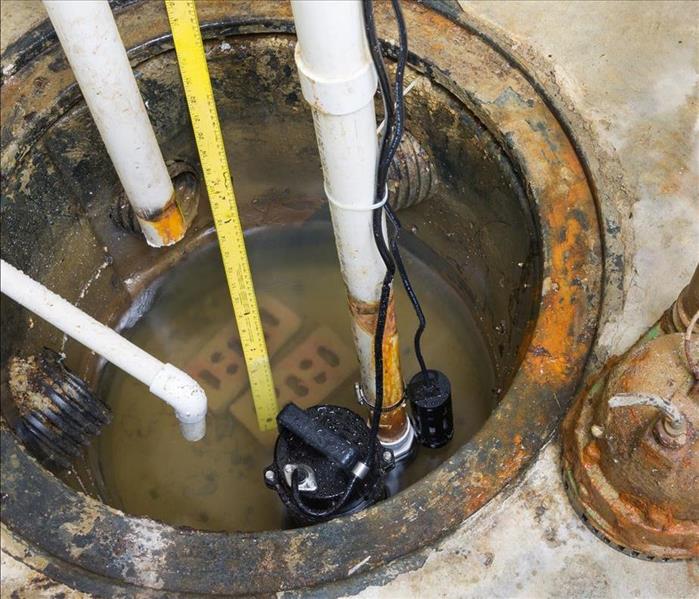 A flooded basement is a problem that you need to remedy quickly.
A flooded basement is a problem that you need to remedy quickly.
4 Steps To Pump Water Out of a Basement
Whether you are the victim of a storm or broken pipe, a basement flood is always a source of trouble. Once the source is remedied, you need to pump out the water quickly. While you can hire a water remediation company to do this task, it could take a few days before they reach you if the flooding is widespread. The good news is you can do this task by yourself. While it is not very difficult, there are a few steps you need to follow to do it correctly.
1. Ready the Area
Wait until the source is remedied. If there is standing water around your home in Seattle, WA, don't start pumping yet. When it's time to pump, make sure you turn the electricity off. Be sure to remove children and pets from the basement as well.
2. Pump Out the Water
If your basement flood is severe, lower a sump pump into the deepest part with a rope. If you only have a few inches of water, don rubber boots and place the pump in the deepest spot. Once you set the pump up, plug it into a generator. It should start pumping water out immediately. You can speed up the process by using multiple pumps. After the water level starts to dwindle, turn off the pumps.
3. Shop-Vac Small Puddles
When the basement flood has been reduced to less than an inch, use a shop-vac to clear up the puddles. These machines suck up the water and pump it into a four- or five-gallon tank. When the tank is filled, you carry it outside and dump it out. Therefore, you want to wait until the water level is low to use this tool.
4. Dry Out Porous Items
If the source is listed under your homeowner's policy, your insurance coverage will pay to replace your porous items. This includes drywall and carpeting. Another option is to hire a company to dry the items.
A flooded basement is a problem that you need to remedy quickly. Follow these steps to pump all of the water out of your basement.
The Best Techniques for Preventing Mold Spread in Your Building
5/7/2020 (Permalink)
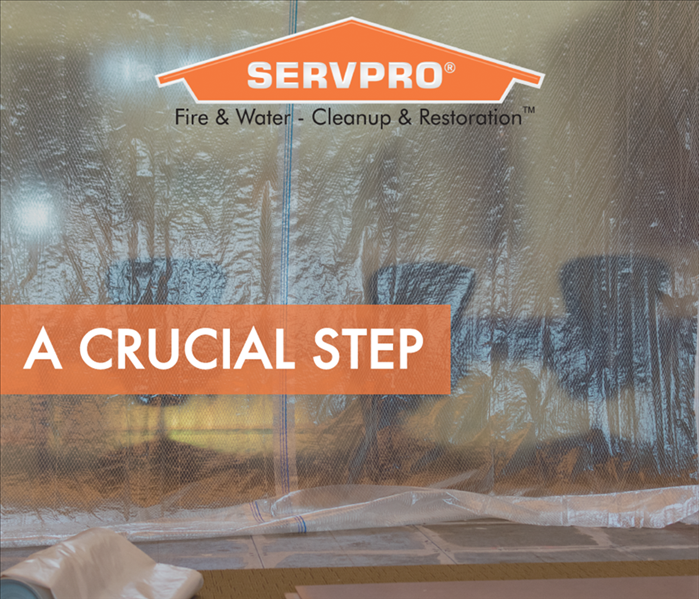 Containment is the isolation of the work areas to prevent cross contamination of clean, unaffected areas of the building structure
Containment is the isolation of the work areas to prevent cross contamination of clean, unaffected areas of the building structure
The last thing you want to do when you discover a problem such as back mold is to make it worse. A good principle with mold is to keep it contained in one area as this will make mold removal faster and easier. To do this, it helps to understand a little bit about how mold spreads throughout a building. All types of mold are made up of microscopic scores that float on the tiniest of breezes. They also like warm, damp locations, such as moist attics and basements, bathrooms, and sometimes laundry areas. There are hundreds of different types of mold, and though they might require slightly different cleaning approaches, most types spread in a similar manner.
The Importance of Air Ducts
One avenue of spreading for black mold is your HVAC system. Once the mold spores are in the furnace ducts, they can easily spread throughout the building. Every time the heating or cooling is turned on, more spores are carried to all corners of the building. The drifting spores will likely only take hold in those areas that have high humidity. One of the first actions a qualified mold remediation company will take is to turn off the furnace. The following measures should be taken to facilitate mold containment:
- Physical barriers
- Negative air pressure chambers
- Air filtration
- HEPA vacuums
Steps to clean ducts will also be taken by technicians. Once the mold is contained, the process can move onto mold removal and restoration.
The Value of Professional Testing
Testing for mold can tell you the extent of your mold problem, as well as if you have black mold or a different strain of fungus. It could be necessary to test after the restoration process is complete, to determine if mold is still present or if it has returned. Store-bought mold kits sometimes show confusing positives, since most buildings are likely to have some mold present. A certified mold tester is better able to decipher the results of a test.
Tips on Conducting a Fire Drill at the Office
3/30/2020 (Permalink)
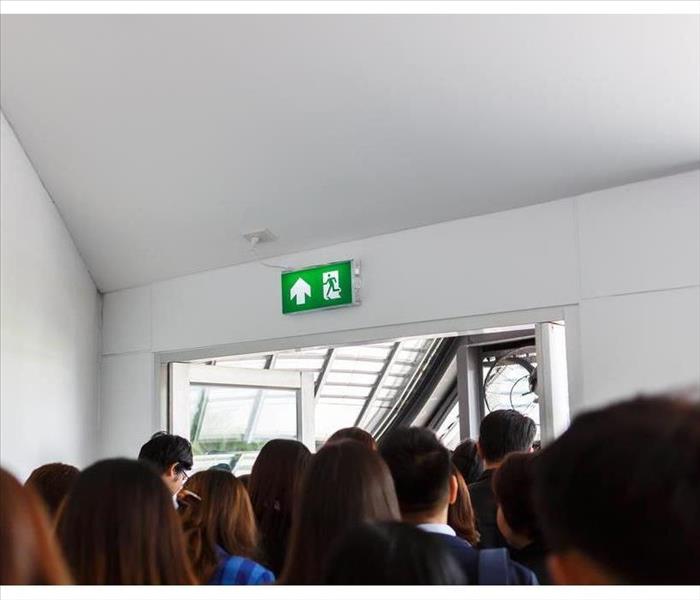 Practicing a fire drill can help keep everyone safe during a fire or storm
Practicing a fire drill can help keep everyone safe during a fire or storm
One of the best ways to protect your employees and facility in Greenlake, WA, when an emergency arises is adequate preparation. If you design and practice a plan with all staff members, it will help keep them safe. Conducting a fire drill also identifies any problems that need to be remedied, such as blocked exits or faulty alarms.
Prepare Your Emergency Evacuation Plan
Before conducting a drill, you need to create a comprehensive written plan with the help of an assigned safety team. Your plan should include several important considerations:
Assign a person to account for each employee. Depending on the size of your company, you may need several people to fulfill this role, including a backup person in case one of the others is absent.
Designate the preferred exit routes for employees. If your company is large, you may have different exits for different departments. It is important to stress that if the alarm sounds, choose the closest exit even if it isn’t the designated one.
Decide how to alert all employees about the drill, such as using an alarm system, paging system or other means of communication. Make sure the system you choose is accessible to all employees.
Conduct the Drill
Before conducting the fire drill, have training sessions with all employees to go over the exit routes, the meeting place outside and the person to whom they report.
Always alert your local fire department before you pull an alarm so they are aware of the drill.
Once the alarm is activated, start a timer. Have each designated person accountable for their group. Once everyone is accounted for outside, stop the timer and assess how long the drill took.
Assess the Results
Review the results of the drill with your safety team to identify any weaknesses in the plan. Continue to practice until you are satisfied with the response time.
Preparing an emergency plan, communicating it to employees and practicing a fire drill can help keep everyone safe during a fire or storm. If an unexpected event does occur, contact a commercial cleanup and restoration service to quickly get the business back to normal.
An Unnoticed Water Leak Could Cost Your Business Thousands
1/27/2020 (Permalink)
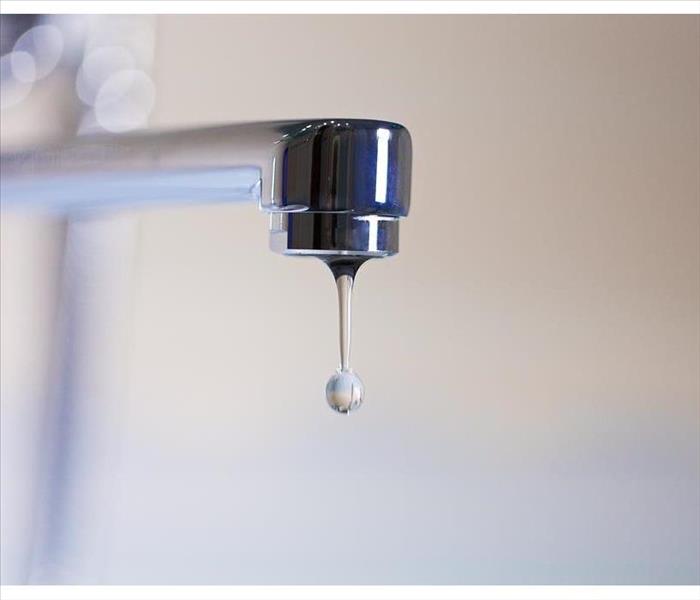 Even a small drip can lead to a large loss of water over time
Even a small drip can lead to a large loss of water over time
An Unnoticed Water Leak Could Cost Your Business Thousands
Every year many businesses are affected by water leaks that have long gone unnoticed. A leak can not only cause a significant amount of damage to your building and its contents, but it can also skyrocket your water bill. The drip … drip … drip of a water leak seems harmless enough, but multiply those drips and they can become a giant problem. It’s a good idea to regularly inspect and identify spots where water leaks are most likely to occur.
1. Leaky Toilets
Commercial buildings typically have several toilets. You can see and hear many toilet leaks, but sometimes they aren’t visible or audible. In most cases, a sure indicator would be your water meter, but toilet leaks tend to be slow. If you can determine that your water use has dramatically risen, a malfunctioning toilet isn’t probably the culprit.
2. Leaky Faucets
Even a small drip can lead to a large loss of water over time. If you have one faucet that drips one drop per second, approximately five gallons of water would be wasted every day. That’s over 2,000 gallons each year. Fortunately, most leaky faucets are easy to repair and usually involve the replacement of washers.
3. Leaky Underground Pipes
If water main pipes spring a leak on your side of the meter, you'll be responsible for paying the bill. The water bill may be the only indication that there’s a water leak. You won’t know that there’s a possibly even a pipe break until you receive your monthly water bill unless you monitor your water consumption weekly. Talk to your provider and see what they can do in terms of weekly monitoring until the problem is resolved.
4. Leaky Plumbing
Pipes are located throughout buildings. So, leaks can occur behind walls, above ceilings, and under flooring. Sometimes the only way you realize that there’s a leak is noticing wet drywall, discolored ceiling tiles, mold or smelling a musty odor.
If your Haller Beach, WA, commercial building sustains water damage from a water leak, be sure to hire restoration professionals. They'll return it to its preloss condition as soon as possible.
The Role Insurance Agents Play in Your Cleanup Efforts
1/22/2020 (Permalink)
 Contact both of these professionals immediately after you learn of a disaster in your office
Contact both of these professionals immediately after you learn of a disaster in your office
You run a business, so you understand that takes many key components to efficiently operate an organization or system. If you experience a catastrophe at work, the right pieces need to be in place so you can rebuild and avoid long-term interruptions to your daily operations. Filing an insurance claim is one of the most critical steps. It works hand in hand with hiring the right professionals in Ballard, WA, to restore your building.
In the Immediate Aftermath
If you discover any damage in the office from fire, smoke, water or mold, you can't wait a moment to start the remediation process. Getting professionals involved in the cleanup effort will help ensure a smoother and more efficient process. Follow these steps after a disaster:
- Get everyone safely out of the building and away from harm.
- Contact the proper authorities to stop the source of the damage.
- Contact a certified disaster response team to evaluate the incident and make a restoration plan.
- Contact your agent to file an insurance claim.
How the Insurance Company Works With the Cleanup Company
Before initiating the cleanup and rebuild procedures, you need to file a damage claim with your provider. The insurance agent will want to know how the disaster occurred, how severe the damage is and what intervention is needed to restore your office. These steps are critical in helping the agent know what the insurance will pay for and in processing the claim quickly. The agent will use a claims inventory system to track the claim and make sure everything is organized. The agent will use this from the time you report the incident until the crew from SERVPRO completes the cleanup and restoration.
It will give you peace of mind knowing your needs are in good hands when you pair a reliable emergency cleanup company with your insurance provider. Contact both of these professionals immediately after you learn of a disaster in your office.
How To Prepare Your Business for a Snowstorm
1/6/2020 (Permalink)
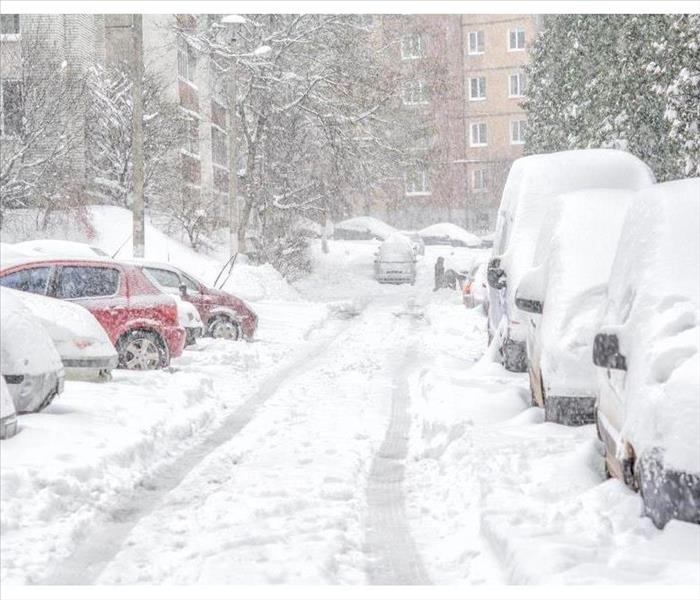 Snowstorm in Ballard, WA
Snowstorm in Ballard, WA
Simple Ways To Prepare for an Upcoming Snowstorm
The winter season brings frigid temperatures, high winds, and severe weather. If your business in Ballard, WA, is gearing up for a big winter storm, it’s crucial to ensure that you’re properly prepared for the event. Equipping your business for inclement weather can boost your reputation and prevent you from losing customers. Here are some simple ways to prepare for an upcoming snowstorm.
Form a Plan
To keep your business running smoothly during a winter storm, you need to know exactly what to do once the snow hits. Be sure to keep the following factors in mind while you form your plan:
- Emergency supply kit
- A safe place to store important documents
- Arrangements for professional snow removal
By taking each of these steps, you can provide your business with an extra layer of security. Make sure that you consider all the possible threats you may face during a storm to keep yourself safe under any circumstances.
Communicate Effectively
A good plan can only be successful if you communicate it to your employees before the snowstorm. Make sure that all of your contact information is accurate and up to date, and send out an email to all of your workers that clearly illustrates your emergency plan. In addition, confirm that you have a way to notify customers of any updates so that they know what to expect during the storm.
Check for Existing Problems
A winter storm can have many devastating effects on your business. If there are any problems in your building that haven’t yet been addressed, they can become even more vulnerable to the bad weather. Make sure you thoroughly inspect your property for any existing issues, such as a pipe burst or a damaged HVAC system, and resolve them before the storm hits.
Preparing for a snowstorm is crucial to the safety of your business. If you happen to run into any problems despite your best efforts, be sure to contact commercial building restoration services as soon as possible.
What Happens to Your Building in a Partial Loss After a Fire
12/29/2019 (Permalink)
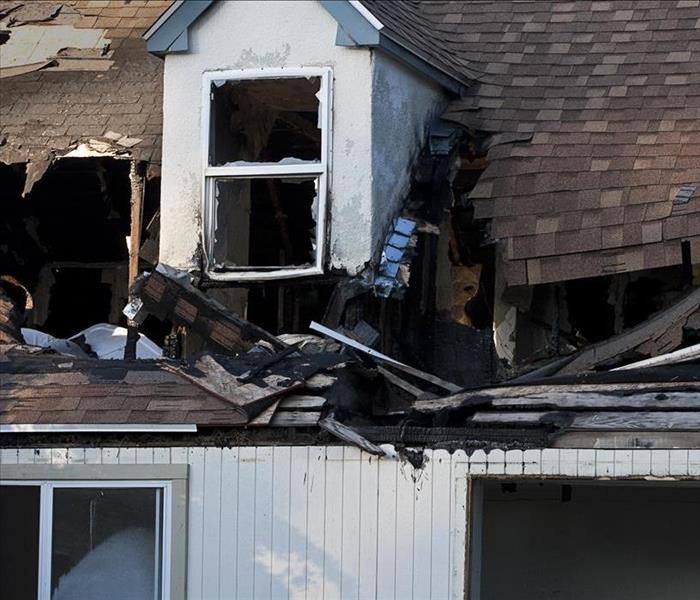 Partial fire loss on a roof in a building
Partial fire loss on a roof in a building
Structure fires come in all sizes. They can inflict damages in wide ranges as well. Even if a fire doesn't appear to cause visible problems, there could be hidden issues in your Greenlake ,WA, building. While a total loss insurance claim would mean the complete destruction of your office, a partial loss is also common. A fire loss can be difficult to detect on your own. It's important to let a professional inspect the entire area for problems.
Where Issues Can Hide
Some types of smoke damage are easy to spot. Soot and ash can cover floors, furniture, electronics and documents. However, when there is partial loss in the building, the problems will show up in some of the following areas:
- Air ducts in the heating and air conditioning system
- Roof integrity
- Inside walls
- Window frames
Inspecting the Roof
A certified professional will check for smoke, fire and water damage on the roof. Shingles or outside layers may appear fine, but the wood underneath can be wet due to water the firefighters put down to extinguish the fire. This can lead to mold growth. Excess heat from the fire may even make the roof weak and may be at risk of collapsing.
Air System
The need for fire restoration may not be evident in some areas of your building. Professional smoke and fire cleanup teams will inspect the ventilation system in the facility for soot buildup. Left undetected, this could compromise the air quality in the office.
Looking at the Siding
Regardless of the type of your building's exterior, a partial loss can affect this area as well. Aluminum siding can melt under extreme heat, and stucco can crack. The building's foundation is prone to damage too.
A fire loss can affect many parts of your workplace. Even if you don't easily spot problematic areas, you should call a professional to look for damage.
Keys to Being a Good Landlord
12/20/2019 (Permalink)
 Being a landlord in Seattle, WA, requires a lot of work
Being a landlord in Seattle, WA, requires a lot of work
How To Be a Terrific Landlord
Being a landlord in Seattle, WA, requires a lot of work. You need to find good tenants, and make sure that everything is in good working order. It's also important to make sure you are doing what you can to be a good landlord. Things include things like making sure the plumbing is in good working order, as well as taking complaints seriously. Here are some landlord tips for how to be a terrific landlord.
Communication
Just about any relationship depends on good communication. This is true for the landlord and tenant relationship. When a tenant contacts you about an issue with their plumbing, be sure to respond in a timely manner. Let them know when it can be fixed, and when they can expect the repair person to be there. You also need to communicate with issues regarding:
- Late rent
- Complaints about neighbors
- Infestation issues
These are all issues that should be addressed and handled as quickly as possible.
Remember Safety
As the landlord, it is your job to make sure your tenants are safe. Everything needs to be up to code, from the electricity to your commercial plumbing. After a storm, have professional storm restoration experts come and fix the damage as soon as you can. Ensure that everyone has proper plumbing, such as running water, and that smoke detectors are working properly.
Schedule Regular Maintenance
Regular maintenance can prevent big repairs later. Things like replacing HVAC filters, smoke detector batteries, and cleaning fireplaces can ensure safety and keep things in good working order. Be sure to communicate the times when you are having these things worked on so that your tenant isn't inconvenienced. This will also give your tenant the opportunity to make sure their space is clean, and that animals are put away on the day the worker is coming.
These landlord tips can all help ensure that your tenants are happy and that you are doing everything you can as a landlord. This can help keep a positive landlord and tenant relationship.
3 Steps for Minimizing Flood Damage After a Kitchen Sink Leak
12/11/2019 (Permalink)
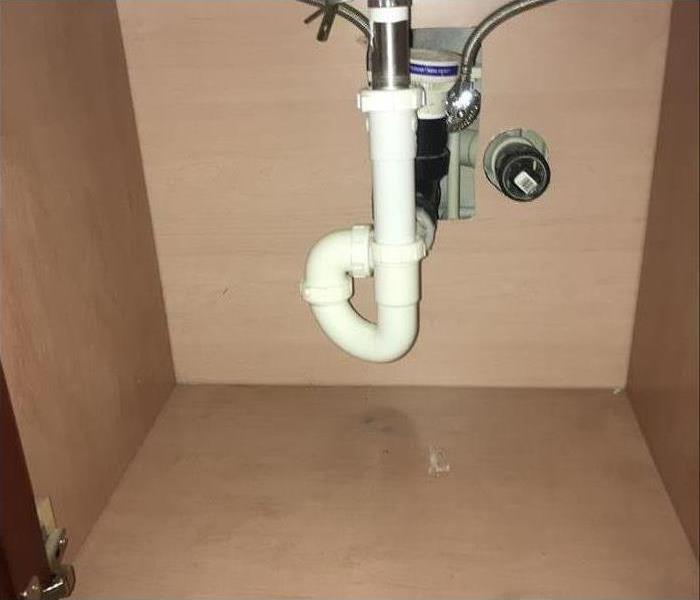 Kitchen sink leak in Broadview, WA
Kitchen sink leak in Broadview, WA
Three Basic Steps When Dealing With Water Cleanup After a Kitchen Sink Leak
If you have experienced flooding in your kitchen due to a leaky sink, you should act quickly to minimize further water damage. The longer you ignore a water issue, the more destruction that is likely to result. Follow these three basic steps when dealing with water cleanup after your kitchen sink leaks.
Turn Off the Water Supply
Once you realize you have a leak, the first step is to shut off the supply of water. Locate the shut-off valve for the sink. This is usually located in the cabinet below the sink. Some sinks have two valves; one valve is for hot water, the other is for cold. Turn both valves clockwise until the water supply is blocked off. When shutting off the water to your kitchen sink, keep the following in mind:
Always Close Valves By Hand
Turning your water on or off with pliers or other tools can overtighten and damage the valve.
If your kitchen sink does not have a local shut-off valve built into the pipe, water can always be shut off at your home's main water line.
Contact Your Insurance Provider
Now that the water in the home is safely turned off, you should get in touch with your insurance provider. Whether you have homeowner’s insurance or renter’s insurance, reporting a flooding incident right away is critical for filing a successful claim. You may be asked to submit pictures or a written statement about the incident to receive funds for repairs.
Work With a Restoration Crew
As you wait out the process of filing an insurance claim, don't hesitate to move forward with hiring a local flood damage restoration crew in Broadview, WA. Your kitchen repair should begin with a full sanitation and evaluation of the area. The cleanup team will ensure the safe removal and restoration of items ruined by water. Be sure to act promptly in order to minimize damage caused by flooding.
Certification Standards for a Remediation Company
11/27/2019 (Permalink)
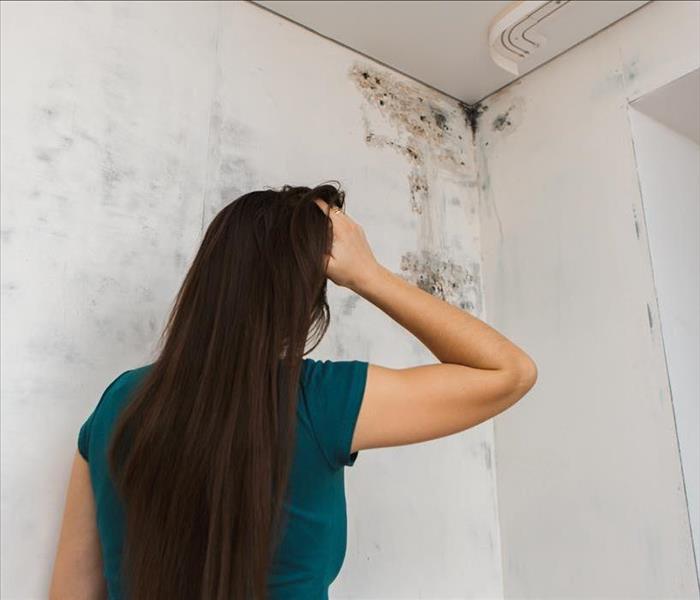 Mold found in a Broadview, WA
Mold found in a Broadview, WA
When you encounter mold in your home in Broadview, WA, it's a cause for concern. You want to take care of the problem but know that not all companies will do an equally effective job. This is where standards can be helpful for your search. Look for a certified mold company that has the experience and the knowledge to clean your home safely and completely. The Institute of Inspection Cleaning and Restoration Certification is among the most prominent professional groups that develop standards for mold cleanup. The group works to establish the right protocols for the inspection and evaluation of properties suspected of containing mold. These standards have been developed through a rigorous process involving a large group of stakeholders.
Why Mold Certification Matters
Mold is a complex organism and should be handled by a worker with mold certification. It consists of microscopic spores that grow well in a humid environment. A certified mold cleaning company will follow a process that includes the following critical steps:
- Inspection and assessment
- Containment of mold
- Treatment of the source of moisture
- A process of cleaning and sanitizing
- Treatment of affected structures and contents
- Restoration
A certified mold remediation company will have the training and equipment necessary to clean your home. Look for a remediation team that follows IICRC standards.
Why Mold Should Be Cleaned From a Home
Mold contains irritants and allergens that can compromise the health of your family and your pets. It can also cause a musty odor to be present in the home. The visual affects of mold are also unpleasant and can affect the property value of a home. The mere presence of mold growing in a home also indicates there is excess moisture and high humidity present, so it is smart to identify the source of this moisture. A certified mold technician can locate the presence of moisture and safely clean your home. A professional can also clean the contents in your home that have been tainted by mold.
FAQs About Solar Panels and Storms
11/13/2019 (Permalink)
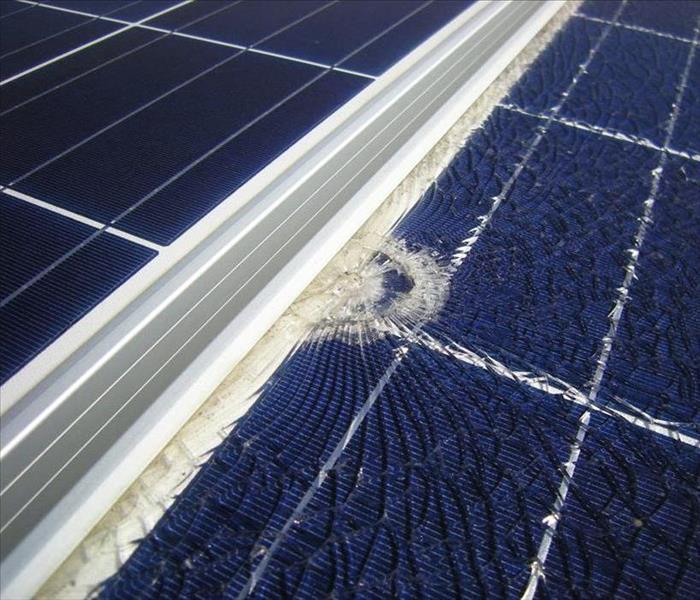 Broken solar panel in a North Beach, WA home
Broken solar panel in a North Beach, WA home
FAQs About Solar Panels and Storms
The use of solar panels is becoming increasingly popular for homeowners in North Beach, WA. However, many homeowners are unsure about panel damage that may occur during a storm. If you have or are considering installing panels, it can be useful to know what they can withstand during a storm.
What Are Common Types of Damage to Panels?
Panels are often more durable than traditional roofing options. However, panels may still sustain damage in a storm, and this can ultimately result in damage to your home. Homeowners whose houses have sustained storm damage may find it helpful to contact emergency restoration services. Common types of damage from a storm may include:
- Leaks as a result of long-term water damage
- Scratches from large tree limbs, which can limit the amount of energy panels can take in and put out
- Malfunctions due to a lightning strike
Can Panels Handle Hail?
For many homeowners, hail is a common concern when it comes to panel damage. However, the majority of solar panels made today are constructed to withstand the impact of hail. In general, repeated strikes in the same spot are necessary for hail to damage a panel. If you live in an area that is prone to hailstorms, it can be useful to research the strength of several different types of panels prior to purchase and installation.
How Can You Prevent Damage to Your Panels?
Although you can't prevent a storm, there are steps you can take to reduce the likelihood of roof damage with your panels. Strategically placing a lightning rod on the top of your house, in an area that isn't touching or covering the panels, can help to redirect a lightning strike, which can ultimately prevent damage. Additionally, cutting dead limbs and trimming healthy tree limbs can reduce the chance of damage to your panels.
Panel damage can be a costly and frustrating issue to deal with after a storm occurs. However, knowing the types of damage that may occur to your panels during a storm, what panels can withstand and how to prevent damage to your panels can help you to prepare for the effects of a storm.
Flood Insurance Requirements for Businesses
10/24/2019 (Permalink)
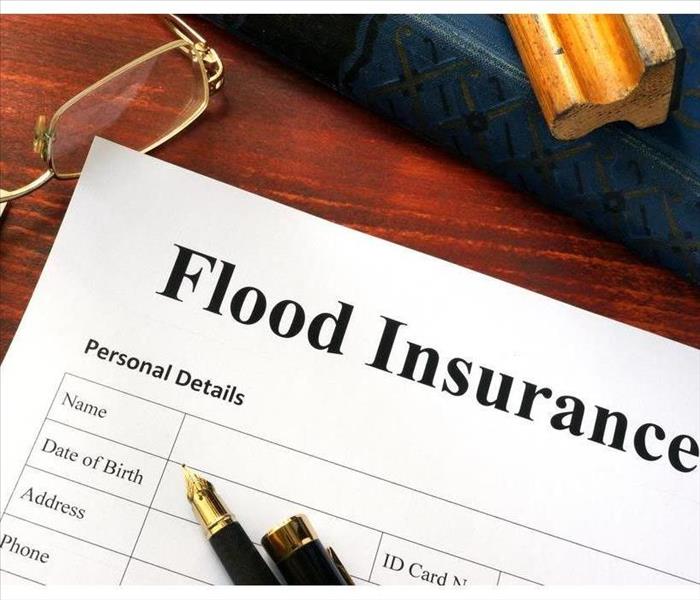 The storm surge of a hurricane, an overflowing river and spring runoff are all flood insurance events
The storm surge of a hurricane, an overflowing river and spring runoff are all flood insurance events
Flood Insurance Requirements for Businesses
The next time you get together with a group of business acquaintances, casually ask for some advice about flood insurance. You may be surprised at how many different answers you get. You will learn that some:
- Have it but don’t understand it;
- Have heard of it but don’t have it; or
- Have never heard of it.
Some Floods Require Separate Insurance
Floodwater that comes inside from an outside source requires a separate policy. The storm surge of a hurricane, an overflowing river and spring runoff are all flood insurance events. This policy is different from a commercial insurance policy which would address water damage from a plumbing flood.
You Should Determine If the Business Is in a Flood Zone
Some places are more susceptible to floods than others. If your business is located along a river or near the shore, the business is probably in a flood zone. Even if it isn’t, it’s a good idea to find out for sure from the City Engineering Department.
Federal Lenders Don’t Take Unnecessary Risks
In many cases, businesses encounter problems and file for bankruptcy. Bankruptcy leaves creditors, including the mortgage lenders, with a loss. The risk is greater than average when the business is in a flood zone. Therefore, federally regulated and insured lenders require their business customers to have a separate policy for floods. This policy guarantees reimbursement when a flood occurs.
Other Parties Might Require a Separate Flood Policy
Nobody likes to lose money in a disaster. Depending on the organization of the business, there may be other parties who might require a separate insurance policy. They are:
- Lessors who own equipment leased to the business;
- Vendors or customers who own inventory stored on the property; and
- Mortgage lenders or other creditors not covered by the federal government requirement.
Recovery Starts After the Water Recedes
The approval of the flood insurance claim marks the beginning of the recovery. There are flood disaster recovery specialists located in the Ballard, WA, area who are ready to start work. They are a phone call away.
How and Why To Flush Your Water Heater
10/16/2019 (Permalink)
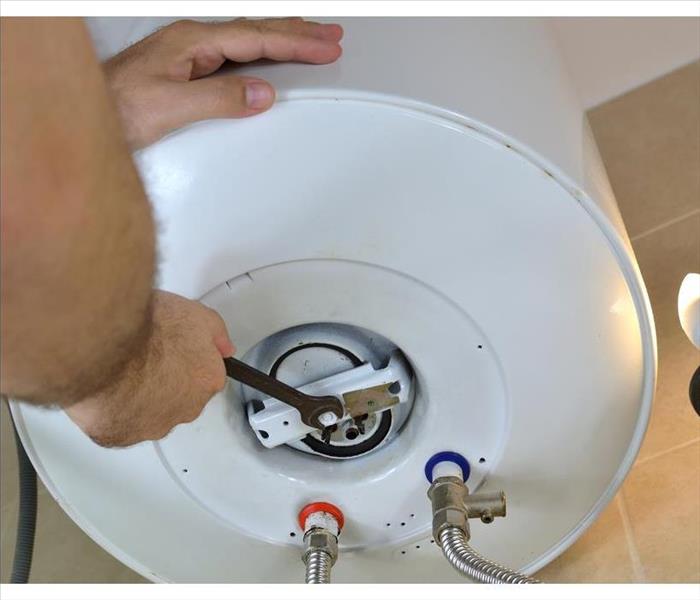 Flushing a water heater in Wallingford, WA
Flushing a water heater in Wallingford, WA
As a homeowner in Wallingford, WA, you can save a lot of time and money on water damage repair simply by practicing preventative maintenance on some of your vital systems. Hot water is something that nobody wants to go without, so don't leave your hot water heaters out. All it needs is a flush every now and then to clear the sediments out of the tank.
Preparation
To prepare for your water heater flush, you'll want to begin by gathering some supplies. You don't need much, and you should already have everything required around the house:
- Work gloves
- Garden Hose
- Screwdriver
After putting on your gloves, turn off the heater itself. Then you can attach the hose to the drain valve. Make sure to place the other end of the hose near a drain or somewhere that you don't mind water and sediment accumulating, like outside.
Draining
Next, open the drain valve and let the water run for a few minutes. To help the water along, turn on the hot water faucet in your kitchen. After another couple minutes, turn off the water supply valve until the flow of water stops. To be thorough and give it one more rinse, turn on the water supply valve one more time for a couple of minutes, and turn it off again.
Filling
Now that everything is flushed out of the heater, you can fill it back up again. Close the drain valve and turn the water supply line back on. Keep an eye on the faucet in the kitchen. You'll know the tank is full when the water coming out of the faucet is smooth and steady- that means all the air has been pushed out. Once the tank is full, you can turn the heater back on. Don't forget to turn off the faucet at the end!
You water heater is an important part of your home. To give it a good, long life you should flush it out regularly to avoid damage or malfunctions, or total replacement. It isn't hard to integrate regular flushing into your home maintenance routine.
Basics to Include in a Fire Escape Plan
10/13/2019 (Permalink)
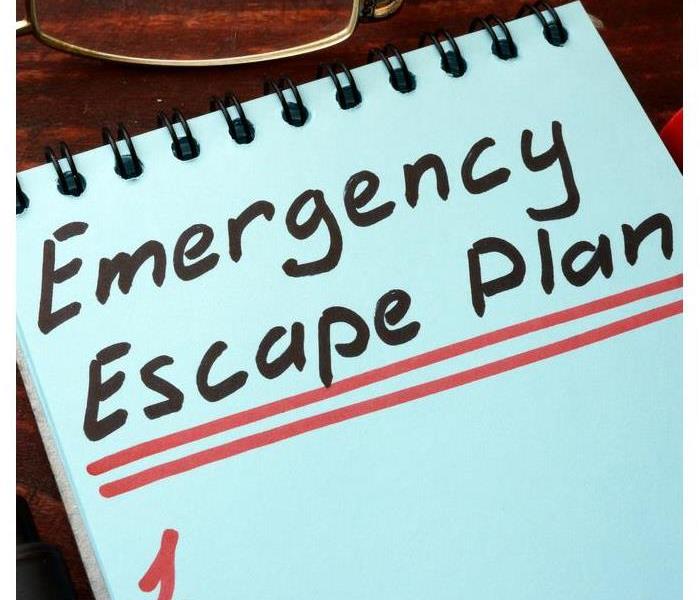 A fire escape plan ensures that everyone understands what to do and where to go
A fire escape plan ensures that everyone understands what to do and where to go
While smoke detectors are imperative for alerting you and your family in Greenlake ,WA, of a home fire, what happens next is key to safely getting out of the home. A fire escape plan ensures that everyone understands what to do and where to go. After developing a plan, it is important to practice it and discuss it regularly.
Steps for Developing a Plan
Fires spread quickly. If one happens, you need peace of mind that every person in the home knows exactly what to do. As a family, making a fire preparation plan should involve the following:
Inspect home for potential escape routes and exits. Consider creating a floor plan with those exits, as well as discussing the best ones depending on the location a person is located during the fire. The best route should be the safest and fastest.
Once routes have been established, keep them clear and ensure openings to the outdoors work properly.
Have an open discussion on what to do during the fire. Everyone should stay low while heading to their escape route and close doors behind then to maintain the fire.
While belongings are important, they aren’t as important as life. Ensure everyone understands that getting out safely is the one and only priority.
Determine a meeting place outside the home that is far enough from the fire but clearly visible.
Maintain and memorize a list of emergency contacts.
Once safely out, stay way from the fire. Let emergency responders do what they need to.
Maintaining the Plan
Having a plan is important, but it will only work if people know it. It is recommended to test the plan twice a year. Practicing is also a good way to ensure that everyone clearly hears what the alarm will sound like. If someone is not able to hear at as well, assign a person to be in charge of waking them in case of a real emergency. Additionally, when you have guests, especially ones staying overnight, be sure to share the fire escape plan with them.
While we all hope a fire doesn’t happen, having a fire escape can help ensure everyone’s safety. Instead of worrying about belongings, get everyone out safely and leave the fire damage to the professionals.
5 Tips for Maintaining Your Building's Sprinkler System
9/30/2019 (Permalink)
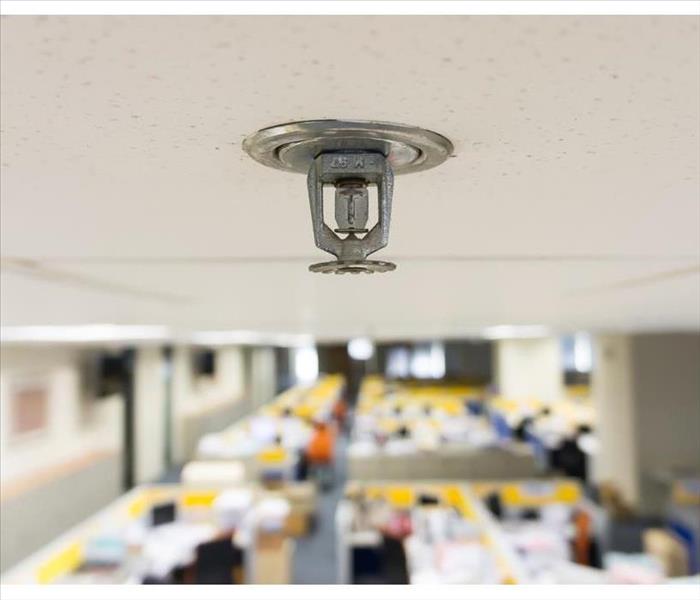 Inspect once a year your fire sprinkler system
Inspect once a year your fire sprinkler system
5 Tips for Getting the Most Out of Your Sprinkler System
Your building's fire sprinklers are equipment you hope you never have to use. In the unlikely event that fire breaks out at your commercial property in Seattle, WA, however, you'll be thankful that you performed regular sprinkler maintenance. Here are five tips for getting the most out of your sprinkler system.
1. Get an annual checkup. Once a year, your sprinkler system should be inspected by a qualified technician. In addition to evaluating the system's overall condition and testing the main drain, he or she will look at each of the system's parts individually.
Additionally, you should have the interior of your system evaluated every five years. The technician will look for blockages that could impair function. These may be due to rocks, rust, or other debris.
2. Give it space. Keep at least 18 inches of empty space between your sprinkler system and other objects.
3. When the seasons change, check the fire caps. These are the caps on the fire department connections found on the exterior of your building, so named because they're how the fire department will connect with your property to boost your sprinkler system during a fire. Regular sprinkler maintenance should include ensuring that they are present, aren't broken, haven't fallen off, and aren't full of debris.
4. If you see something, say something. If Josh in HR won't stop hanging his dry cleaning from the sprinkler system and you notice damage, have the unit inspected promptly. Injured sprinkler heads can activate when they're not supposed to or, even worse, they may fail to activate when you need them.
5. Always check the sprinklers before new tenants move in. Different businesses and industries require different sprinkler systems. In order to maximize building safety and maintain your system's integrity, it's important to make sure your system can provide sufficient coverage and suppression in the event of a fire.
At best, malfunctioning fire sprinklers can lead to some soggy paperwork or even a call to your local water mitigation company. At worst, they can endanger the well-being of your building's inhabitants. Regular sprinkler maintenance can significantly increase your odds of keeping everything — and everyone — safe and dry.
When Is a Flood Cut Needed?
9/13/2019 (Permalink)
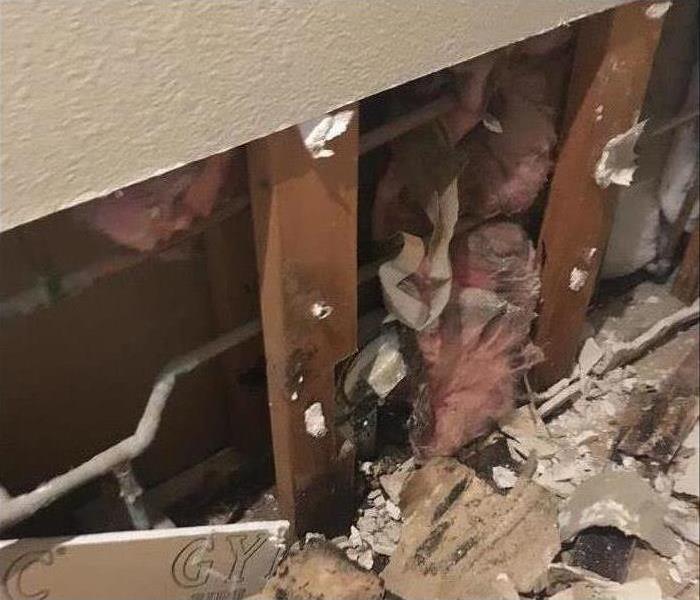 If your home is damaged by flooding, the best bet is to use a flood cut
If your home is damaged by flooding, the best bet is to use a flood cut
When your home in Fremont, WA has water damage, the cleanup process is typically fairly easy. If the damage was caused by flooding, it unfortunately brings a few extra woes. As opposed to a pipe leak with clean water, flood waters can easily pick up extra bacteria and contaminants along its path.
Purpose of a Flood Cut
Since water wicks its way up, the visible damage seen at a few inches could actually have traveled a few feet up a wall. A flood cut allows for the assessment of damage further up the wall. Typically 12 to 18 inches above the visible damage, this cut can help determine how far the water has moved up as well as any other damage.
Are Flood Cuts Always Necessary?
Most professional mediation experts try to tear out as little drywall as possible. For clean water leaks, only the visibly damaged area may need to be removed to prevent further moisture damage. Unfortunately, flood waters require extra care, which will likely mean a flood cut for three main reasons:
After flooding, there is a good chance of contamination. Sewage, chemicals and other bacteria can easily picked up in the flowing waters.
The excess water that has likely worked its way up the walls can create a welcoming environment for mold growth. Even though it may not be visible, the moisture and organic materials in drywall and other materials create the nourishment the fungus needs to flourish.
Behind the drywall in many homes is insulation, which can’t be properly dried. If left as is, it will no longer provide its designated insulated properties.
If your home is damaged by flooding, the best bet is to use a flood cut. This will help you determine how much of the material needs to be removed, as well as will help the area dry out better. Luckily, helps is available that is Faster to any size disaster to resolve the residual flood issues.
Why Your Business Needs Fire Insurance
8/30/2019 (Permalink)
 If you are unsure as to what kind of coverage your business has, contact your insurance company to review your policy
If you are unsure as to what kind of coverage your business has, contact your insurance company to review your policy
Importance Of Having Fire Insurance For Your Building
No matter how many precautions you take, commercial fires can still happen in Ballard, WA. With so many appliances and wiring, office buildings can be very susceptible to sparks, which can lead to bigger problems. Many business owners don't think about fire insurance when they secure their policy or don't want to pay the extra cost, but there are many reasons why this is so important.
Restoration Can Be Expensive
The clean up process can be extremely pricey. Items that have been damaged need to be replaced or repaired, and smoke cleanup can be difficult to handle. If you have fire sprinklers, you may incur water damage costs as well. Paying out of pocket for this can be detrimental for many companies. It is vital that your policy covers the cost of hiring a professional fire restoration company to come take care of the problem.
Your Business May Have to Close
In the event that the building structure is unstable or the office has suffered extreme damage, you may have to close your business for weeks or even months. This will likely cost your company thousands of dollars and can even lead to bankruptcy. While many policies don't offer this kind of coverage with regular fire insurance, most companies have an option for you to add it on.
You May Not Have Enough Coverage
While keeping your premium down can save you quite a bit of money each month, it can really cost you later on if you have underestimated the value of your business. Before you decide how much your business is worth, take the time to carefully tally all items in the building and have a professional appraise the building itself.
If you are unsure as to what kind of coverage your business has, contact your insurance company to review your policy. Remember that fire insurance may not cover all damages that your business may incur, so ask what kind of add-ons might be right for you.
Deductible Storm Damage
8/30/2019 (Permalink)
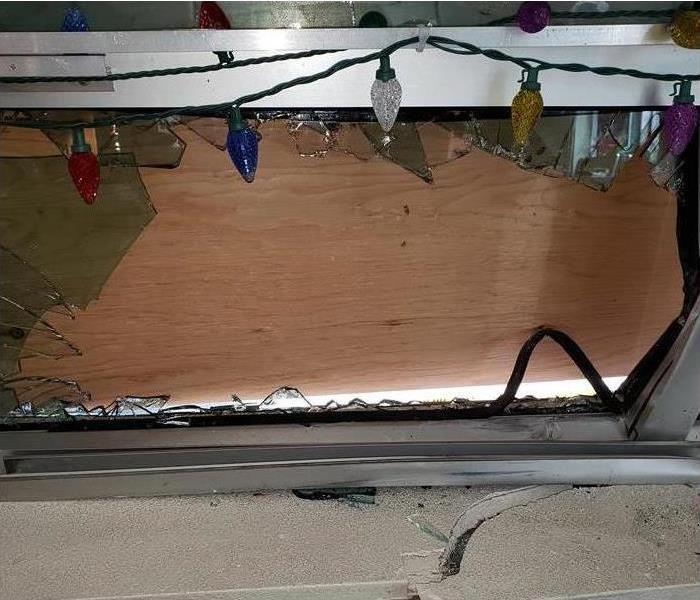 Commercial storm damage in Haller Beach, WA
Commercial storm damage in Haller Beach, WA
Deductible Storm Damage
While most businesses have commercial insurance policies, the coverage received after making a claim may not be enough to mitigate all expenses. Therefore, when a company incurs extensive storm damage, owners might be wondering what is tax deductible and what is not. Thankfully, as long as an owner makes a claim on their commercial policy, they can claim the rest of their financial losses on their taxes. However, when it comes to specific deductions, there are at least four types.
1. Restoration Work
Storm restoration specialists in the Haller Beach, WA, area are necessary, but their services may not be cheap. While a commercial policy may cover a significant portion of the property's restoration, the rest will need to be paid out-of-pocket by the property owner. However, this out-of-pocket expense can likely be deducted from a business's taxes come year-end.
2. Water Damage
Water damage is a common problem after a storm. There can be leaks that develop in the roofline or even around windows and doorways. While this type of storm damage is common, and many commercial policies cover certain losses caused by it, there are instances where commercial plans won't kick in. For example, if there is a flood. Thankfully, if your commercial policy does not kick in, you might be able to deduct the expenses.
3. Wind Damage
Wind damage typically results in roof damage, but it can wreak havoc on landscaping and glass. Many commercial policies cover this type of loss because of the universality of it. However, depending on your deductible with your insurer, your coverage may not be enough, requiring extra relief through tax deductions.
4. Other
There are other instances where your insurer may not provide coverage, but the affected area is included in on a presidential declaration of a national emergency. When this happens, you can use the declaration as a way to get tax relief when it is time to file.
Storm damage can present a significant expense to businesses and commercial property owners. Thankfully, you can find some relief in tax deduction at year-end. Therefore, don't hesitate to hire and ask for help in breathing life back into your operations.
The Best Ways To Banish Smoke Odor
7/16/2019 (Permalink)
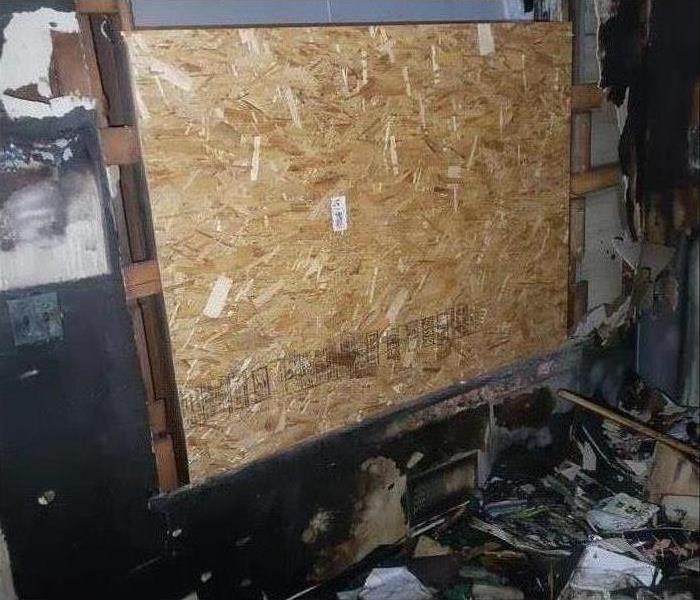 Odor removal after residential fire
Odor removal after residential fire
How to Get Rid of Smoke Odor
Smoke odor lingers long after cigarette smoke has been eliminated from indoor environments. The secret to a successful home deodorization treatment is that this process involves several stages of cleaning. Here are the best ways to get rid of every trace of smoke odor at a residence in Greenlake ,WA.
Filter the Air
Attempts to eliminate odors may have limited success without first filtering smelly particles out of interior air. Ask restoration professionals about the best filtration method for capturing very small particles. Here are a few of the most effective air filtration mechanisms for smoke:
- True HEPA air filter
- Air scrubber
- HVAC attachment
Smoke cleanup specialists select a filtration technology based on severity of the smoke odor. Filtering the air is only the first step toward home deodorization.
Clean and Renew Surfaces
You may detect smoke odors as long as residues remain on surfaces. Experts may recommend the use of some or all of the following treatments to eliminate traces of tar and other chemical compounds in cigarette smoke:
- Dry chemical sponge
- Wet cleaning solvents
- Anti-staining primer
Depending on the extent of smoke buildup, it may be possible to simply wipe down surfaces with a chemical sponge, which is made out of natural rubber. Other treatments may be necessary for severe cases. If repainting is necessary, an anti-staining primer can prevent stains from resurfacing through fresh paint.
Neutralize Odors
Experts recommend deodorization only after all filtering smoke particles out of the air and cleaning surface residue. Quick and effective ozone treatments and fogging require temporary evacuation, while slower hydroxyl or vapor modification methods can go on while occupants remain at home.
If you want to get rid of stubborn smoke odors, look for damage restoration experts who specialize in home deodorization in Greenlake ,WA. Within a matter of days, the smell of cigarette smoke can be gone for good.
5 Steps to Conducting an Emergency Drill
7/12/2019 (Permalink)
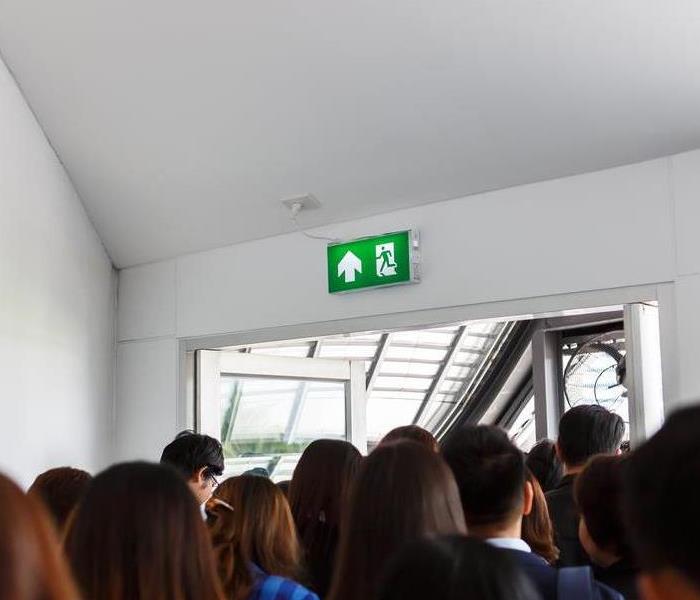
Is your workplace in Seattle, WA prepared for an emergency evacuation? It is important for all buildings to have an evacuation plan in place and that all workers are well-versed on its contents. The Occupational Safety and Health Administration (OSHA) provides thorough guidance on how to effectively plan for an evacuation and how to run a successful fire drill. The following are the five major steps in the process.
1. Plan Development and Training
Ensure that a written emergency action plan has been developed and that employees are trained on the plan's contents and procedures. Ensure the plan includes the phone number for commercial building restoration services as well.
2. Scheduling and Notification
With the plan in place and training complete, it is time to plan the drill. Coordinate with local authorities to schedule the date and time of the exercise. Authorities will often help run the drill and provide insights afterward. This notification step is critical in the event that building alarms are wired to automatically alert the local fire department in order to prevent falsely triggering a response.
3. Fire Drill Execution
On the designated date and time, activate your building’s alarm system. Observe employees as they evacuate and take note of whether established procedures are being followed. Also note any issues that may arise.
4. Debriefing
Shortly after the drill, gather key individuals (management, local authorities and/or employees) together to discuss what was observed during the exercise. What went right? What needs improvement? Take note of any action items that result from the discussion.
5. The Follow-Up
Be sure to follow through on any corrective actions that need to occur based on the debriefing. Revisit the written plan and make any changes that have been identified.
It is crucial to run the occasional fire drill to practice evacuation procedures before a crisis occurs. In the event of an emergency, workers will be better prepared to respond quickly and efficiently. It may even save a life. Visit https://www.SERVPROseattlenorthwest.com/ for more information on commercial disaster restoration.
What To Know About Furnace Maintenance
7/10/2019 (Permalink)
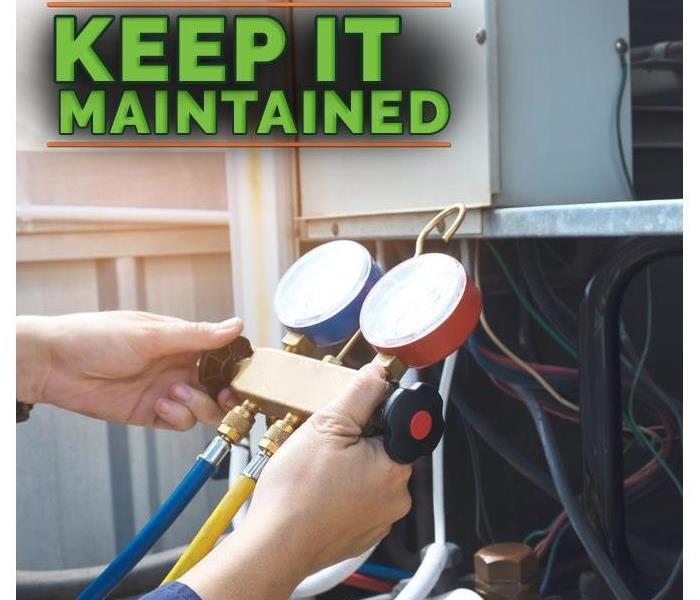 Properly maintaining your furnace may help to prevent a costly accident or a fire cleaning down the road.
Properly maintaining your furnace may help to prevent a costly accident or a fire cleaning down the road.
Properly maintaining your furnace in your Seattle home may be able to help you prevent a costly accident, and the need for fire cleaning afterward. Fortunately, there are some easy maintenance steps that can be taken with most furnaces.
Steps You Can Take
If your furnace seems to be malfunctioning there are several things that could be wrong. Some of the most basic causes are things you can check for yourself.
• A fuse may be blown, or a circuit tripped causing the unit to lose power
• The thermostat may have been turned off
• The power switch may have been turned off
• On gas units, the pilot light may be out
When to Call a Professional
Calling a professional can not only help ensure that the furnace is serviced by someone familiar with it’s unit type, but may help you prevent the necessity of a fire cleaning down the road. If you are unsure what the problem is, or find a fuse blown on several occasions, it is best to call a professional for repair. If you smell gas then quickly exit your home and call your gas company or fire department. Do not try to turn on any lights or turn the gas off yourself.
If You Do Experience Problems
Unfortunately, sometimes fire or smoke damage can occur from a furnace. In events like these a fire damage and restoration professional may be able to help with any smoke cleaning and repairs your home may need. At that time, you may want to have your furnace repaired or replaced by a professional as well.
You can follow some basic steps to keep an eye on your furnace's maintenance needs. While some may be things you can do yourself, others should be done by a professional familiar with the furnace type. If the furnace does malfunction then a restoration and fire cleaning professional may be able to help with your home’s needs.
How To Prepare for a Fire at Home
7/5/2019 (Permalink)
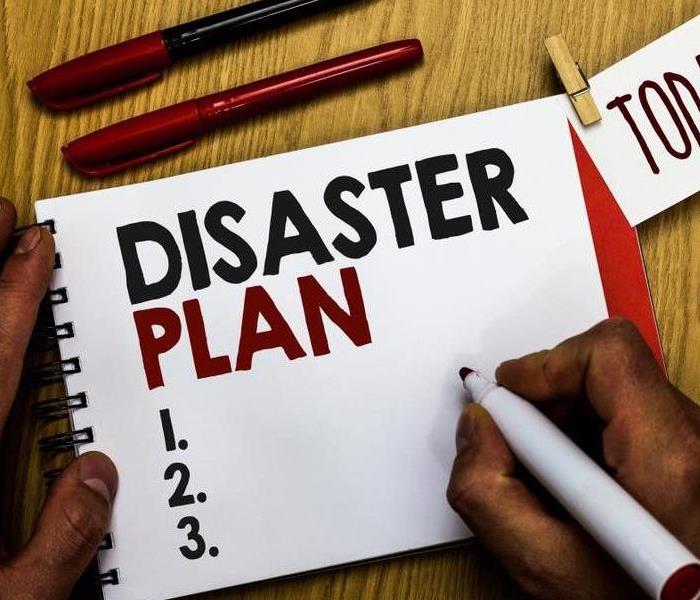 Do you have a fire escape plan ready?
Do you have a fire escape plan ready?
It’s often important to prepare for an emergency in your home in Seattle, WA and having a fire escape plan can help keep you and your family safe. There are several ways in which you can prepare yourself for a fire in your home.
1. Take Preventative Steps
Having tools in place that can alert you to a fire quickly can be a key part of preparing for a fire. It can sometimes be helpful to test your fire alarm to ensure you and others in your home know what the alarm sounds like. Additionally, you should make sure to replace the batteries in your smoke alarm at least once yearly and replace your alarm once every ten years.
2. Know How To Escape
A key part of emergency preparation involves creating a plan to escape your house. While you hopefully will never have to use your fire escape plan, having a plan in place saves you the time of having to decide how to escape. Often, it’s best to have multiple routes of escape in case you are unable to enter a certain area. Consistently practicing your emergency escape plan will make it quicker and easier to escape if the need arises.
3. Plan a Meeting Place
In addition to knowing how to get out of your home quickly if needed, it’s also often wise to plan a place for you and your family to meet once you are all out of the house. It can be helpful to choose a place that is a safe distance from your home, such as a neighbor’s mailbox, to meet. With everyone agreeing to meet at one place, you will easily be able to see who is out of the house, and you will be able to provide emergency responders with accurate information.
Having a fire escape plan can help you and others in your home feel prepared in the event of a fire. If your home has been damaged by a fire, you might find it helpful to work with fire restoration experts. Visit https://www.SERVPROseattlenorthwest.com/ for more information on fire damage restoration services.
What To Do When a Fire Hits Your Business
7/3/2019 (Permalink)
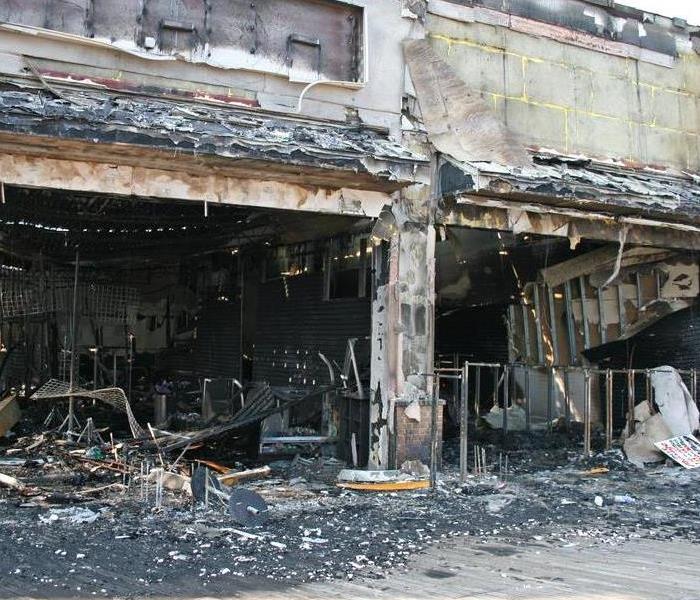 Commercial fire damage restoration services are available through SERVPRO of Seattle Northwest.
Commercial fire damage restoration services are available through SERVPRO of Seattle Northwest.
Managing a business through fire restoration in [City, State], requires clear thinking and knowledge of the task ahead. Following these three steps can help your business return to top shape as efficiently as possible.
1. Keep the Property Secure
Keeping yourself and others safe is a top priority when handling a commercial fire. To prevent trespassing and vandalism, consider boarding up the property or installing a fence around the area. This can keep your business secure as you schedule damage assessment and smoke cleaning services. If you have to return to the area, make sure to touch the damaged property as little as possible.
2. Call Your Fire Insurance Agent
Because you will be supplying information to your insurance agent and a fire restoration service, it is important to stay organized. Keep track of contracts, calls, damage photos and other forms of documentation.
If you think the insurance company’s assessment of the damage is inaccurate, you may want to hire a public adjuster or other intermediary. Because these professionals work for business owners, not insurance companies, they may be able to negotiate a claim more favorable to your business.
3. Determine the Value of Lost Property
In order to secure a payout from an insurance agency, owners need to know how much damage the fire caused to their assets. An expected payout depends on which kind of policy the owner has opted to use:
• If the policy covers Actual Cash Value (ACV), the business owner will need to take depreciation into account.
• If the owner has a policy that covers replacement cost, the agency will cover repairing or replacing the original assets.
In either case, an accurate record of how much the building, technology and other assets cost are necessary to file a claim.
Keeping this checklist in mind when dealing with fire restoration can take some of the stress out of the process. Fires can cause severe damage, but staying organized and working with your insurance agent give you a good chance of success after a disaster. Visit https://www.SERVPROseattlenorthwest.com/ for more information on fire damage.
Insurance Can Protect Your Assets From Fire Damage
7/3/2019 (Permalink)
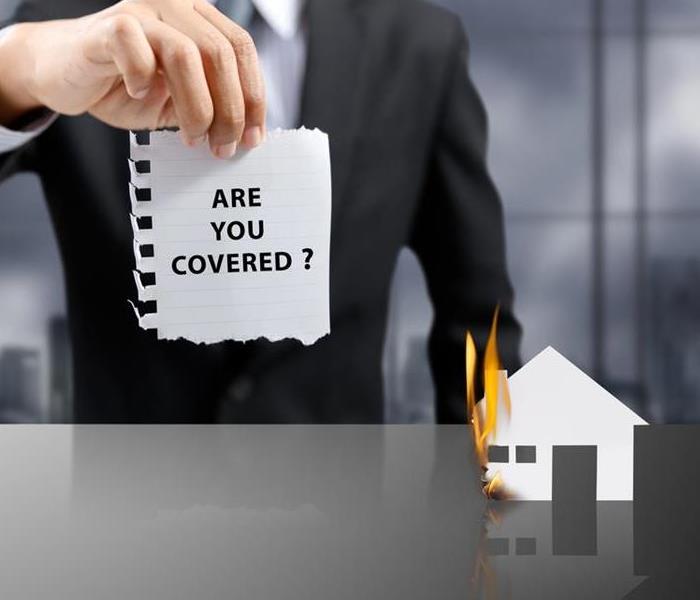 It is important to check your coverage with your insurance adjuster.
It is important to check your coverage with your insurance adjuster.
One of the most important things you can purchase for your business in Seattle, WA is a commercial insurance policy. To ensure you get the right coverage for your needs, know what is valuable to your company and how fire can impact your premiums.
Include All of Your Valuables
Identify all of your corporate assets before sitting down with an agent. Make a list of items that have a high cost to replace or are critical to guaranteeing that your business functions on a daily basis. This list will help you determine what you need to have covered.
Important business assets should consist of those things that can be impacted by natural disasters as well as criminal activities, including ice and hail storms, mold or water contamination, auto theft or vandalism, and major events such as hurricane and fire damage. Make sure to have commercial insurance for big and small assets:
• Manufacturing equipment, delivery trucks, fleet vehicles and other big-ticket items
• Your main corporate office space and exterior buildings, such as warehouses, storage facilities, equipment sheds and security offices
• Inventory and its packaging, including products, boxes, packing materials and shipping containers
• Major office equipment such as phone systems, hard drives, computer systems and copy machines
Understand How the Potential for Fire Damage Can Affect Your Policy
One of the biggest factors that impacts insurance costs is how much fire damage your facility could sustain. Location is a primary concern — being in a city that is easily accessible to firefighters and fire restoration companies is better than being in a remote location. Being close to fire hydrants and a fire station will bring your premiums down. An old, all-wood building is considered less safe, and therefore more expensive, than an office in a newer facility constructed with fire resistant materials. Generally speaking, an office building is cheaper to insure than a building that houses hazardous materials and areas, such as gas stations and commercial kitchens.
When getting a commercial insurance policy in Seattle, WA be sure to count all of your assets against losses including fire damage and other catastrophes. It's also wise to take into consideration how your building's location, construction, and contents may impact your premiums.
 If you suspect a leak in your toilet, contact a plumber to remove the toilet and see if they need to replace the flooring and subfloor around it
If you suspect a leak in your toilet, contact a plumber to remove the toilet and see if they need to replace the flooring and subfloor around it




 24/7 Emergency Service
24/7 Emergency Service








































































